Boat Profile

Eco 5 Power Cat
A catamaran for cozy cruising
From Issue Small Boats Annual 2017 March 2016
W as it time for another boat? In the 1980s, it was a 16′ sailing dinghy that awakened my wife Barbara and me to the beach-cruising pleasures of the San Juan Islands in Washington’s Puget Sound. In the ’90s, it was a 19′ lug-rigged double-ender for oar, sail, and outboard that extended cruising to Desolation Sound. Then came a 20′ catamaran, sporting a wing mast with square-topped mainsail, that got us inside a comfortable cabin while offering exciting sailing in moderate conditions. But as years went by, sitting out in the weather and hauling sheets took its toll. Sailing was exciting when the wind was up, but boring in light summer winds. Why bother with sailing if we could motor at 10 knots? Was it time for a gasser?
And so it was, and we decided upon the Eco 5 Power Cat by Bernd Kohler in France. Its narrow hulls, wave-piercing bows, space-age profile, and three-tone color scheme really made it a looker. At 5.5 meters, it was about the same size and accommodation as our 6-meter sailing cat, and still trailerable behind our compact SUV. The twin 5-hp outboards specified in the plans were to drive the EcoCat at an economical 10 knots and spin it around in circles. Having them mounted on the transoms should eliminate weed pickup, as well as the between-hull wave buildup working against a centrally mounted outboard. I ordered plans, and the digital files came quickly via email.
The plywood-on-frame EcoCat is simply built, using chines sprung around widely spaced bulkheads. I opened the DXF files on an older Mac Cube still running Drawing Board CAD from Ashlar Vellum. With CAD, I made some design changes for a bit more cabin headroom, bigger windows, storage lockers forward, and extended cockpit sides complementing the cabin profile.
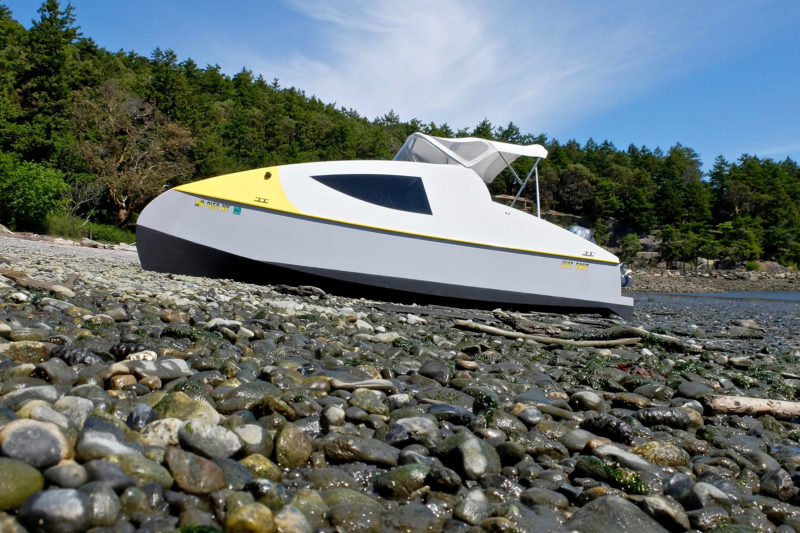
The Eco Cat rests comfortably on the cobbles between tides. There’s room aboard for an inflatable kayak when a dinghy is required if the Cat’s at anchor.
Once I had the design tuned to suit our needs, I nested parts for economical use of plywood sheets, created a tool path for the ShopBot CNC router I’d used for our rowing-shell kit business, and quickly cut out the parts from 6mm plywood. It sounds complicated, but it’s actually similar to laying out parts by hand—but with parts cut far more accurately, with beautiful, fair, and smooth curves everywhere. I milled clear Sitka spruce to dimension, scarfed it to full lengths, rounded edges, and precoated everything with epoxy. This self-made “kit” made for very fast building.
The building jig had only one temporary form; all other forms were bulkheads that remained with the hulls. The hulls were built upside down, planked, and even finish-coated with graphite-infused epoxy—later I’d paint above the waterline. The 6mm planking was patterned on the hull, as the actual faired shape may be a bit different from a CAD plate expansion, then glued in place and trimmed. The hull and side-panel sections were joined with butt blocks that added stiffness in way of the temporary bulkhead. After I flipped the hulls upright and aligned them, I fit the deck—scarfed 12mm plywood. The cabin sides and top were built up with two layers of 4mm ply. It took just four months for me to complete the construction of the hulls and cabin.
The partially finished boat looked great, and I decided to spend the big money for a two-part paint sprayed on by a professional, thinking it would be done quickly. Wrong. It was another six weeks before the boat was back for outfitting. The plans showed a windscreen here, a galley there, a steering wheel, and twin outboards—but no details. It was just another challenge to work through.

The two small outboards were a good fit for the twin hulls, but didn’t provide adequate power.
Remote steering and motor controls for twin outboards is very routine for a monohull, but not for tiny twin 5-hp outboards on a catamaran! Time to improvise. A tiller bar, supported on nylon bushings, was hidden in the cross beam with a mechanical steering cable connected to the dash-mounted steering wheel. What a challenge it was just to have twin motors on a little catamaran.
Another professional I hired designed an excellent canvas dodger, back panel, and semi-rigid windscreen that really complemented the design. Barbara and I could now cruise, completely protected from wind and rain, sitting in comfortable captain’s chairs. The 6′ x 8′ cockpit is our living room at anchor, doubling the EcoCat’s enclosed space. A Yeti cooler, good for five days, stays in the cockpit as a table or extra seat. An Origo two-burner alcohol stove eliminated complicated propane systems. We use a lightweight 32-amp-hour starting battery, not for the pull-cord-start outboards, but for powering LED lighting and an iPad for music and charts with the Navionics app. We only need the instruments powered up while we’re under way, so the outboards’ 6-amp charging outlets supply power directly to the instruments and charge the battery at the same time. No shore power is needed. Simple systems for a simple boat—its name, JUST ENUF, serves the cat well!
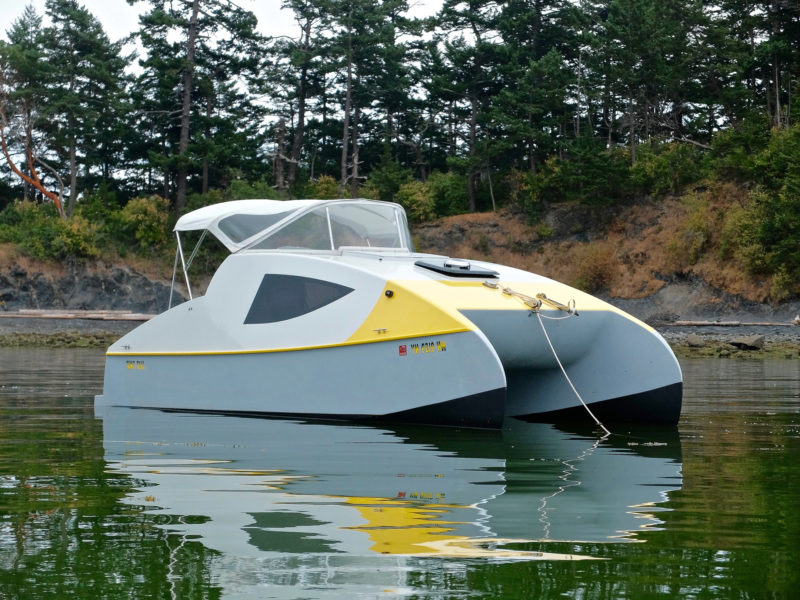
The Cat’s shallow draft and twin hulls open up options for anchoring in shallow coves. If the bottom is even and not too rocky, grounding out during a midnight low tide isn’t a problem.
D uring the boat’s first season we took a two-week cruise to British Columbia’s Broughton Islands. The cruise covered hundreds of miles, and we alternated between being the only boat in a secluded cove and being surrounded by the warm hospitality of wilderness float marinas. A comfortable 80-mile range and top speed of 10 knots allowed us to do plenty of exploring without concern for time or fuel. The EcoCat is comfortable in sea conditions of 2′ short, steep chop and can confidently deal with far rougher conditions.
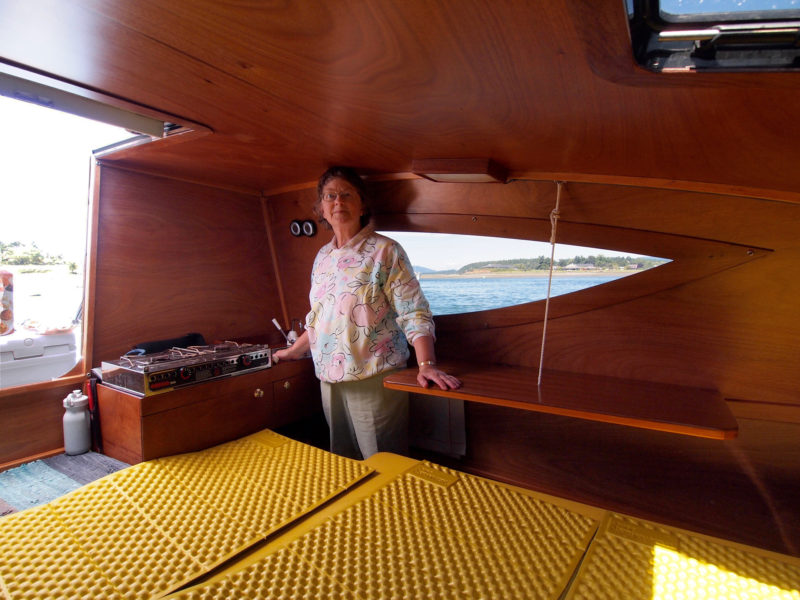
Having the lines of the Eco Cat in CAD files simplifies making alterations like raising the cabin roof to provide standing headroom.
This 8′-wide catamaran offers the stability and seakeeping of a far larger boat. There’s never a problem grabbing for a hot pan when another boat, zipping by to look at JUST ENUF, leaves its wake for us. There is plenty of room with a hanging locker and two cuddies for each person. Sleeping bags with integrated mattresses make a very comfortable double. When bags are folded over during the day, the large padded bridge deck area is very comfortable for sitting, cooking, and just hanging out. The starboard hull has a cushioned canoe seat atop the porta-potti. Just forward is hull storage for an inflatable kayak or two folding bikes and other bulky gear. The port hull has standing headroom at the sink and sit-down room for meal preparation with a flip-down table for dining.
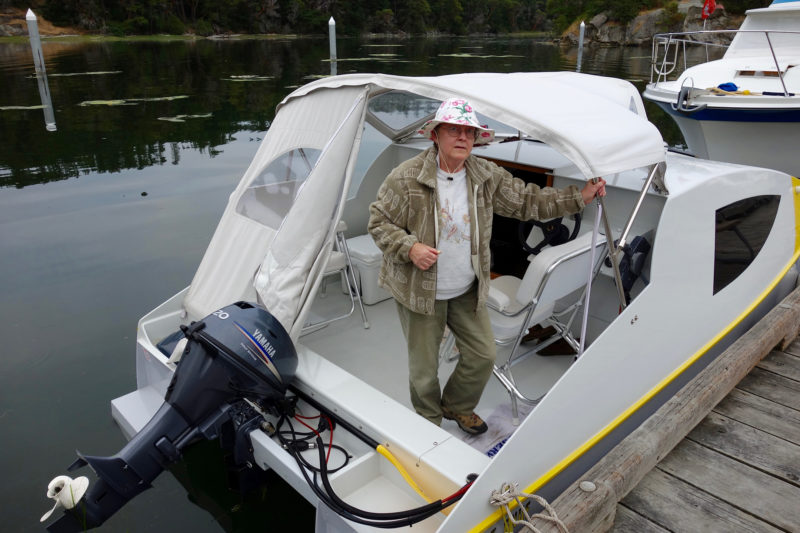
A single 20-hp outboard can outperform twin 5-hp outboards. Just behind the motor’s shaft you can see one of the extensions added to the hulls to improve the trim with the greater motor weight. The custom-made canopy doubles the Cat’s sheltered space.
The twin 5-hp outboards proved to be not enough power. They had no top-speed potential, pull-cord starting, and were noisy, especially with the steering linkage rattling between them. Worse, the tiny props had so little bite that docking maneuvers were a constant challenge. A repower with a single Yamaha 20-hp outboard yielded a 10-knot cruising speed, 15-knot top speed, and the same fuel economy as the twin 5s: 1 gallon per hour at any speed. Electric start, 6-amp charging capability, and a lightweight battery competed the package. A 1′ extension added to the stern of each hull helped offset the additional weight of the larger motor and its under-deck 12-gallon fuel tank. Docking was no longer embarrassing, and we could now talk while running 10 knots. The rougher the water got, the faster and smoother we would go. Life was good.
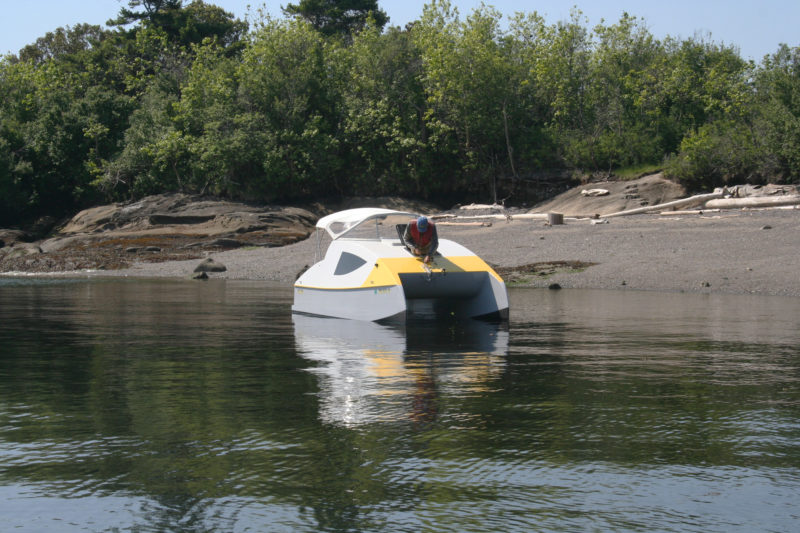
A hatch in the foredeck provides access to the bow for anchoring.
But as most of the weight was still aft with either engine arrangement, the EcoCat still squatted underway. One day, Mike Snook—experienced with super-large, high-speed Australian catamarans—suggested transom wedges and end plates as the cure. A 1″ x 4″ wedge was added like a trim tab to the each stern with skeg-like end plates added in line with the sides of the hull to contain the flow. The cat’s tracking was better, even with the previous centerline skegs removed. Trim was now level with clean entry and a very smooth exit. After a prop change, we had the same top speed with cruise speed reduced by 400 rpm for a noticeably quieter boat.
Outboards are designed to mount behind a transom with only the prop exposed below the hull. When centrally mounted on a catamaran, all of the lower unit below the bridge deck is exposed to bow wave convergence with lots of unwanted spray and, perhaps, added drag. We had tried several ideas on previous sailing catamaran but solved the problem on the EcoCat with a hull-mounted streamlined fairing that lets the motor think it’s on a transom.
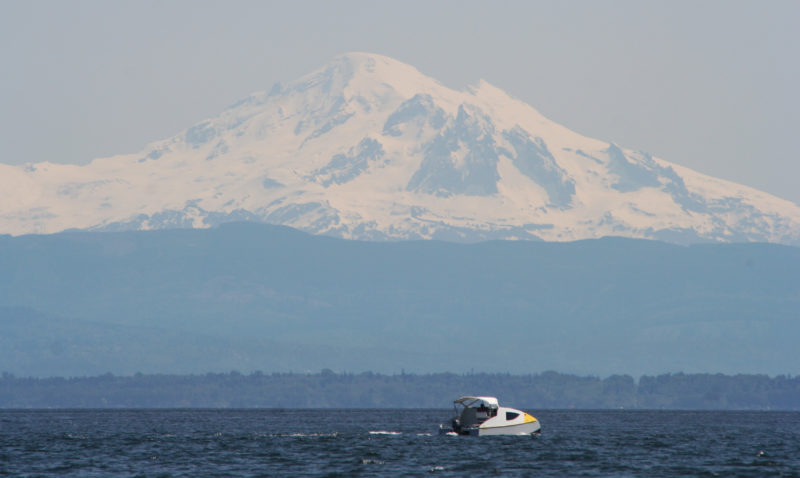
The EcoCat is quite at home in the broad reaches of Puget Sound that lie in the shadow of Mount Baker.
T he 10-knot cruise speed for our typical three-day, 50-mile round-trips lets us enjoy island life and not lose one day getting somewhere and another getting back. That’s the advantage of a gasser. It’s all about the destination, hanging out, enjoying a nice hike, being in a special place, especially for my wife Barbara and me. My solo trips continue to range farther and wider in all weather conditions.
Ron Mueller continues to design and build small boats and still rows most days in Bellingham, Washington. He started whitewater kayaking in the late ’60s, sailing in mid ’80s, and rowing in the ’90s when he founded Wayland Marine. Ron designed and built the Merry Wherry kits and was the Northwest dealer for Alden Ocean Shells and Echo Rowing until retiring in 2010.
Eco Cat Particulars
LOA/ 18′ (5.50m) Beam/8′ 2.4″ (2.50m) Draft/8.7″ (0.22m) Weight/606 lbs (275 kg) Capacity/1350 lbs (620 kg) Power/15–20 hp Construction/Approx. 400 hours
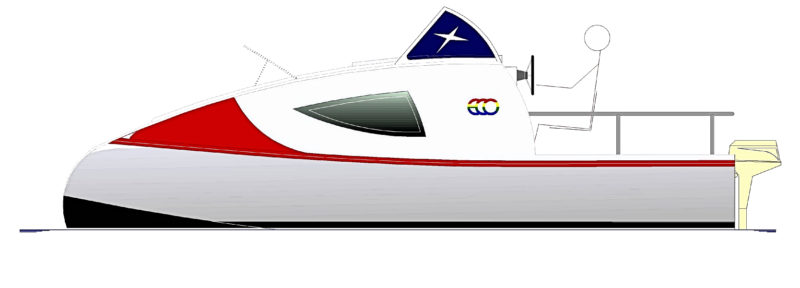
Plans for the EcoCat , with a digital manual and 16 pages of drawings as BMP or DFX files, come from Bernd Kohler at K-designs . A kit is also available.
Is there a boat you’d like to know more about? Have you built one that you think other Small Boats Monthly readers would enjoy? Please email us!
Share this article
Join The Conversation
We welcome your comments about this article. If you’d like to include a photo or a video with your comment, please email the file or link.
Comments (27)
I would really like to see a drawing of the modifications mentioned in the text. It sounds like the end product was significantly different from the original design.
Tim, JUST ENUF is built exactly to the furnished plans. Obvious additions were the cockpit sides and transom extensions when repowering. Plans are furnished as DXF files which may be printed out for “manual parts layout” or modified in CAD for CNC cutting. I hope this helps.
Form definitely follows function on your well built boat. The 20-hp outboard was a great idea and so were all of the modifications to get everything right.
Pete, thanks for your kind thoughts. Looking forward to seeing you on a Salish Sea beach soon!
I really enjoyed the article in the March issue of Small Boats Monthly about Ron Mueller’s JUST ENUF. Ron’s boat never fails to draw all kinds of attention when he’s pulled out on the beach or running with a group of other boats up here in the north Puget Sound, and looking carefully at his superlative build, one can easily see why. Though I am somewhat of a “traditionalist” at present, this boat looks like it could very well be in my build list sooner rather than later!
I love seeing articles from other Salish Sea folk. The photo with Mount Baker (Komo Kulshan is the name given to it long ago by the Lummi people) in the background is part of my life.
Vince, twins seem desirable but two 8.5-hp motors would use noticeably more fuel then a single 17-hp motor. Remote control would lend itself to a autopilot but complicated. Remember that each catamaran hull has a different turning radius in a turn. My previous sailing Jarcat had rudders set up with Ackerman steering (like a car). That’s probably not really needed for outboards. Just a thought.
I like the look of this craft. What would be the result if you went to twin 8.5-hp outboards which have the electric start and hardware to do twin rigs with remote control? Still the design appears to have a lot going for it. Enjoy it!
I’m just wondering if the deadrise at the end of each original hull was maintained on the 1′ extensions and if so, how the trim tabs were installed.
Mike, deadrise was just flowed out. The trim tabs are a solid wedge at the end of the hull about 4″ long and 1″ thick. An end plate (in line with hull side) contains the water flow for greater effect. The end plate is a skeg-like shape about 12″ by 4″ that provides better tracking than the original skegs on the keel centerline.
Most of the changes Ron made to the design—the hull extensions and other modifications—are incorporated in the plans. There are many ECO’s sailing world wide and it is my policy to update the plans to improve my designs. That applies not only for my ECO line of boats, but the others as well. By the way, I leveled out the deadrise of the extension to 0°.
Do the plans show the unique assembly method in case a builder wanted to have the parts CNC cut? Is the interior of the cabin also coated with epoxy?
Most parts were pre-coated and sanded (at least one side) prior to assembly. The plans are DXF files for display and would need to be, at least, nested for a CNC tool path prior to cutting. After importing to a CAD program, I added an inch in cabin height. Enlarged the windows, laid out cubby holes in the forward bulkhead and designed the cockpit sides with the same curvature used for the cabin. This is a real timesaver and provides great accuracy when having symmetrical parts and provides very smooth curves. The planking and cabin top is best (and easily) laid out directly on existing structure rather then CNC cutting. The construction was completed in just four months while attending to my normal business of selling rowing shells and making kits of same. Painting and canvas was “sent out” and fitting out was, at least, another month.
Thank you very much.
What is the contraption mounted on the forward hatch?
It’s a Nicro Solar Vent Fan. It runs mostly 24/7 as long as its self-contained battery is charged. There is enough leakage through the companionway hatch to keep the cabin dry during winter storage and summer nights when we’re sleeping aboard. We usually slide the main hatch open an inch or two at night (the dodger protects it from rain), and latch the foredeck vent hatch open rather the use the fan. Although fans may be quiet at first, they do develop a bit of noise after a few years.
I did some measuring. I wouldn’t have the ceiling height to flip the hulls over. Is there a real problem building them separately?
Walter, good news, the hulls are built separately. While the hulls were still upside down, I coated them with three coats of epoxy mixed with graphite powder. Those are the black surfaces in the video. This graphite/epoxy mix becomes “bottom paint” and is quite UV resistant, and does not need further painting.
The hulls are then rotated upright, aligned, and a 1/2″ plywood deck is glued to join both hulls. Everything else is built up from this deck—no need to turn the boat over! All of the painting is done from the waterline up. You could paint the bridge deck underside and inner hull sides while the boat is on a trailer.
What brand of windlass was used on JUST ENUF?
An 11-pound Bruce anchor with 10′ of chain is quite easy to haul with an arm-power winch while standing in the forward hatch.
I was looking at the thing below the hatch. Again, thank you.
Appromately how many sheets of plywood were CNC cut?
CNC cutting was used for all bulkheads, frames, cabin sides, cockpit sides, and interior trim— perhaps 10 sheets. The advantage of CNC is symmetrical parts, identical parts for both hulls and very smooth curves and cutout radius. When I had it (now retired six years), my ShopBot was the power tool of choice. Whatever I drew, I could cut and it would fit! Really miss it for my infrequent annual boat building project.
PS: The “thingy” below the hatch was a simple anchor bow roller.
Thank you very much for the information. I have found a local shop that has two ShopBot machines with the capacity of 66″ x 122″.
Greetings Ron, and congratulations on a well built project with very intelligent, yet simple modifications. My question is: Why were not twin 10-hp outboards considered when the twin 5s were insufficient instead of the single 20? Weight, perhaps? And could not the weight vs performance equation also be solved with transom trim tab re-engineering or re-positioning of gas tanks, etc? Love this boat. I am in Biscayne Bay, Forida. We get a chop, we get wind, squalls, hurricanes, etc. It’s a very open bay, but then we get to cruise to the Keys, the Everglades archipelagos, and a million places to explore and gunkhole. I have owned several sailboats here, all with retractable keels—a must if you’re on the bay and want to get off the beaten path of all the Olympic and Biscayne Bay Yacht Racing Association regattas.
Twin 5’s were specified as it was to be a EcoCat. The Honda 9.9 weighs on or about 100 pounds. The Honda rep insists that a single outboard (equivalent in HP to two twins) will always be more economical. I’d suggest today’s best choice would be a Suzuki 25, about the weight of the Yamaha 15/20. It’s said to be more economical and quieter. They sell a 30 (same block size) in the US but it only comes with power trim/tilt so the bracket would be dragging in the water. I hope this helps.
Comments are closed.
Stay On Course
More From This Issue
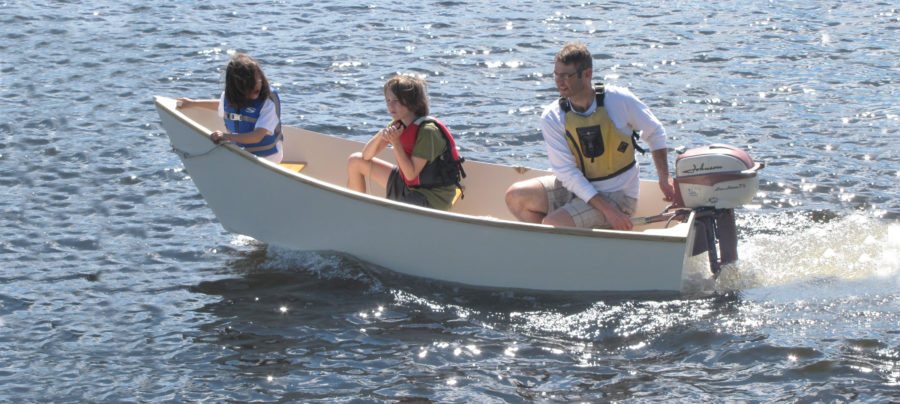
Compass Skiff
Clint Chase designed the Compass Skiff for the Compass Project, a Biddeford, Maine, nonprofit that works with kids. “We needed a really small, easy-to-build boat for a weekend boatbuilding festival…
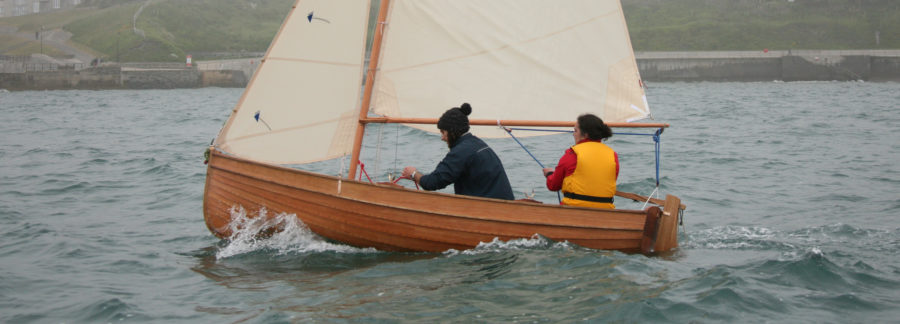
Iain Oughtred’s Guillemot is a multipurpose boat intended for rowing and for sailing with either a gunter or lug rig. He designed the boat 25 years ago and based it on the…
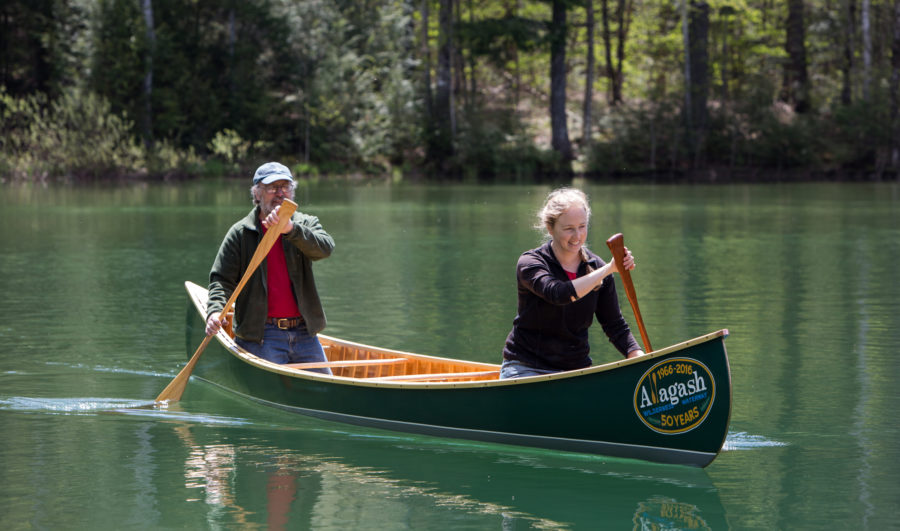
Atkinson Traveler
Rollin Thurlow has been building and restoring wood-and-canvas canoes for 38 years. This spring, Rollin took a short break from his shop, the Northwoods Canoe Company in Atkinson, Maine, to…
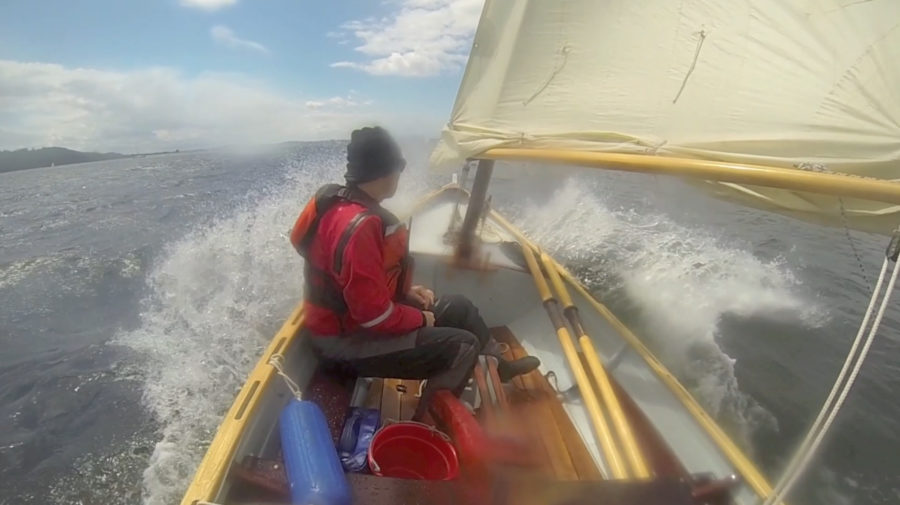
In 1982, when Eric Hvalsoe was fresh out of a two-year boatbuilding program at Bates Technical college in Tacoma, Washington, he launched the first Hvalsoe 13 (then named the Valso…
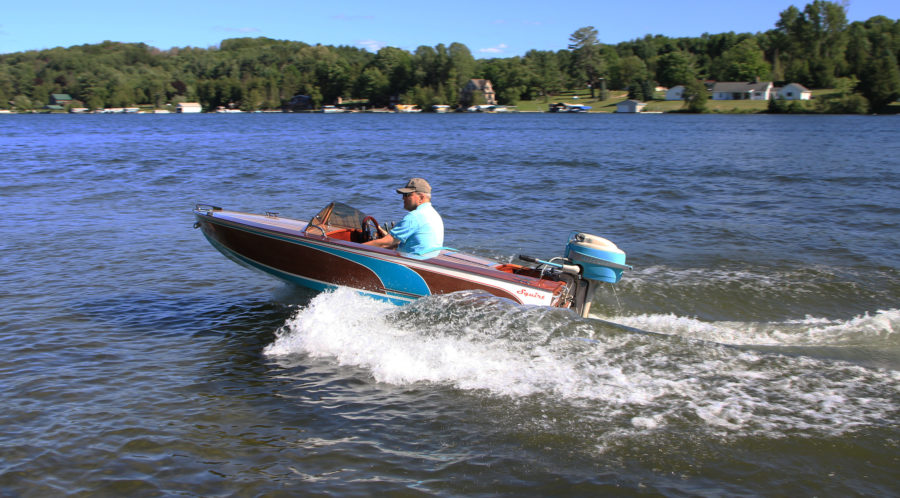
During a weekend in northern Michigan during the summer of 2009, I got a chance to take a spin in a couple of wooden boats that my daughter’s boyfriend had…
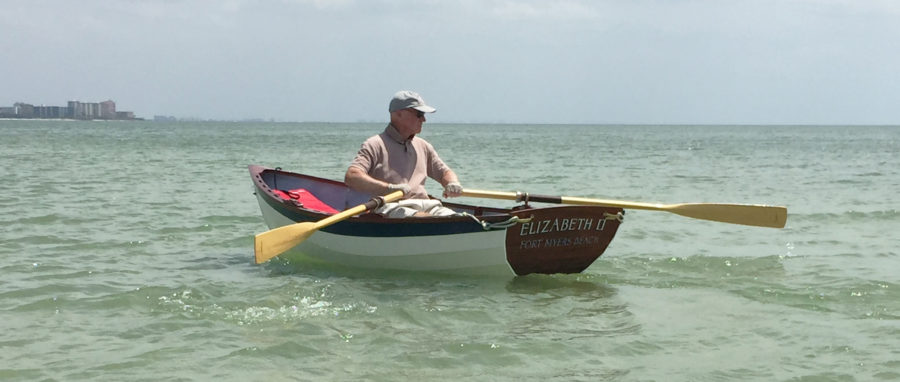
Chaisson Dory
I live in Fort Myers Beach, a small town on Estero Island on the southwest coast of Florida. Estero is a barrier island with a long, shallow-sloping white sand beach…
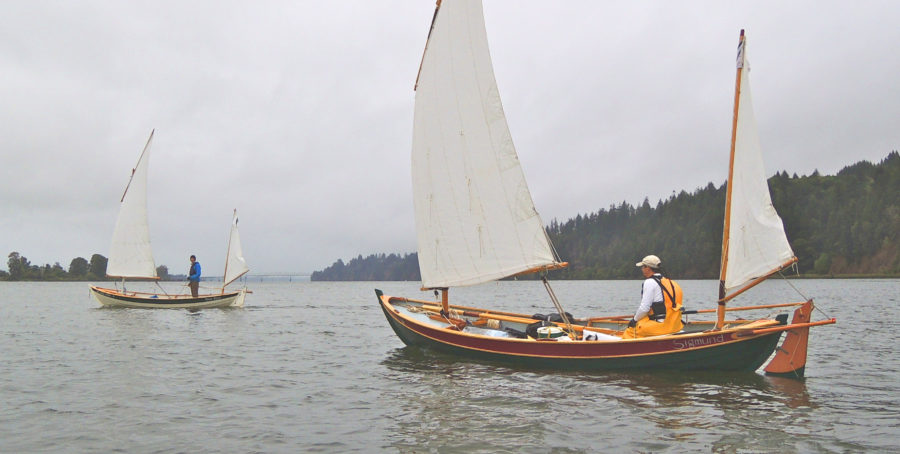
Arctic Tern
Iain Oughtred’s double-ended beach boats are descendants of Shetland Island yoals, workboats used extensively for fishing. While the Shetland Islands have long been politically linked to Scotland, older cultural ties…
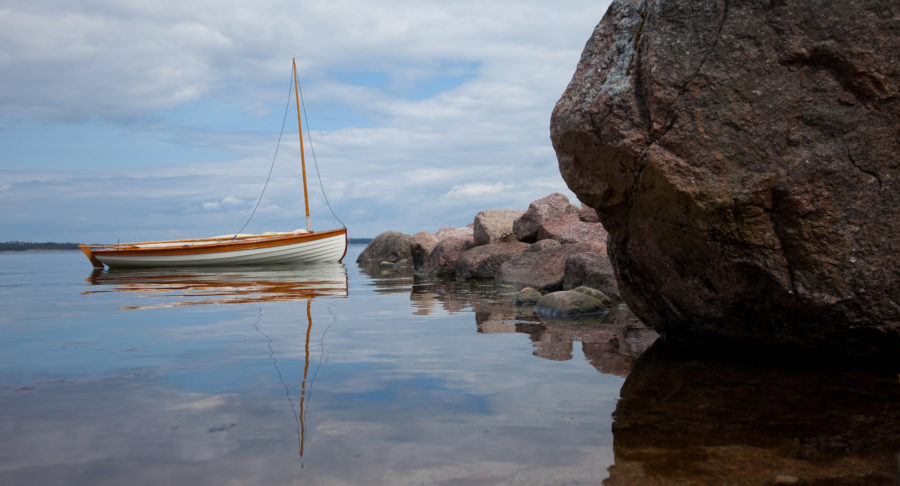
The Isles of Finland
In the middle of July last summer I found myself with no responsibilities. I had five days with no plans and no kids to attend to. I packed AANAR, my…
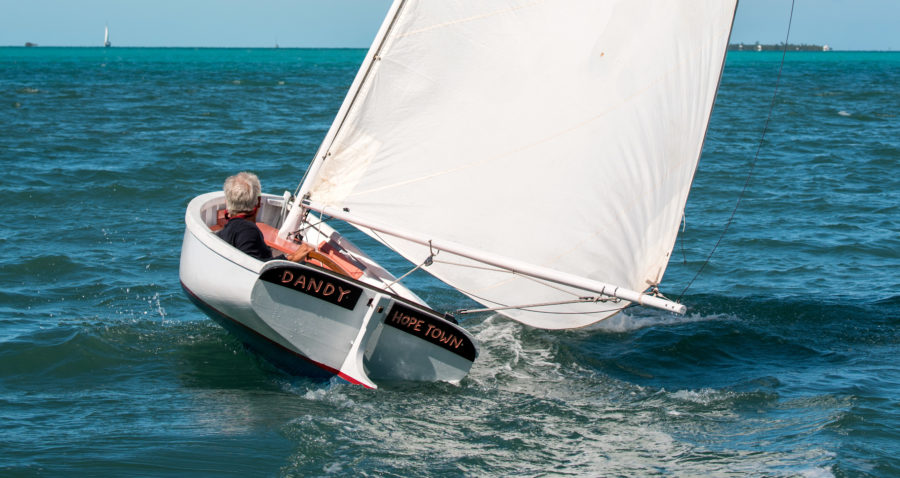
Abaco Dinghies
"Sweet lines” is often the first thing out of the mouth of classic-boat aficionados having a first look at an Abaco dinghy. It’s no wonder legend has it that this…
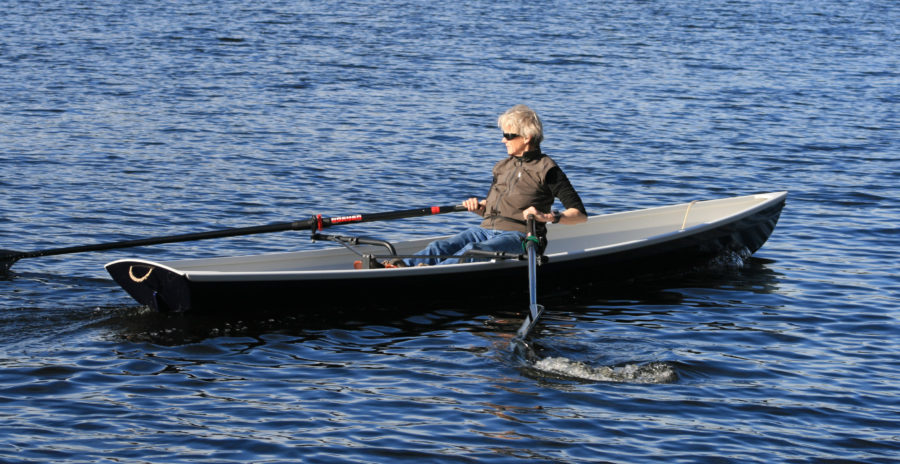
Duckling 17
The Duckling 17 is a robust, elegant, and fast pulling boat. Its predecessor, the Duckling 14, was designed and built in 2007 by Sam Devlin to meet a client’s need…
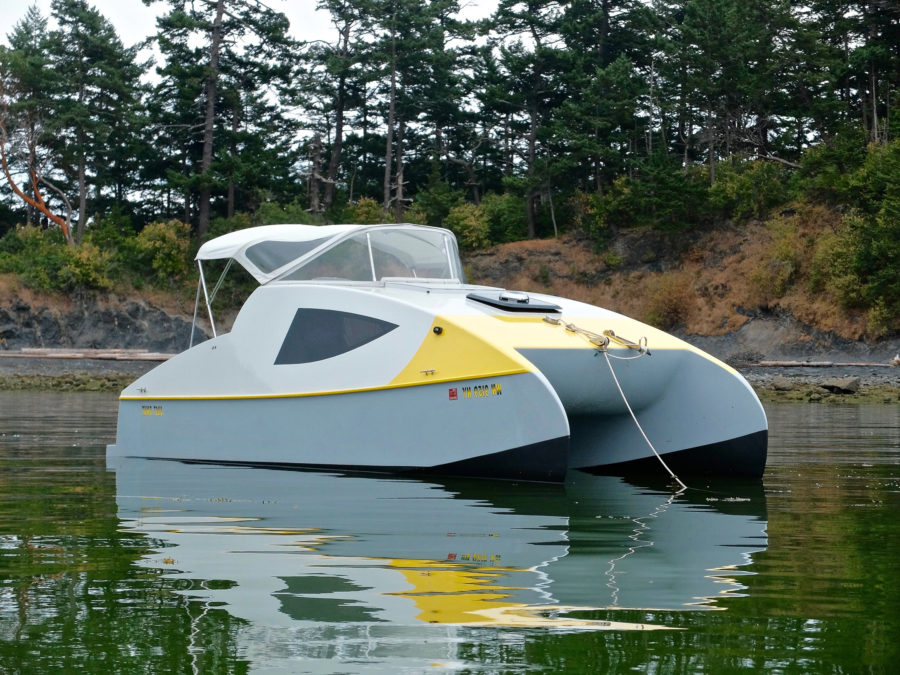
Was it time for another boat? In the 1980s, it was a 16′ sailing dinghy that awakened my wife Barbara and me to the beach-cruising pleasures of the San Juan…
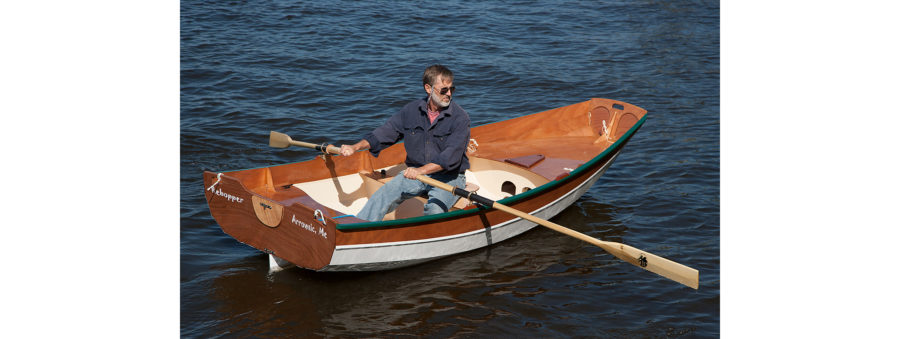
Passagemaker Dinghy
Initially designed for millionaires, the Passagemaker skiff is also ideally suited to thousand-aires like me. In addition to being a manageable “investment” at $1,349, the Passagemaker proved to be less…
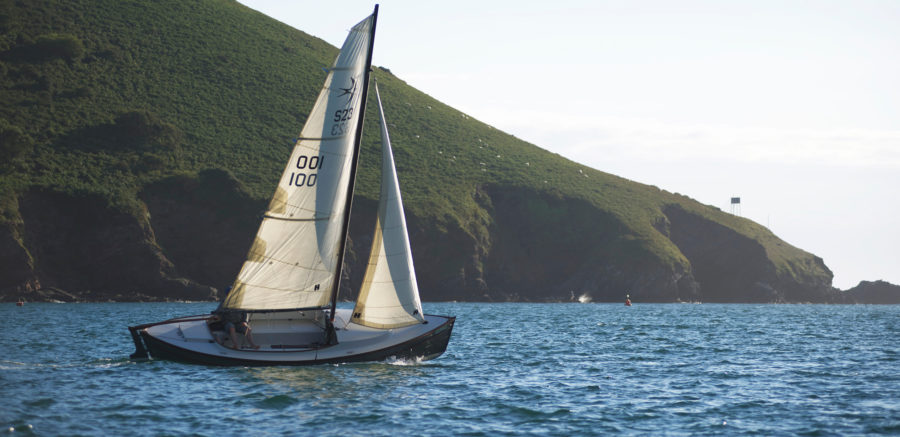
Several years ago, I was standing on the banks of the River Thames watching a boat sailing by at the annual Beale Park Boat Show. It was a small, double-ended…
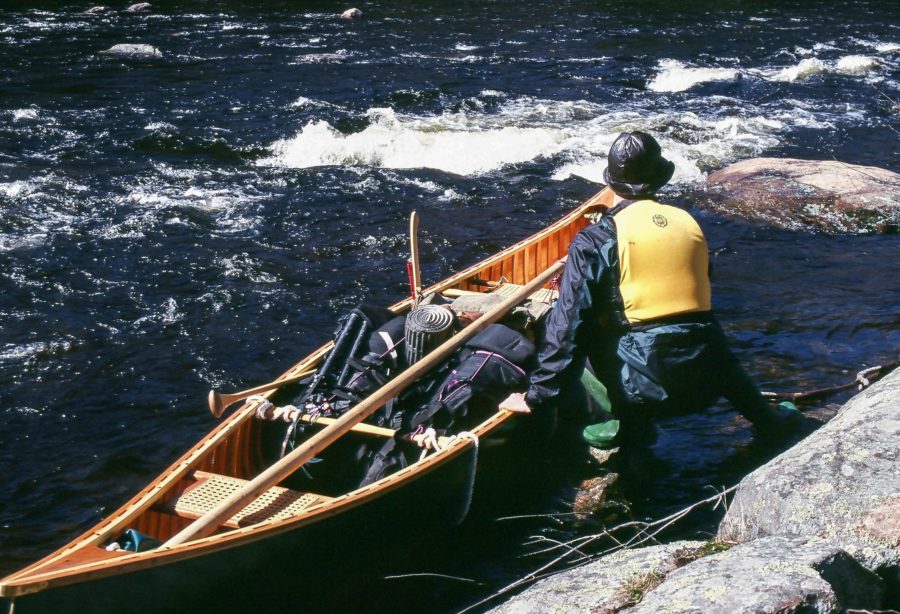
Crossing the Northeast by Canoe
“Is that really necessary?,” I teased Andy, pointing to the tripod strapped to his pack. Andy, a veteran Outward Bound instructor, was the first of several paddling partners to accompany…
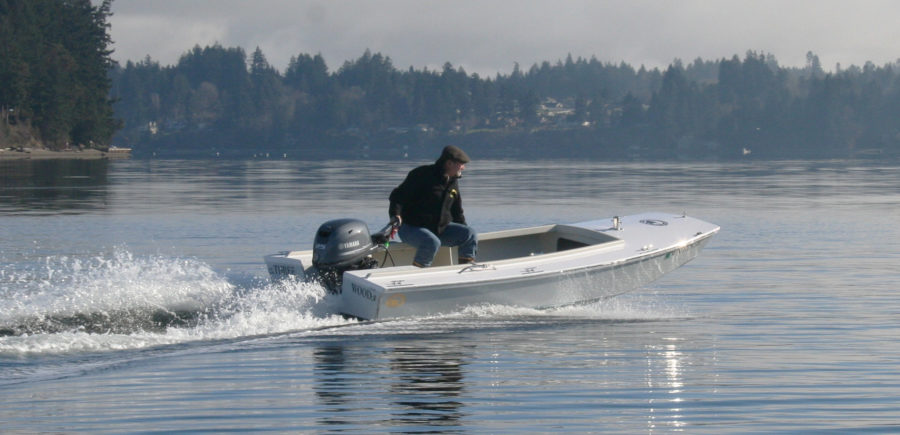
The Cackler
Sam Devlin’s Cackler wears camo well, but if hunting’s not your thing, it can easily take on a different look and different duties: Its 14′4″ garvey hull and unobstructed cockpit…
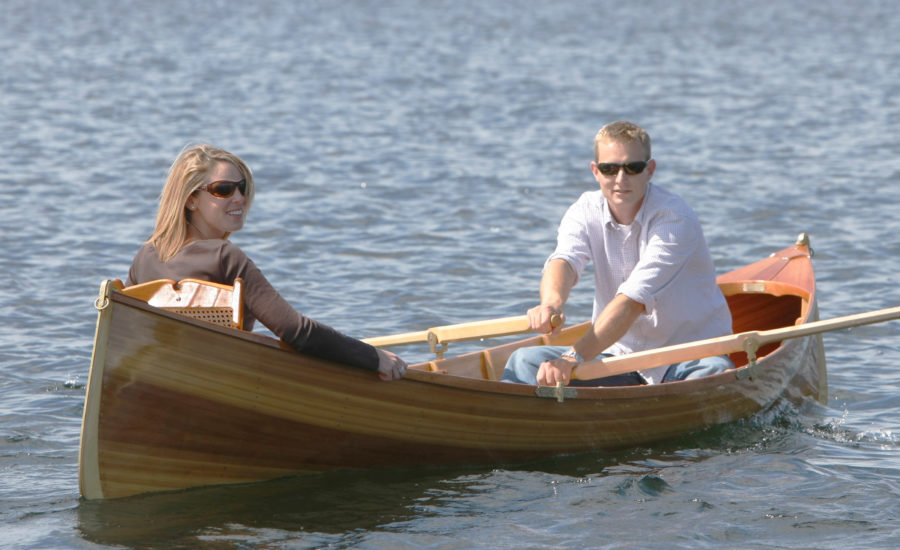
The Adirondack Guideboat
The Adirondack guideboat traces its lineage back to the 1840s and the water-rich, road-poor Adirondack region of upstate New York. The myriad lakes, streams, and rivers there required slim, shallow-draft…
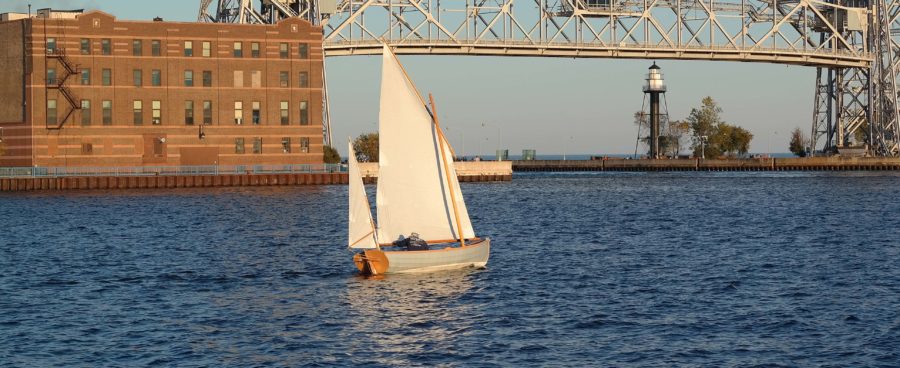
Calendar Islands Yawl
Jim Levang’s Calendar Islands Yawl is a real beauty. Maine designer Clint Chase acknowledges the influence of designers he admires, especially in his early work—Paul Gartside, Iain Oughtred, François Vivier,…
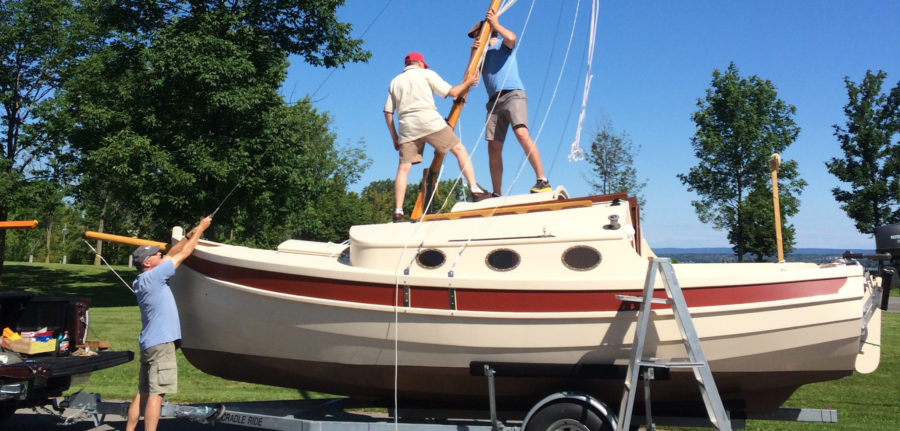
"So, should we be expecting a prolonged period of rain?” asked a neighbor as I clamped the final plank onto the Welsford Penguin taking shape in my garage. The reference…
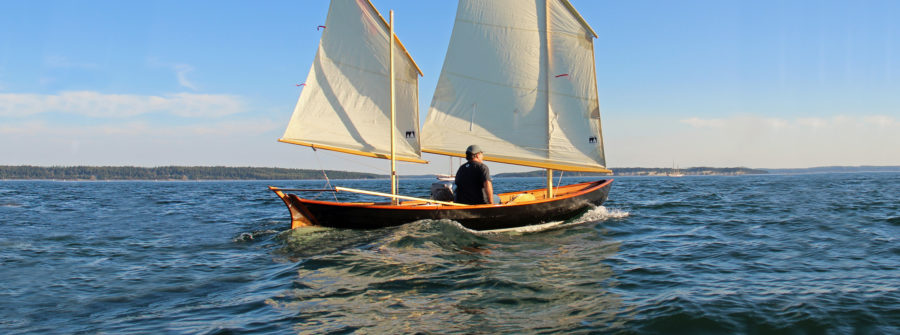
Southwester Dory
It’s unfortunate that “Jack of all trades” is so often followed by “master of none.” It is possible to do a number of things quite well, and versatility is often…
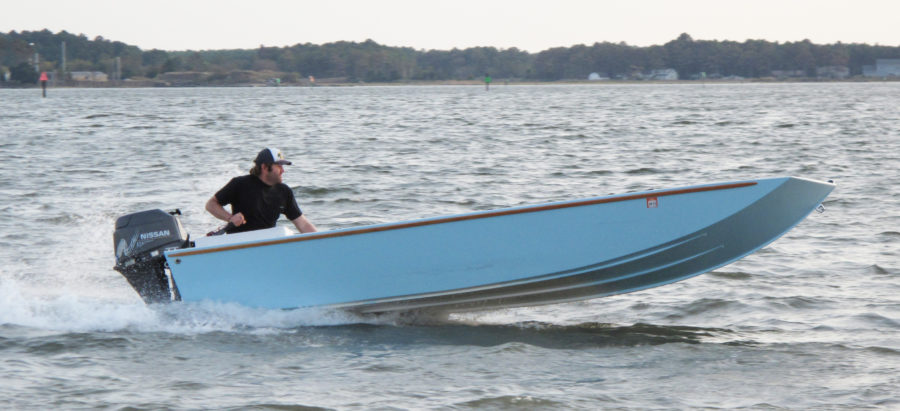
Inlet Runner
Any serious angler knows the need for fresh bait for a day of fishing; being able to catch your own and not having to depend on a bait-and-tackle shop is…
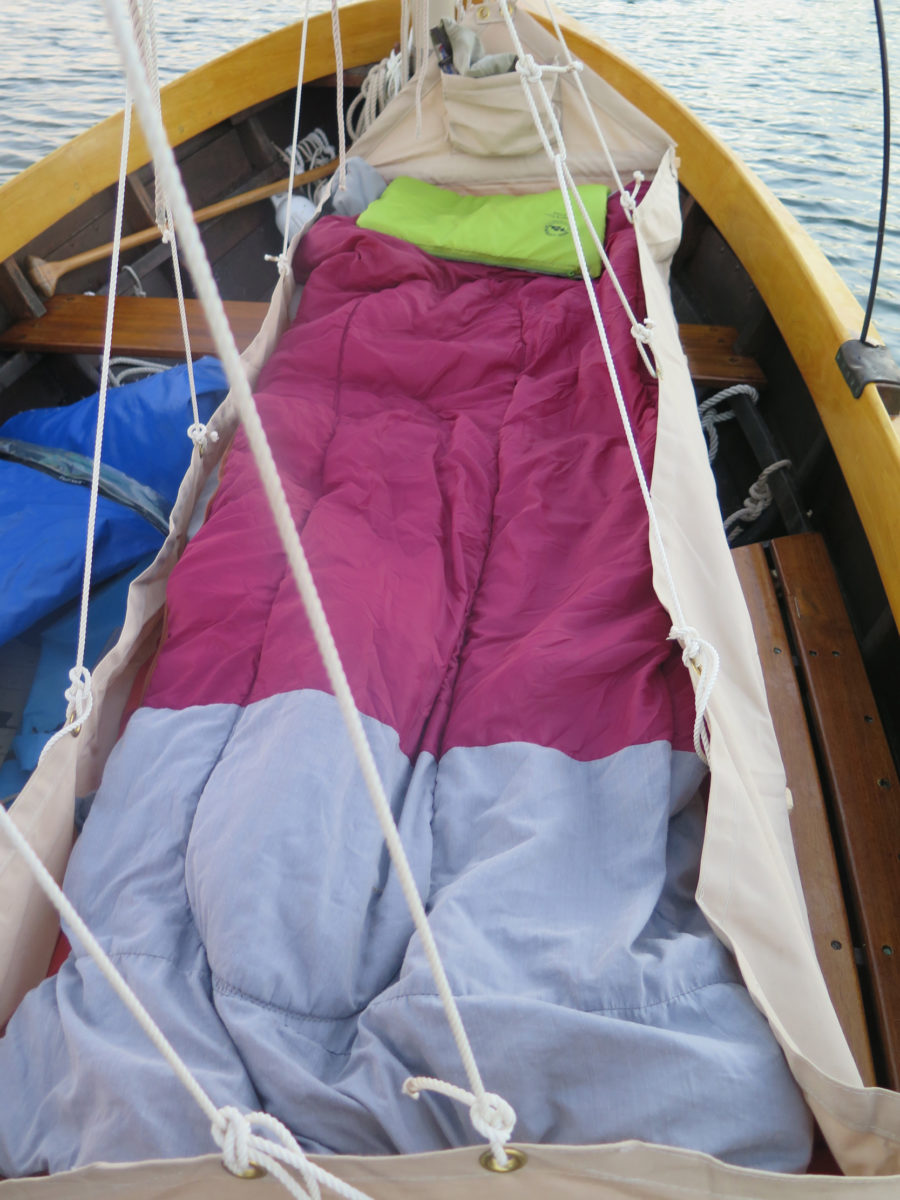
A Canvas Bunk
rCuising under sail and oars can be an odd combination of casual relaxation and nonstop intensity. It means uninterrupted time on the water, to be sure—and intimacy with nature and…
More Boat Profile
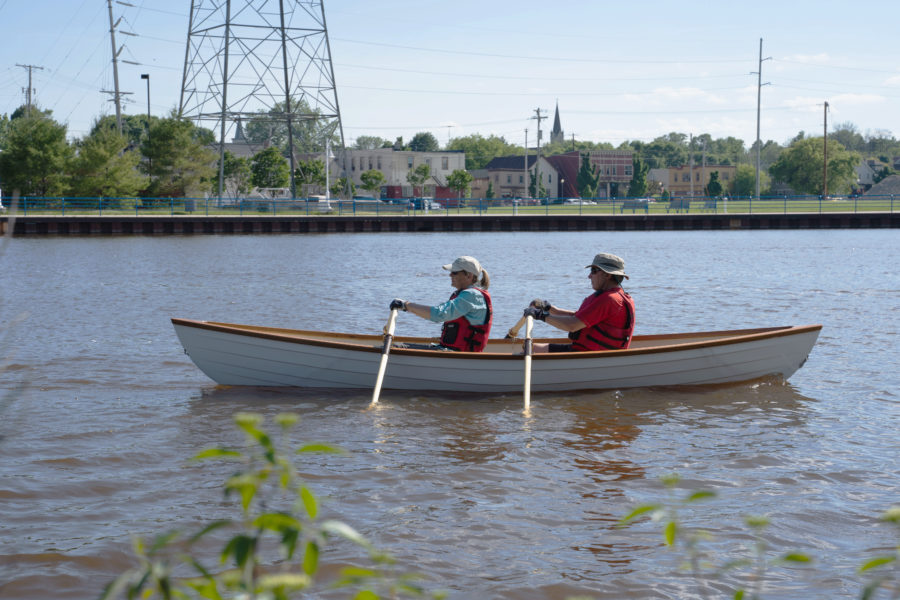
Crawford’s Gunning Dory
Roger builds his boats one at a time. The Gunning Dory is hand-laid fiberglass starting with rolled-on gelcoat. The layup for the bottom includes biaxial fiberglass cloth, a 1/2″ foam…
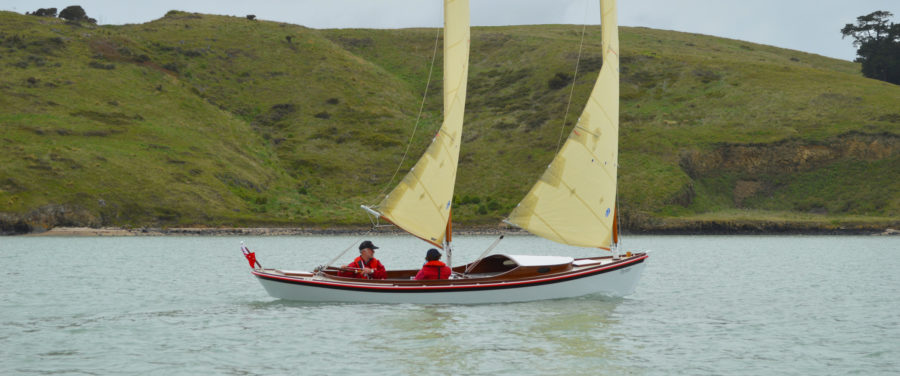
The diminutive yacht OYSTER, a Milford 20, is a modern take on the early New Haven sharpies that worked the oyster beds along Long Island Sound’s Connecticut shores. Inspired by…
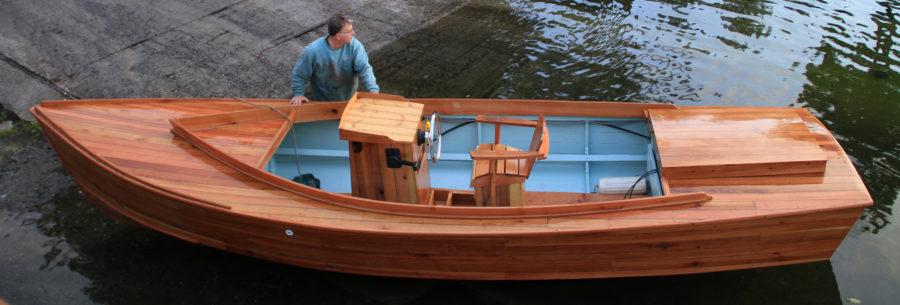
Handy Billy
Harry's website designates this build as best for someone having intermediate skills. It is helpful to have some skills in woodworking (cutting, fitting, and shaping) and problem-solving, but having good…
Subscribe Today!
Become a subscriber today and you’ll recieve a new issue every month plus unlimited access to our full archive of backlogged issues.
Already a subscriber? Sign In
Subscribe For Full Access
Flipbooks are available to paid subscribers only. Subscribe now or log in for access.
Log in or Sign up
You are using an out of date browser. It may not display this or other websites correctly. You should upgrade or use an alternative browser .
Multihull Structure Thoughts
Discussion in ' Multihulls ' started by oldmulti , May 27, 2019 .
oldmulti Senior Member
The following Bernd Kohler designs are close sisters. The Eco 5.5 came first then people asked for a slightly larger version (every designer gets asked could I just lengthen/shorten this a little). So Bernd designed the Eco 6 which uses mainly the same materials in a slightly longer and wider boat. The Eco 5.5 is a bridge deck cat 18 x 8.2 foot weighing 650 lbs and displaces 1390 lbs. The sail area is 200 square foot. The Eco 6 is a bridge deck cat 19.7 x 9.3 foot weighing 800 lbs and displaces 1700 lbs. The sail area is 225 square foot and can have a Code 1 of 190 square foot. The Eco 5.5 and 6 are an example of designs that for practicality, use stronger material than required in a smaller boat. 6 mm plywood can be used on a 33 foot boat. 12 mm ply underwings have been used on 37 foot catamarans that displace 7000 lbs. Result both boats can use the same materials. So what is the structure. The hulls are 6 mm ply, bulkheads 6 mm ply, stringers 20 x 25 mm, chines 25 x 35 mm. The underwing is 12 mm ply, the mast bulkhead is 12 mm plywood with timber strips top and bottom. The forward underwing and cabin roof 2 x 4mm ply and the cabin roof has external stringers. The following web site provides details of rudder and daggerboard construction I mentioned in an earlier post. How to Build Rudders or Dagger Boards | Small Trimarans http://smalltrimarans.com/blog/how-to-build-rudders-or-dagger-boards/ The Eco 5.5 plans show two rigs. A normal sloop rig and a single halyard Gunter rig. For owners who trailer the boat the short mast of the Gunter rig will be appreciated. A well designed Gunter rig with Bernds improvements is as fast g to windward as good sloop rig. The rotating aluminium mast is made from a 80mm diameter tube. The rig/mast on Eco 6 is slightly larger. The following web address gives the Eco 5.5 list of materials. ECOpage3, pocket cruiser catamaran for the DIY boat builder http://www.ikarus342000.com/ECOpage3.htm
Attached Files:
Eco 6 side g.jpg, eco 6 copy z.jpg, eco 55 build 2.jpg, eco 55 frames d.jpg, eco 55 inter build.jpg, eco 55 cockpit s.jpg, eco 6 cutaway.jpg, eco 6 frames a.jpg, eco 6 planking s.jpg, eco 6 build usa.jpeg, eco 6 build 8.jpg, eco 6 build 9.jpg, eco 6 bow view.jpg, eco 6 centre board..jpg, eco 6 underwing.jpg.
Some additional Eco 5.5 and 6 jpegs
ECO 55 rigsoftA.jpg
Eco 55 top_04.gif, eco 55 sail.jpg, eco 55 trailer.jpg, eco 55 interior a.jpg, eco6florida_01.jpg, eco 6 main cab h.jpg, eco 6 build l.jpg, eco 6 cab top.jpg, eco 6 fwd wing frame.jpg, eco 6 frame setup h.jpg, eco 6 build g.jpg.
Fifty Fifty is a 50 foot extreme racing 50 x 30 foot cat. It displaces 3400 lbs and carries 2 x 62 foot wing masts with interconnected rigging. The masts are 110 square foot each with a 775 square foot main on each mast. There are 2 x 500 square foot jibs or 2 x 775 square foot genoa’s. The total sail area with masts and jibs set is 2770 square foot of sail. Power to weight is of the chart. Building the boat was done at Pauger Carbon Composite, 50 km from Budapest. The aim was to compete in the 44th Kékszalag 2012 Grand Prix, the Blue Ribbon on Lake Balaton, Hungary's most important regatta. This regatta has a strong entry with over the 600 boats competing. Unusually multihulls are only allowed to compete in the event every other year, 2012 only being the second time they have been allowed in. The winds were light averaging under 10 knots but the two masted catamaran proved her potential regularly sailing up to 3 times faster than wind speed (peaking at 24 knots) despite the team only being able to sail her for three hours prior to the race. Their winning time of 10 hours, 34 minutes and 15 seconds was a new course record. The boat was built with carbon fibre infused high temp epoxy resin with and an Airex T92 foam core that has very low resin take up. The hulls were post cured. At 3400 lbs displacement there was some very good engineering here especially with the weight of two 62 foot masts etc. PS It only takes 7 to 8 crew to control the boat and rigs while racing. This boat was a precursor to a 35 foot biplane rig cat that was built to race in Switzerland lake races.
fifty_fifty_38_620.jpg
Fifty fifty full sail.jpg, fifty_fifty_02.jpg, fifty_fifty_03.jpg, fifty_fifty_on_board.jpg, pauger35-biplane cat.jpg.
bajansailor Marine Surveyor
I am just wondering how much slower she would be if she only had one rig? Although if it was one rig on one hull, then I guess she would have a preferential tack for sailing on like a proa (?) And if the rig was on the centreline then they would need a huge amount of extra structure (hence weight and cost) to support the compression forces on the mid-span of the bridge deck.
bajansailor. I suspect one rig that was higher would be faster and it would be lighter. The larger one rig may carry less sail but it would be more efficient especially reaching and upwind. And very fast cats that can exceed wind speed basically are going upwind even on a broad reach. The weight saved in the rig can be used to strengthen the main mast supporting beam which will probably need a dolphin striker to support the compression loads. The additional weight will be more in the dolphin striker than extra layers in the main beam. Also some form of compression beam will be required in the bow or a central spine forward to mount the jib on. All possible and I suspect would be a faster boat for less overall cost.
The final Bernd Kohler design for now is the Eco 7.5. It is a bridgedeck cruising catamaran that filled the slot between the ECO 6 and KD 860. The cat is 24.5 x 14.75 foot and weighs 1650 lbs it displaces 3100 lbs. It carries 305 square foot of sail in a sloop rig. There is a Gunter rig option for those who have to pass under low bridges etc. The hulls L:B is 9:1, in short a reasonable cruiser. Its build specifications are similar to the Eco 5.5/6 but with some mild upgrades. EG The planking for the chine hulls has a constant radius and is tortured plywood in some spots. The hulls are 6 mm plywood and have biaxial glass 340 gr/m2 and one layer 200 gr/m2 glass fabric. The roof is 2 layers of 4 mm ply and forward under wing is likely to be 3 layers of 4 mm ply. The under wing is 12 mm ply. The attached sample PDF plan gives more details of the structure. Many copies of this cat have been built globally and owner reports I have read indicate it is a good boat that sails well and is capable of coastal passages. When you look at some of the build photo’s please remember the boat has a reverse bow and the hulls are built upside down.
Eco 7.5 side a.jpg
Eco 75 sailing w.jpg, eco 7.5 hull build d.jpg, eco 7.5 cross 2.jpg, eco 75 bow build.jpg, eco 75 galley build.jpg, eco 75 main cab build.jpg, eco 75 cnstruct 5.jpg, eco 7.5 x ray.jpg, eco 7.5 side x ray.png, eco 7.5 saloon2.jpg, eco 7.5 top s.jpg, eco 7.5 galley 2.jpg.
eco pwr 7.5 drawing.PDF
Wingmasts have been around for years and are on a lot of high performance boats from small cats to fast cruiser EG Eagle 53 cat mentioned earlier. But the evolution is still going on with EG Beneteau has developed a reefable wingsail for their cruiser racers. The market is still not ready for the concept but Beneteau is not hiding the fact they can sell it. But one of the most interesting developments is the inflatable wingsail. This wingsail depends on air pressure to hold its shape and appears, according to tests, to function well as a sail. But the real trick is it is reefable. The sail has effectively 3 separate air chambers, combined with a mast that has 3 sections in it and the mast can expand or contract according to the what portion of the sail that is pressurized. Each air chamber has its own valve which can be controlled from deck level. There is an air pump which runs continuously to pressurize the sail. The air pressures in the sail are low. The whole rig is relatively light and can withstand a small hole in an air chamber and still operate. Why is this interesting? Think about a multihull “capsizing”. With a large inflatable wing sail which is in effect a giant flotation device that will not let you capsize beyond 90 degrees (assuming the mast is strong enough). You have a lot better chance of righting a boat from 90 degrees than fully inverted. You get a win win, a wingsail and an anti capsize device in one.
benatau wingsail 1.jpg
Benteux wing-sail-reef.jpg, inflatable wing mast 1.jpg, inflatable wing mast overview.jpg, inflated-wingsail-yacht-running.jpg, inflatable wing deflated 2.jpeg.
Whilst we are talking about wingsails here are a few more items to contemplate. Professional Boat Builder magazine issue 14 page 11 has information on wing spars including Gold Coasts 53 foot charter cat spars. Professional BoatBuilder - 14 - Dec-Jan 1992 https://pbbackissues.advanced-pub.com/?issueID=14&pageID=11 Wingmasts were also discussed on page 5 of this thread with plans for Stressform wing masts. The additional information is in jpeg one which is how land yachts build their wing masts that carry 100 square foot of sail at speeds up to 140 kilometers per hour (80 MPH). Basically a blue Styrofoam core with a 3 mm plywood web with 12 mm aluminium rods at either side. The whole thing is wrapped in 2 layers of 200 gsm cloth. These masts take a lot of abuse and at 80 mph at lot of pressure. The next 2 jpegs are of large “wing” masts designed by Eric Spondberg. The first is a carbon fibre version and the second is a timber version. The timber wing mast version is for a 110 foot (yes 110) steel charter boat. The final jpeg is of a 40 foot cat that had 2 freestanding wing masts. The boat scared the owner in its first few sails and he cut 12 feet of the top of each mast. The boat then sailed 2000 miles up the Australian coast before being put up for sale. Rob Denny built the carbon fibre masts to the owner’s requirements.
Foam glass wing mast 1.jpg
Sponberg wingmast construction.jpg, sponberg wood wing mast large.jpg, biplane wing mast cat.jpg.
The final one on masts for a while, the diagram below is an interesting comparison of wooden masts. I understand most people who read this are likely to have aluminium or something more exotic for their rig but this diagram conveys a lot of information. A. a solid mast is heavy for its stiffness/compression. B. the thinner the wall the larger the diameter required to maintain the same stiffness/compression. C. different shapes can have an influence on weight and stiffness/compression. D. a plywood sided mast can be lightest weight but it has one of the largest cross sectional area. The table down the bottom on round masts is also informative. As the wall thickness is decreased to reduce weight of the cross sectional area the mast diameter must increase to maintain the same stiffness/compression capability. Like all things in yachting masts are a compromise based upon the design needs. With mast design leave it to the professionals unless you have a big budget or a small boat where you can use a known quantity like a beach cat rig. The original source for the diagram came from Hollow Masts for Small Sailboats https://www.pdracer.com/mast/hollow-mast/ if you need a clearer image.
Mast comparison wood s.png
C class cats have always been on the leading edge of design. The basic design is 25 x 14 foot with 300 square foot of sail. The weight of the boats vary. The old all timber boats were 550 lbs the modern nomex carbon fibre boats are under 400 lbs. The hulls are much lighter in modern C class cats but the rigs are a lot more complex full wings which are heavier than the aluminium mast, light Dacron sail cloth, old C class versions. Lady Helmsman an early C class hulls were 2 layers of 2.5 mm ply diagional reinforced with 3 mm ply around the daggercase area and a 150 mm wide glass bandage around the hull at cross beam attachment points. A 21 x 19 mm stringer at turn of bilge. Three 50 mm Styrofoam frames at 900 mm centreline in the bows. The deck is 4.5 mm supported by 6 mm ply deck beams. The fore and aft beams are M. 160 with the main beam having a 400 mm deep dolphin striker with 7.5 mm wire. The next generation came about the time of Miss Nylex which was the first full solid wingsail and composite hull C class. The boat was 500 lbs and had a 6 mm balsa sandwich hull with 330 gsm of glass on either side. It still had aluminium beams. The next generation started in the early 90’s with foam carbon fibre hulls, carbon fibre cross beams and very sophisticated multi element wings. These boats started to become lighter (under 500lbs) but the wing weight was increasing due to the multi elements. These hulls are PVC foam with epoxy glass of 270 gsm Carbon Fibre. In the late 90s the design of C class were becoming very refined with EG Cognito not only being very well designed but had significant developmental testing done as they refined the building process. We are talking female moulds, Nomex cores, carbon fibre skins and crossbeams. The aerodynamics of the hulls was also being designed in. The rigs are really advanced with fewer elements but having more flexibility allowing greater control across the wind range. The following article in Professional Boat builder issue 39 page 30 gives details. Professional BoatBuilder - 39 - Feb-Mar 1996 https://pbbackissues.advanced-pub.com/?issueID=39&pageID=33 Cognito took 4500 hours to build and many hours to develop to its full potential. The next generation was experimented with about 2006 but was not fully developed until about 2013. The foiling C class cat. These C class cats required a rethink. The hull structure had to be reinforced around the dagger/foil case as it now has to support 70% plus of the boat weight. The bows are becoming finer with narrower decks to pierce through waves not ride over waves. The transom structures need to be reinforced to handle the some very high load and control forces. The aerodynamics of the hole structure is now considered as the entire boat is often 2 feet in the air. The hulls are less than 200 gsm carbon fibre on either foam or nomex with fully integrated crossbeams and almost all fittings are carbon fibre structures. These boats are approaching 350 lbs of weight. These boats need very good sailors to control them. Even student groups are trying to develop C class cats eg. Rafale II carbon/epoxy C-Class hydrofoil catamaran http://www.jeccomposites.com/knowledge/international-composites-news/rafale-ii-carbonepoxy-c-class-hydrofoil-catamaran The cut away diagram is of that boat. Finally there is a PDF written by Steve Killing about the transition development of C class cats in 2007. The non foil boats were ending and the foil cats were being developed. This I one story of that transition.
Old C class d.jpg
Lady helmsman c class.jpg, niss nylex c class g.jpg, old c class wing x.jpg, evolution c class s.png, foiling c class 1.jpg, modern foil c class.jpg, cf_epoxy_hull_design_jpeg.jpg.
C class development SteveKilling F (1).pdf
Famed sailboat aerodynamics researcher C. A. Marchaj published this startling graph in his research paper Planform Effect of a Number of Rigs on Sail Power . Most startling is the extraordinary performance of the crab claw sail, which demonstrates its superiority to a Bermuda mainsail right from the close-hauled condition. Its superiority increases when the boat bears away, and on reaching, with the heading angle 90 degrees, the driving force coefficient of the crab claw is about 1.7, whereas that of the Bermuda rig is about 0.9. That is, the crab claw rig delivers about 90% more driving power than the Bermuda rig. ~ Sail Performance Marchaj theorized that the crab claw develops lift in a different way than the standard Western Bermudan. It operates in what is called *vortex lift* mode, which creates powerful spinning tornadoes of air off the leading edge. The spinning vortexes are zones of intense low pressure, and thus lift is created. If you wish to learn more, Marchaj’ book Sail Performance (Adlard Coles Nautical 1996) is highly recommended. His tests showed that the crab claw was not the only traditional rig that could outperform the Bermudan on some courses. A lateen was superior to windward, and the gunter, sprit, and lugsail were all superior overall to the Bermudan. The Bermudan with a small jib tested very well close-hauled, second only to a lateen in Lift to Drag (L/D) ratio. The modern sport of yacht racing has developed around the triangular race course which favours windward sailing efficiency. The Bermudan tested very poorly on off wind courses however. It has also been pointed out that very fast sailboats, such as racing multihulls or ice boats, create so much apparent wind that they are always sailing close-hauled, and therefore, it’s the L/D ratio that really counts, not the max Lift Coefficient. Further tests were done in the attached PDF which compared various pacific island rig types for the best performance. Again the crab claw was best. The jpegs are a subset of the information. A summary from the authors is as follows “To understand the sailing performance of traditional canoes in Oceania, we replicated ten sail rigs and tested them in a wind tunnel. Measurements of lift and drag forces demonstrate substantial differences in their performance. At low heading angles, from about 30° to 80° off the wind, three sails ( Massim , Ninigo , Santa Cruz ) are remarkable for their higher efficiency. Three other sails ( Tonga , Hawaii , Tahiti ) are remarkable for their lower efficiency from heading angles of about 90 to 130°. In between, four more sails ( Arawe , Micronesia , Vanuatu , Marquesas ) have roughly similar performance to each other. The ranking of these sails is followed by a description of their distribution with inferences on historical evolution of canoe rigs.”
Machaj crab claw vs burmudian main.png
Pacific island crabclaw-tests.png, pacific island sails tested.png, pacific island results diagram..png, crabclaw sail.jpg.
Pacific rig analysis of performance.pdf
Vaka 990 Proa is a 32.5 x 18 foot cruising proa with float accommodation or if the proa is a sports version the float has water ballast. Its displacement is 1900 lbs carrying 400 square foot of sail. The boat is constructed of west epoxy plywood construction. The bulkheads and main hull are 9 mm ply with floats 6 mm ply. (36 sheets 2.0 X 1.25 mtr 9 mm. 16 sheets 2,5 x 1.25 6mm). The "Pod" is habitable and acts as an anti-capsize device and the boat has 4/2 berths, a WC, limited galley with storage. The jpegs give an idea of the Vaka 990 Proa. The PDF is a detailed study plan of the boat and its structural components. The second proa is a racer cruiser designed for the race to Alaska. This is aimed at performance plus. Page 14 of this thread has study prints of the proa Madness which is the same size. Each should be capable of sailing very well for good sailors. These boats are not set and forget boats, they need a constant watch to ensure not being backwinded etc which would threaten the rigs on Madness and the Bieker Proa. As Russell Brown proved with Jzerro, pacific proas can be very fast if well designed and built.
vaka990_3D1.jpg
Vaka990_sport.jpg, vaka_990_1.jpg, vaka_990_interior.jpg, vaka990_26 overall.jpg.
DossierVaka990 proa plan.pdf
32-proa-sailplan.jpg.
catsketcher Senior Member
Thanks (again) for another great series of posts. I am interested in the stability curve for the Bieker proa. It must be one of the very few multis that doesn't drop off consistently after max moment. I guess that is the effect of the pod coming into play. I got to go out on Russel Brown's proa in 2001 or so but we only went out for a motor. Beautifully built boat.
Catsketcher. I got to speak to Russell when he was in Monty's yard in Queensland. A nice guy. He was modifying his proa by putting uni carbon fibre on the cross arms to minimize the "vibrations" caused by the float bursting thru wave tops. Asked what he would change, he said nothing beyond making the main hull 45 foot long and a chine hull bottom. A really good sailor and a fun boat for those capable of sailing it.
- Advertisement:
The attached Gruit PDF on composite construction is a bit technical but contains many gems of information about the relative strengths of resins, fabrics and composite construction approaches. The document tries to explain both in simple and occasionally with technical information the relative vices and virtues of each product and approach. EG The relative tensile strength of S glass and HS carbon are the same. Its just S glass elongates 3 times more than HS carbon before failure. The same applies to compressive strain where S glass compresses 3 % compared to HS carbons 1% before failure but they both fail under about the same pressure. The real difference between the 2 is S glass can take 6 times the impact pressure of HS carbon fibre. Translation HS carbon may be strong, but because it doesn’t elongate as well a S glass, it fractures more easily. Another aspect is the curing rate of resin versus its strength. In each case of polyester, vinylester and epoxy in a EG resin/fabric matrix, the tensile strength is 25% higher if it is post cured for 5 hours at 80 degree centigrade than if it is left at 20 degrees centigrade for 7 days. The discussion on fabric and core materials gives very good in sites into the virtues and/or vices of the different materials to allow you to make a more informed decision about there selection. EG SAN foams are able to elongate more and are tougher than PVC foams although they have similar strength characteristics. And there is differences between grades of PVC foams beyond strength. Some have greater resistance to styrene attack than others etc. A very informative document. Please read.
guide-to-composites gruit.pdf
recognize this multihull?
Multihulls Direct?
a multihull design riddle
HDPE Multihulls Indonesia
Custom multihulls.
Block coefficient of Multihull
Sydney to Hobart multihulls
Multihull power requirements
Lack of data about steel multihulls
Multihull Bulkhead Refit Advice
- No, create an account now.
- Yes, my password is:
- Forgot your password?

You are using an outdated browser. Please upgrade your browser to improve your experience.
- Sailing Blogs
- List Your Catamaran For Charter
- List Your Catamaran For Sale
Outremer 55
Outremer 55 Owner’s Review
Thanks to Marijke and Mark from Cat Greatcircle for their help on this extremely thorough owner’s review of the Outremer 55. I hope you enjoy it as much as we did!
This is very comprehensive feedback from two experienced sailors. We have pulled out some key points below, but we encourage you to read the whole article, as it has some fantastic insights into the Outremer 55 and performance catamarans in general.
Some Key Points
- This couple has migrated from a Lagoon 39 to a Lagoon 52S and onto a performance catamaran. When I asked “Would they swap the Outremer?”, they said “yes”. They are swapping her for a new Outremer 55 (!)
- The main reason? Higher daily average mileage and no flybridge (smoother ride)
- The best bit about the Outremer 55? It’s the best compromise between comfort, performance and looks available on the market.
- Save some budget for the carbon options, solar, traveller line driver and your sail locker.
- The 55 gets sailing from 3 knots of apparent wind and up. That’s eco sailing.
- 38 degrees AWA is the sweet spot for VMG going upwind.
- The flexible dual helm setup works well in all conditions.
- Cat Greatcircle plans on 230 nm days. That’s just under a 10kt average.
- The 55 has a high-quality finish. These yachts are built to last.
- Cat Greatcircle has tested the Outremer after-sales service to the max. It’s good.
- The other area that Outremer excels in is its sail training and owner/manufacturer community
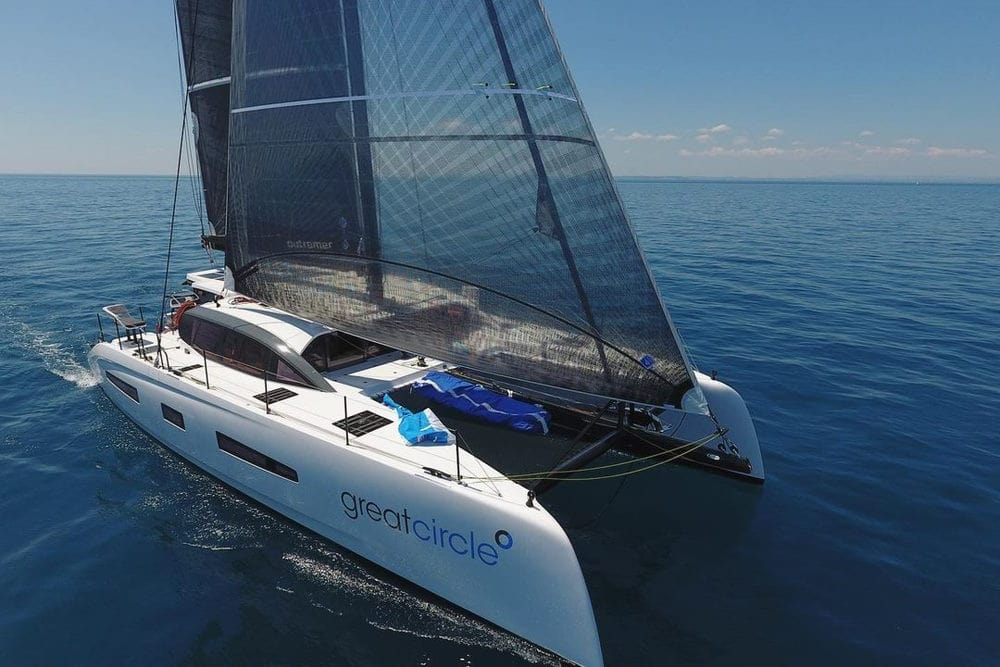
Full Review
Reading time: 20mins
Can you tell us a bit about yourself and your Outremer 55 catamaran? You’ve crossed the Atlantic and the Pacific so far, right? What is the plan now from NZ? Marijke has been sailing monohulls since she was 6. After we met in 1997 we started sailing together, first on chartered monohulls in several sailing areas of the world. Later Marijke bought her former Rival 34 back and we sailed around Holland in it.
Nice boat but a bit small, so in 2015 we decided to buy our first cat, a Lagoon 39 and sailed it from France to above the Arctic Circle in Norway. As we were really enjoying the liveaboard life, after a year we upgraded to a Lagoon 52S and sailed it almost full-time for 3.5 years in the Med and crossed the Atlantic to the Caribbean and back to Holland.
Just before our first Atlantic crossing, we had already signed up for the brand new Outremer 55, hull number 4.
At that time the boat only existed on paper, but it already promised to be the ultimate combination of comfort, performance and looks.
The second Greatcircle was delivered mid 2021, just before the departure of the GLYWO500 rally, a rally with around 30 boats circumnavigating the globe.
In the meantime, we’ve sailed over 18.000 nautical miles with the Outremer 55, from the South of France via the Panama Canal to New Zealand.
At the end of March 2023, we will start the second half of the rally back to the Med. The route will take us via New Caledonia, Vanuatu, Australia, Indonesia to Mauritius and then South Africa this year. Next year we will cross via Sint Helena to Brazil and then via the Carib and the Azores to Lisbon.
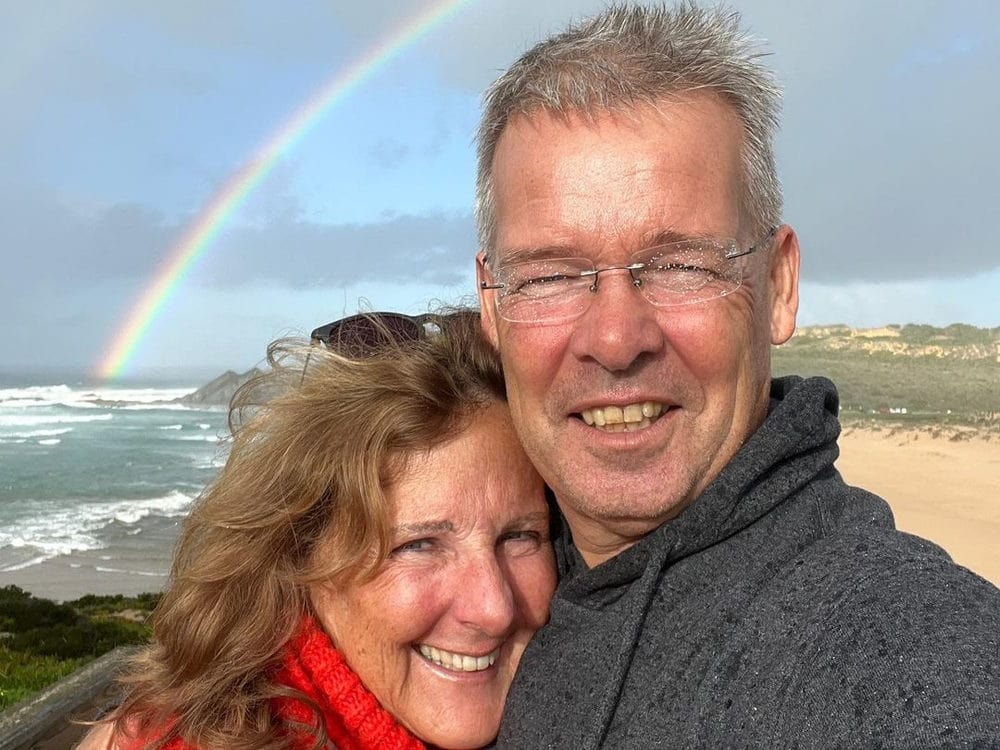
Why did you choose the Outremer 55? Was it the helm position, the performance or the living space for example? Which layout did you go for? (eg the desk in the front cabin?) We have been looking at all of the cats on the market regularly since 2015. The Lagoon 39 was a perfect cat to start on and get used to the particulars of a catamaran.
At that time we already thought it was huge (at least compared to our Rival 34 that is still in front of our house). The upgrade to the L52S was easier than expected and the sailing characteristics and motion comfort were already way better than on the L39. The L52S is probably the best sailing Lagoon ever built.
After 3 years on the L52S, we decided to make another step in preparation for a circumnavigation and had a thorough look at the available brands and models on the market.
We were not looking for the fastest or lightest cat on the market as we are not racers but cruisers. We know that for boats on the lower end of the weight scale, comfort has to suffer both in terms of the equipment and in terms of motion comfort.
In the end, we chose between two boats that only existed on paper, a Lagoon 55 and the Outremer 55. In hindsight it was love at first sight when we saw the design of the Outremer.
That Lagoon stopped producing Sport-tops for their bigger models probably didn’t help either as we are sailing the boat double-handed most of the time.
We had no need for a flybridge, and it doesn’t help the sailing characteristics either. The new Outremer has half the weight of the Lagoon, and much more space and headroom in comparison to the previous generation.
We chose the three-cabin version with an owner’s hull and a normal front cabin in the guest hull.
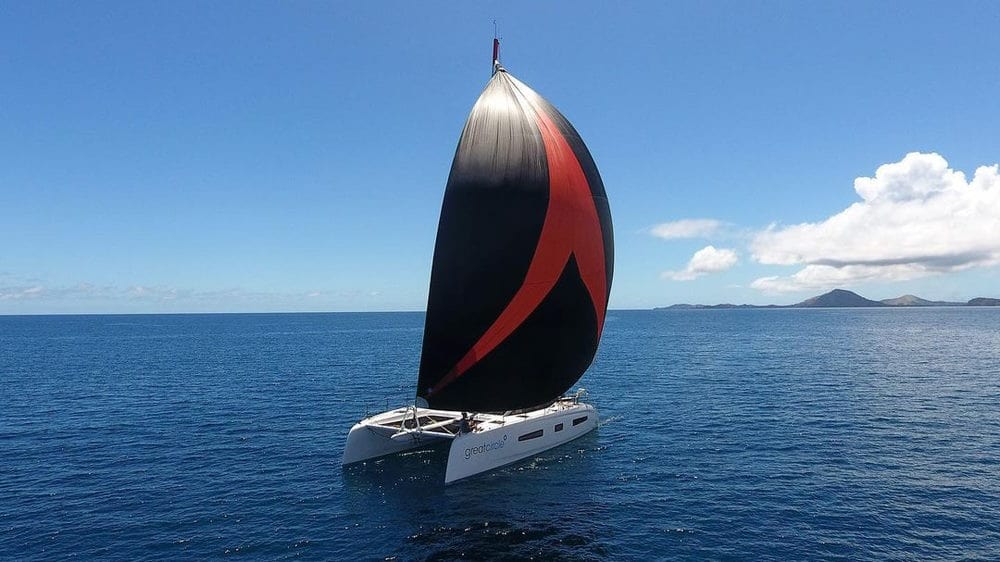
When was she launched? 2021 right? How was the buying and building process? The build of the very first Outremer 55 was started in the second half of 2020 and we followed the production of the first 4 hulls very closely. We even rented an apartment in La Grande Motte to document the whole process and to discuss the different choices and options with the local experts.
Dealing directly with the manufacturer is quite different from what we were used to before with Lagoon in their dealer model. We loved being able to shape the boat to our wishes, but also to learn from experienced sailors with another background.
Greatcircle was launched in April and finished and optimised in the months thereafter. It’s nice to see that experiences and improvements found on the first three hulls were immediately transferred to our boat as well. Initially, we were OK with not having hull number one but to be honest we were surprised by the level that they were already able to reach building the very first copy of a completely new generation of yachts.
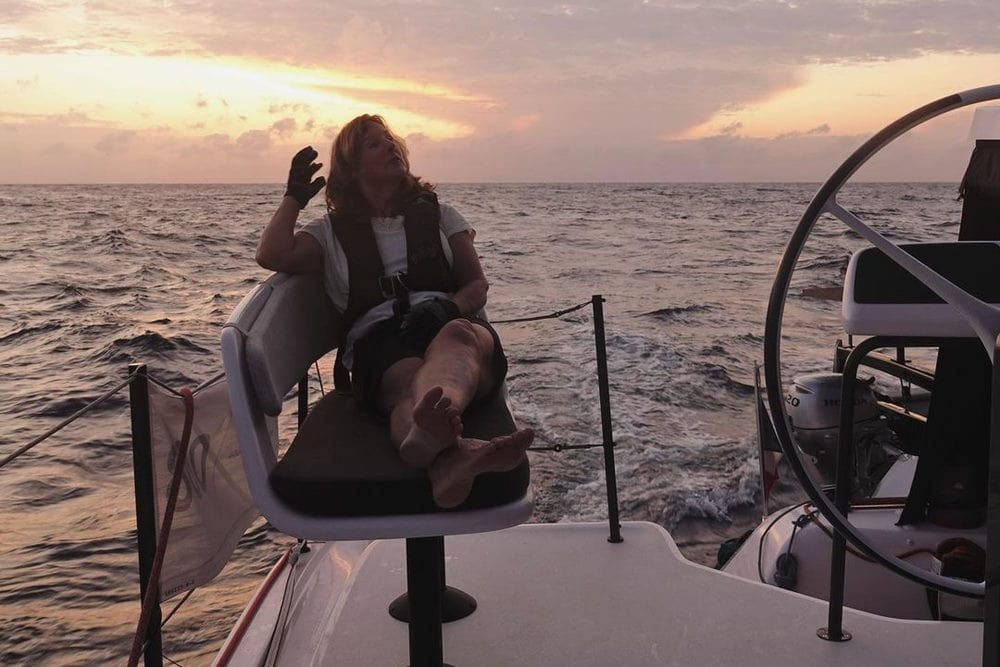
Outremer is also known for its sail training and owner community. Any feedback on that? eg Ladies Day. As we visited La Grande Motte a lot we met many existing and future Outremer owners. In addition to the pure performance-oriented sailors that already knew Outremer, more and more sailors like us started to explore the 55.
Many of them already saw our YouTube videos on the Lagoons and/or the videos from the design and build phase of the new Greatcircle. They reached out to us via Instagram and Messenger to discuss the pros and cons of the boat in general and of the different choices to make in the configuration process.
It’s a lot of fun to be involved in discussions like that and it has helped us as well to re-evaluate our own choices based on the experience of others.
Outremer Week is a very successful concept, twice a year now, where customers can learn a lot about all kinds of topics from manoeuvring in port to medical training to engine maintenance. It’s a perfect way to get to know a lot of other Outremer owners as well.
Even though Marijke, as a female captain, might not be in the core target group of Ladies Day, she was very impressed by the way experienced female sailors like Nikki Henderson transferred their knowledge.
It seems very important, especially on longer offshore cruising expeditions that the tasks on board can be shared by multiple people on board.
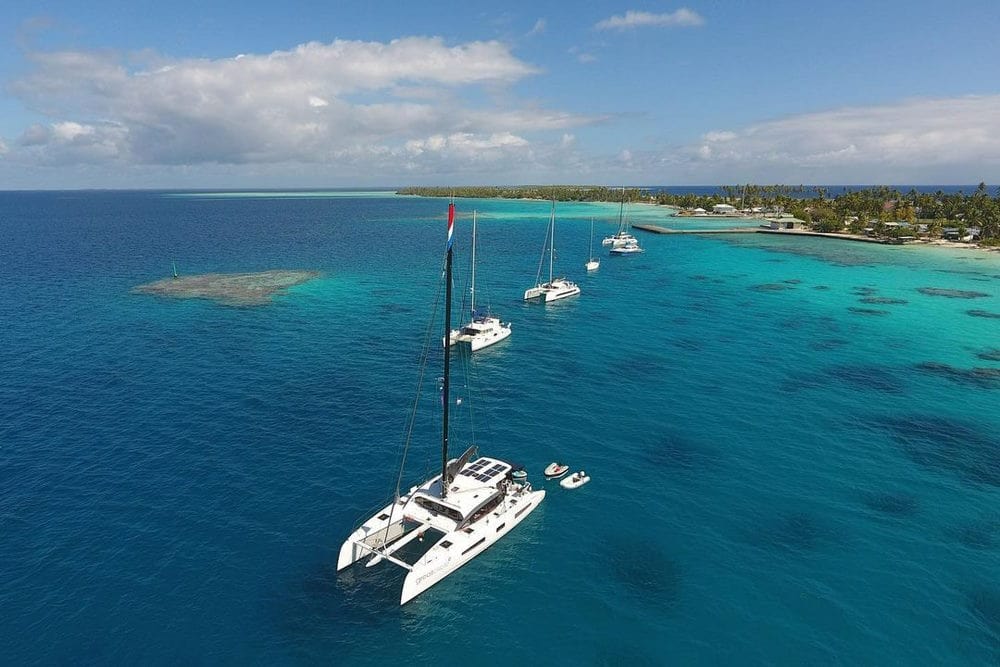
What’s the best thing about Greatcircle? To us, it’s the best compromise between comfort, performance and looks available on the market.
We have all the equipment we had on the Lagoon, we still have plenty of space, headroom and storage space and we’re crossing oceans 20-30% faster than we were used to. And as a bonus, the boat looks stunning.
If there was one thing that you would change, what would that be? Or wouldn’t you change anything? We have already sold our current Greatcircle for the end of 2024. We have reached an agreement on a new Outremer 55 some time ago. The specs would be nearly the same as we were pretty pleased with the choices we’ve made on the current one.
One item we would like to optimise is that we want to expand the situations in which it is possible to sail the boat single-handed. For instance regarding reefing and furling the downwind gennaker when the sail is on port. We’re discussing this with Outremer, it’s still too early to tell but there might be a surprise outcome of this discussion.
Does she carry weight well, or do you have to be careful to not overload her with gear? The Outremer 55 has plenty of payload. We have everything on board you could wish for and there is still 2,5 tonnes of payload remaining even when fully loaded with water and fuel! More performance-oriented owners of a 55 have an even lighter boat (about a ton lighter) but during the GLYWO500 we’ve seen that the differences in average speed are marginal.
What are the “Must Have” Options when buying new in your opinion? eg Carbon cross-beam, carbon mast, watermaker (Dessalator), the convertible table in the saloon, generator (10,000i Fischer?), solar, carbon options, a/c, Esthec decking, extra invertor, extra freezer, water filter, scirocco fans, special galley worktop, Raymarine remote, induction plate, washing machine, folding props, ZF throttles, electric winches, windlass controller at helm For offshore cruising a water maker (preferably a backup water maker too) and a second autopilot are a must have. The other options depend on the personal preferences of the owner. I would recommend not having gas on board. In most cases, the 2000+ watts of solar are enough to cover the energy demand. In periods of bad weather, you still need a backup power source. We chose the genset over charging with engines and/or a hydrogenerator.
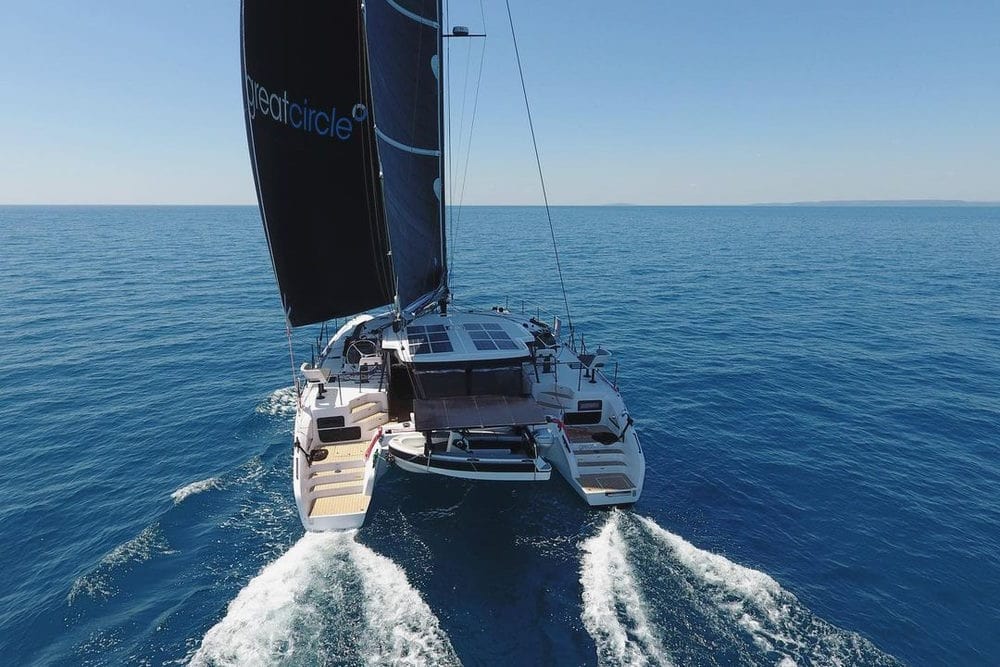
Can you give us an idea of what is in your sail locker? Which sails are your favourite? Gennaker, Spinnaker, Code 0, A2 Spinnaker etc We chose the DFI mainsail and self-tacking jib (solent) from Incidence as they are lighter (and Marijke likes black sails :-)). We didn’t choose the staysail/trinquette option and so far we never had a situation where we needed it.
As the 55 doesn’t need to be reefed very early the solent functions perfectly fine in all conditions we would like to sail in. We never had to furl the solent, a couple of turns so far.
Sailing around the world along the traditional routes there’s a lot of trade wind / downwind sailing. You need to have some flexibility and redundancy in the front sails.
We use the (flat and not too big) Code 0 both (close) reaching and downwind depending on the circumstances. Both this Code 0 and the downwind gennaker are perfect in changing conditions where it might be necessary to furl the sail now and then.
The A2 asymmetrical spinnaker is the perfect sail in lighter breezes, we use it to sail starting from three knots apparent wind. After 18.000 miles our engines still have only 350 hours …..
The S3 heavy duty symmetrical spi is made of polyester and we use it to sail almost dead downwind in breezes from 15 knots true. Most of the time we hoist in on the lower halyard and use it without the mainsail. You can leave it up during a squall, we had up to 40 knots of true wind without a problem.
What are the “Nice-to-Have Options”? As discussed the 55 is not very sensitive for a bit more weight. So I would say there is a long list of nice-to-have options that I would recommend. I love the carbon cross, as it makes the boat look fantastic. We choose induction cooking, a combi oven, a dishwasher, a full washer/dryer, aircon, a line driver for the main traveller and all electrical winches. As indicated we also have a genset.
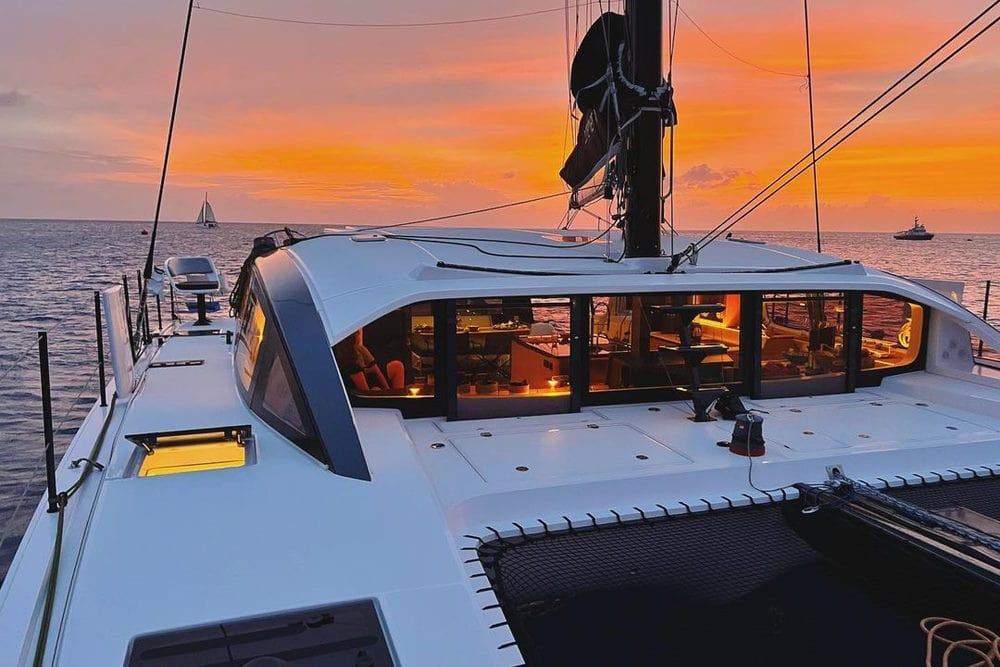
Which options did you “pass” on? For the mast, we chose the non-rotating carbon mast. Reduces complexity and maintenance compared to a rotating one and the performance difference is again marginal.
How are the electrics, plumbing etc? Can you give us an idea of how you set your power system up, the amount of solar (over 2kW right?), hydrogeneration, lithium battery set up (200Ah/battery?) etc? How long can you stay autonomous on power? How often do you use the genset? We have three lithium batteries totalling 16,5 kWh. In normal circumstances, the 2048 watts of solar are enough to charge the batteries during daylight and to cover the total energy demand.
On anchor, it’s almost always enough. Upfront we didn’t realize though that during the longer crossings the sails quite often cover the solar panels.
In hindsight, we’re pretty happy that we stuck to our decision to install a genset to generate extra power when we need it. We installed 2 mass-combis so the genset can charge the batteries very efficiently, so far it has run for 130 hours only.
Is she easy to maintain? Servicing engines, standing rigging etc. You have had a few challenges to deal with on your circumnavigation so far, right? The regular maintenance so far after 1.5 years has been very limited. Of course, stuff breaks now and then, and in those cases it’s fantastic to be part of the Glywo500 rally where every couple of months a whole maintenance team is flown in to bring the boats back into perfect shape.
We did have a couple of incidents during our trip. The worst one was in Aruba when we were hit while asleep on anchor by a 70-ton tourist boat doing around 8 knots. Luckily nobody was injured, but the whole carbon cross was damaged beyond repair.
Without an extraordinary effort from Outremer, this would have meant the end of our rally. An Outremer team and the necessary parts were flown in, and within a month we were up and running again trying to catch up with the fleet before they left the Galapagos.
During this chase, we had a second incident while passing through the Panama canal. While rafted to two other boats and steering on the port side, the starboard gearbox cable broke with the gearbox in the forward position.
Pulling the throttle backward only made the boat go faster forward and the raft hit the wall before we even knew what the problem was. Easy to fix, very lucky that we could give it another go the next day, enough wind from Panama to the Galapagos and we managed to arrive there the day before the departure date of the fleet….
The third incident happened in Fiji where we just hit a reef with the port rudder tip and the rudder system broke. The rally brings you to poorly charted waters and due to the distances in some legs it’s not always possible to sail out in perfect (light) conditions only.
Sometimes if you wait longer to start the leg, you will arrive in the dark. We could have avoided this incident if we had motored along the advised route instead of following the boats in front of us sailing. We managed to stop the water ingress and were able to continue cruising, hopping from the east to the west side of Fiji where the boat could be lifted and repaired.
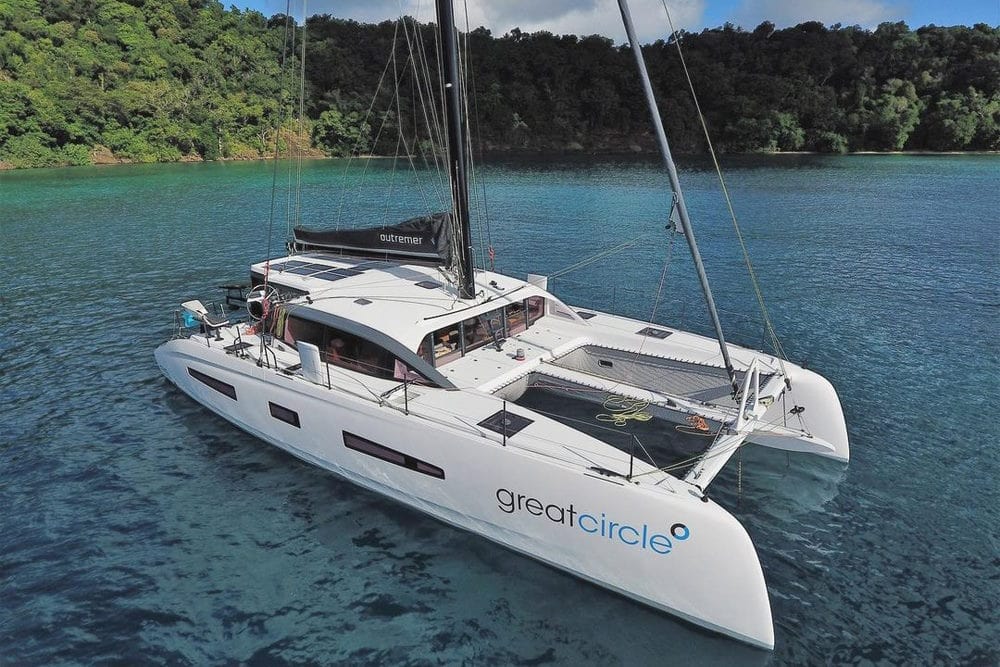
Is she easy to sail short-handed? To shorten sail? Is the running rigging complex? Do all the lines lead back to the helms, for example? What is the “German Sheeting” setup? You reef from the port side, right? In all situations, we can sail the boat double-handed (most of the time it’s only the 2 of us on board).
In many situations, the boat can be sailed single-handed. In general, I don’t think we would use the spinnakers single-handed. In our current setup you need two people to reef the main and to furl the gennaker or Code 0 when the sail is on port (the furling line of the front furler is on starboard).
The way we have set up the reefing system with reef lines on the back of the sail only 1 person has to go to the mast to apply or remove the loops for the luff of the main.
You can control the main sheet on both helm stations and also use the line driver to control the main traveller on both sides (and from the cockpit).
In general, the boat is on autopilot while navigating from either the saloon or the cockpit. If the sails need some adjusting you walk towards the port helm station. Only when the bigger front sails are on starboard you will use the helm station on starboard.
Is it easy to lower and raise the daggerboards and furl the head sails? You had some problems with the gennaker I think? You have a line driver for the traveller I see. Controlling the dagger boards is very easy, as is controlling the main. Indeed we did have some problems furling and unfurling the downwind gennaker.
The sail is pretty round and you need to pay attention not to entangle the sail in itself. In the meantime, we know how to prevent this from happening but still looking for ways to make this more foolproof (other furler?).
The line driver is a perfect option. Electronic buttons will be installed on both helm stations so you can easily control the traveller from the helm station while reefing or gybing.
What’s she like in heavy weather / a blow / big seas? How is the ride in general? (pitch/roll) We didn’t have real heavy weather yet. Most of the time the wind has been below 40 knots and the waves haven’t been over 4 meters yet. In these circumstances, the boat feels pretty relaxed and comfortable. Compared to our previous cat the thinner hulls slice through the water and the Outremer can maintain a higher constant speed.
There’s a lot less noise in general and a lot less slamming of waves against the hull.
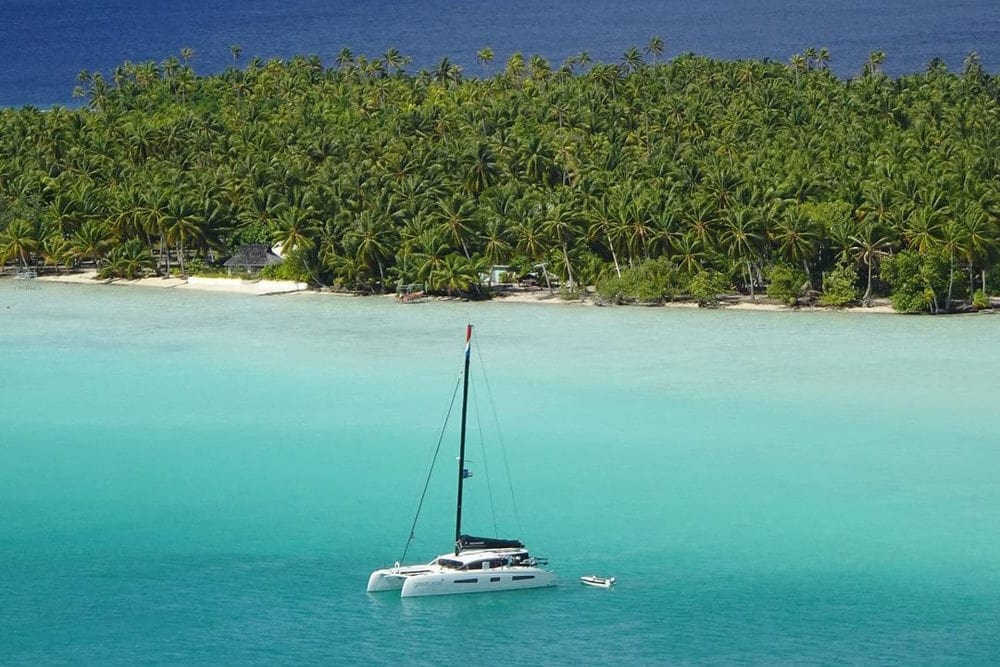
How are the helm positions? Good in weather? How is the visibility when docking? Those swing helms look great, which position do you use the most? I like the feet steering option 😉 The two helm stations are really good when manoeuvring. You can see all 4 corners of the cat from either one of them and just choose the most suitable helm station when docking.
During cruising we often put 1 of the steering wheels (partly) inside the cockpit, especially in bad weather when we close up the cockpit tent. The boat will normally be on autopilot but if something happens or if there’s a glitch of the AP you can reach the steering wheel very quickly.
The benches at the helm station are very comfortable and ideal for catching the breeze, watching the waves and looking out for sea life.
How does she sail in light winds? You can sail the boat starting from 3 knots of apparent wind.
How does she sail close-hauled? How high does she point to true in a good sea state? Close-hauled she sails as high as a decent monohull but at a much higher speed. If the sea is flat sometimes you’re able to reach an even higher VMG by using the Code 0 instead of the solent and sailing a bit lower.
So far it seems that with both sails you reach optimal VMG at around 38 degrees apparent.
Typically, what’s your average speed on passage? What’s the top speed you have logged surfing? Talking about your top surfing speed is nice during anchor shots but is not so relevant for us. Our all-time high was set on the L52S doing 27,2 knots surfing of 3 consecutive waves. On the Outremer, we’ve surfed over 26 knots.
It’s the higher average speed during crossings that makes the real difference. Out the L52S we used to calculate 190 miles per day (downwind or reaching as upwind it will be a lot less).
On the Outremer 55 we calculate with 230 miles per day on average and it doesn’t make a big difference whether this is upwind or downwind. We crossed over 2000 miles from Cabo Verde to Barbados in 9 days and needed 13 days for the 3200 nm for the Pacific crossing from the Galapagos to Nuku Hiva.
What’s she like under power? Speed, manoeuvrability? 60 HP Volvo engines, right? We don’t use the engines a lot but in general, the 60HP Volvo engines are fine to manoeuvre the boat. As we don’t have a bow thruster it does make sense to anticipate what you’re planning to do as the bows tend to react to crosswinds.
If we use the engines while cruising we only use 1 engine, often at very low RPM using 1 to 2 liters per hour at 6 knots.
Is she easy to dock? How’s the windage coming in, any tips? As mentioned above you have to anticipate the bows reacting on crosswinds
What is she like at anchor? What anchor/chain setup did you go for? 70m chain, 50m rope right? We chose the Force 7 lighter chain with a nice and shiny 35 kg Ultra anchor. Indeed 70 meters of chain plus 50 meters of rope. We haven’t used the rope yet.
What’s she like when it’s raining hard? I like the way the clears fix down outside the helms When it’s raining we just close up the clears, and tilt one moveable helm inside. Both from the cockpit and the saloon you have perfect 360 degrees of vision so you only need to go out to adjust the sails and/or reefing.
Is she comfortable up top and down below? Cabins/saloon/galley/heads. Can you give us an idea of the configuration you went for? The island in the galley looks great. Electric heads? Wood option down below right? We chose a three “burner” induction plate and a combi microwave/oven. Works fine, I think the limitations are more on our side than related to the equipment. We have a freezer and a double refrigerator. We also installed a dishwasher and an extra water filter.
The space in the owner’s hull is more than enough, the beds are also nice and wide. We can’t walk around the bed like we could on our previous cat of course. The bathroom can compete with the one we had on the Lagoon and the spacy shower with rain shower and over 2m headroom is just perfect.
When we were visiting the interior designer Franck Darnet we found a different kind of wood and applied it to both the cabin and the hulls to create a warmer atmosphere. This might be a standard price list option in the meantime.
We also chose the option to implement the same Esthec flooring in both the saloon and the cockpit to emphasize that it is one big living space. The disadvantage of the Esthec in areas open to direct sunlight is that it gets REALLY hot.
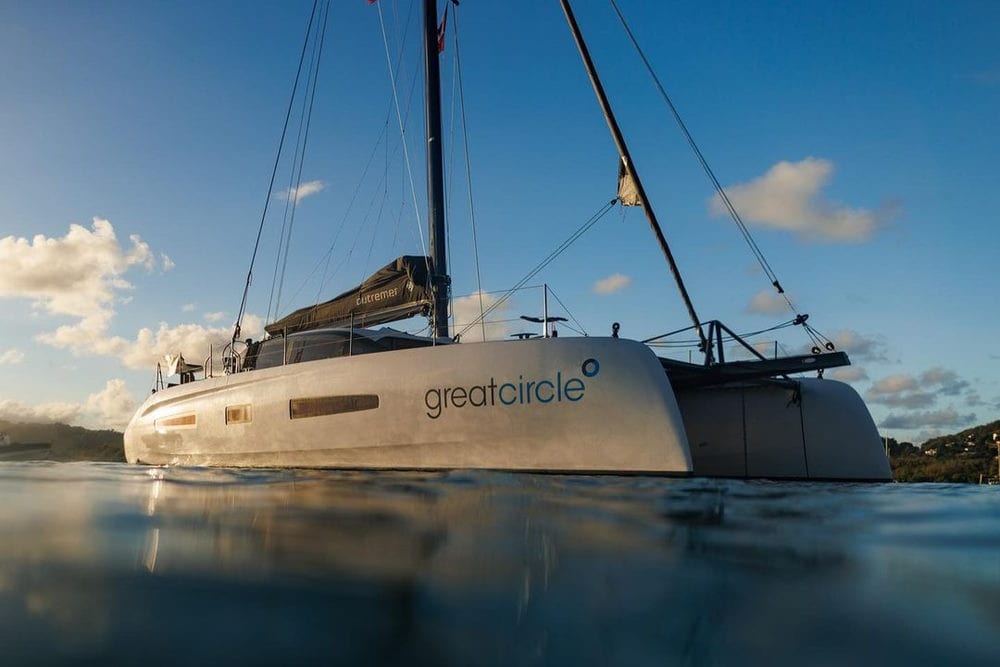
Is there plenty of storage? The sail lockers look good. We still have a lot of unused storage space in the cockpit, cabin and hulls, so no complaints there. The bow compartments are huge, we use one for most of the front sails only so it’s easy to swap them. We use the other bow compartment for the lines, the toys and the spares.
On the foredeck, there are two storage lockers as well. In one of them, we installed the genset. The other one contains our bikes, the mooring lines and some shades.
How is the finish of the interior? Does she creak under sail? Both the extensive lamination of the deck and bulkheads and the quality of the finishing of the interior lead to a big difference in sound levels compared to our previous cat.
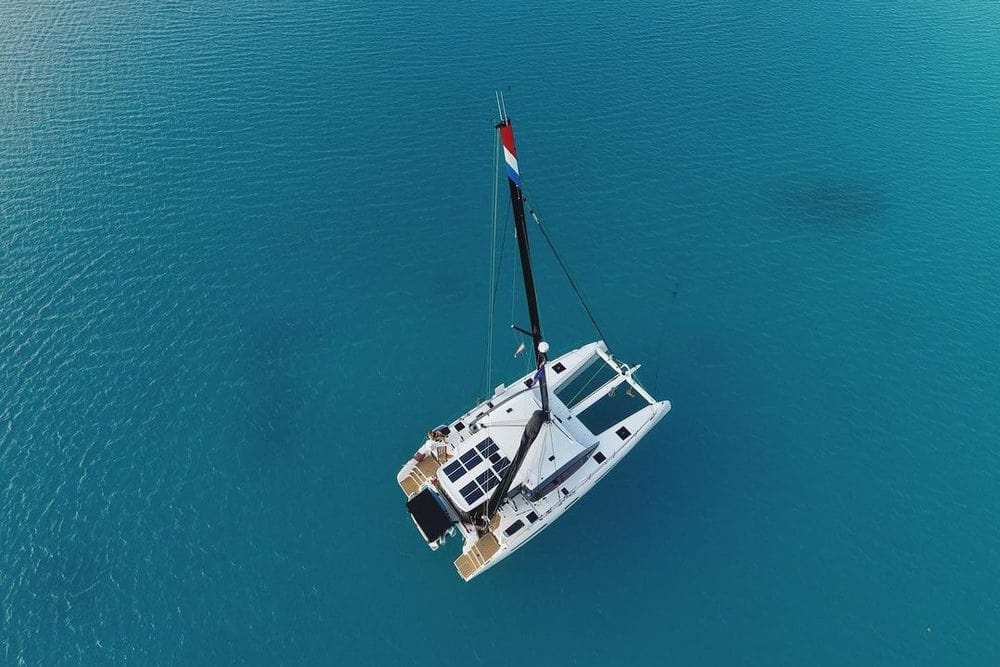
What is your favourite spot on the boat? Our favourite spot is in the saloon with the cabin table lowered and turned into a lounge area
Is she good for hosting guests? We have the three cabin version as we’re not looking to host too many people at the same time. The guests in the port hull share a separate toilet with a sink and a shower with a sink. The bed in the aft cabin is the same as the one in the owner’s hull, the one in the front cabin is a bit less wide.
What kind of modifications have you done and why? We didn’t do any major modifications that were not on the standard option list
Any plans for further customisation? No
What kind of dinghy/outboard do you carry? We’ve got a carbon AST Coast 340 tender , the one with the jockey seat. It carries a 20HP Honda outboard
If you were to swap her for another boat, what would that be? Or maybe you wouldn’t swap her? As mentioned before, we have already sold her (from the end of 2024) and ordered a new Outremer 55!
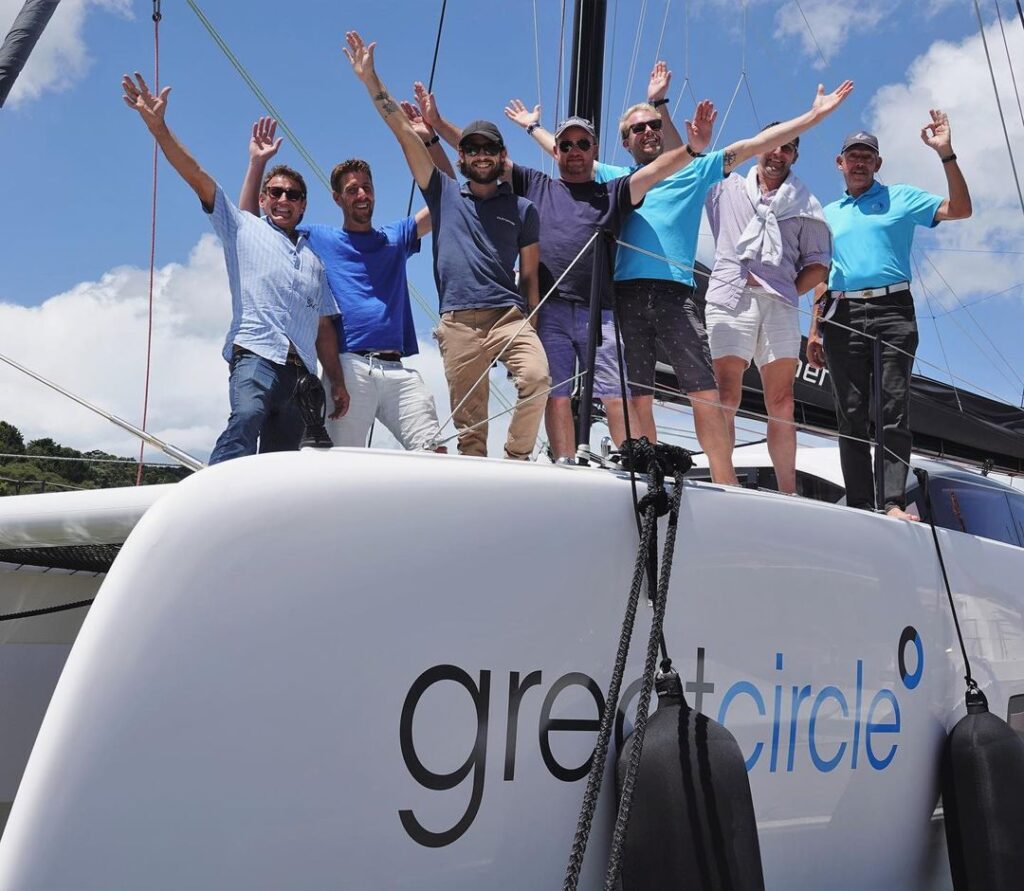
How is the after-sales service from Outremer? It’s amazing. Instead of using too many words, I would suggest looking at the extraordinary after-sales efforts Outremer made when we were really in trouble like in Aruba in February/March last year. There’s a YouTube video on both the crash and the repairs on our channel.
What I also like a lot is that in case of problems discovered on other boats, they automatically review whether these changes should be applied to other boats including the ones already delivered. As an example, we will get new carbon davits on our boat in New Caledonia to upgrade the maximum dynamic load they can endure.
Are you happy with the safety aspects? Escape hatches, position of life rafts, clip-on points and so on In general we are happy with the safety aspects. We do feel more exposed at the helm station compared to our L52S and there is not a lot to hold onto when standing there in rough weather. We’re looking at options to improve this.
Anything else you would add to help people thinking of buying an Outremer 55? Different people have different questions and concerns. Everybody is welcome to post questions they might have to our social media accounts on Youtube, Instagram and Facebook.
How would you rate the Value for Money of an Outremer 55, bearing in mind future resale potential, quality, price and so on ? Our depreciation on the current boat will be 0 (and we could have made a profit if we would have sold it later.)
Would you recommend the Grand Large Yachting World Odyssey 500 (GLYWO500)? For sure! It’s fun to travel around the world with a lot of other boats. You can help each other in case of trouble and enjoy life together on the good days. The glywo organisation takes away a significant part of the bureaucracy and the technical stops are just perfect.
What is your favourite anchorage so far? Marijke’s favourite anchorage is the Bay of Virgins in the Marquesas. I really loved the anchorages in Maupiti and in the Lau Group in Fiji as well.
https://www.google.com/maps/embed?pb=!1m18!1m12!1m3!1d7295.192060516966!2d-138.67447822654512!3d-10.463990020135887!2m3!1f0!2f0!3f0!3m2!1i1024!2i768!4f13.1!3m3!1m2!1s0x763a1c28d027f6dd%3A0xa6108fb93ecf7576!2sBay%20of%20Virgins!5e1!3m2!1sen!2ses!4v1679336705537!5m2!1sen!2ses
Follow Cat Great Circle
You can follow Marijke and Mark on their travels on Youtube (it’s one of our favourite channels), Insta and Facebook .
- Privacy Overview
- Strictly Necessary Cookies
- Cookie Policy
This website uses cookies so that we can provide you with the best user experience possible. Cookie information is stored in your browser and performs functions such as recognising you when you return to our website and helping our team to understand which sections of the website you find most interesting and useful.
Strictly Necessary Cookie should be enabled at all times so that we can save your preferences for cookie settings.
If you disable this cookie, we will not be able to save your preferences. This means that every time you visit this website you will need to enable or disable cookies again.
More information about our Cookie Policy

- Green Propulsion
- Renewable Energy
- Energy efficiency
- Sustainable materials
- Eco Insights
- News & Events
- Sunreef News Magazine
- Press About Sunreef

- 60 Sunreef Power
- 70 Sunreef Power
- 80 Sunreef Power
- 100 SUNREEF POWER
- Sunreef Ultima Range
- Sunreef 44 Ultima
- Sunreef 55 Ultima
- Sunreef 66 Ultima
- Sunreef 77 Ultima
- Sunreef 88 Ultima
- Sunreef fleet

- SUNREEF ZERO CAT
- SUNREEF 100
- Sunreef Fleet

- SUNREEF 35M
- SUNREEF 43M
- 49M SUNREEF POWER
- 210 Sunreef Power Trimaran
- Sunreef Explorer
- 40M SUNREEF EXPLORER
- 40M SUNREEF EXPLORER ECO
- 50M SUNREEF EXPLORER
- Superyacht Fleet
Green Propulsion for Eco Catamarans
While dependency on wind remains an inevitable source of propulsion for sailing catamarans, Sunreef Yachts Eco has witnessed remarkable technological advancements with hybrid and electric engines.
Renewable Energy on Yachts
Apart from powering our solar catamarans with sunlight, we also adapt to other forms of renewable energy to further reduce our carbon footprint and improve reliability and resilience onboard.
Energy Efficiency on Yachts
Eliminating energy wastage is the key principle for Sunreef Yachts Eco. Our research and development team consistently evolves their modus operandi to facilitate sustainable cruising.
Sustainable Finishing Materials
Our eco catamarans capitalize on ethical and sustainable furnishings to encourage a prolonged lifecycle and ease of recycling for an additional benefit action in the environment.
GREEN CONCEPT
Sunreef Yachts Eco catamarans are the future of sustainable yachting. With a 360° approach to eco-responsible cruising, they offer cutting-edge green propulsion solutions, naturally-sourced finishing materials, smart energy management and new technologies including a proprietary composite- integrated solar power system produced in-house to power their newest range of solar catamarans .
This new philosophy of yachting is present in each and every aspect of the Sunreef Yachts Eco catamarans. Their design incorporates ultralight custom- engineered batteries, a revolutionary air-conditioning system, wind-generators, nontoxic bottom paints, green composite structures as well as state-of-the-art watermakers and water-saving systems.

SUBSCRIBE TO OUR NEWSLETTER
- Sailing Yachts
- Power Yachts
- Superyachts
- Making a Change
- Green Concept
Copyright © 2024 Sunreef Yachts . All rights reserved.
- Whistleblowing
- Privacy Policy

Sunreef Venture S.A.
Sunreef Yachts Shipyard
ul. Tarcice 6
80-718 Gdańsk, Poland
+48 58 769 77 77

- Green Propulsion
- Renewable Energy
- Energy efficiency
- Sustainable materials
- Eco Insights
- News & Events
- Sunreef News Magazine
- Press About Sunreef

- 60 Sunreef Power
- 70 Sunreef Power
- 80 Sunreef Power
- 100 Sunreef Power
- Sunreef Ultima Range
- Sunreef 44 Ultima
- Sunreef 55 Ultima
- Sunreef 66 Ultima
- Sunreef 77 Ultima
- Sunreef 88 Ultima
- Sunreef fleet

- Sunreef Zero Cat
- Sunreef 100
- Sunreef Fleet

- Sunreef 35M
- Sunreef 43M
- 49M Sunreef Power
- 210 Sunreef Power Trimaran
- Sunreef Explorer
- 40M Sunreef Explorer
- 40M Sunreef Explorer Eco
- 50M Sunreef Explorer
- Superyacht Fleet
- Sustainable
ASK ABOUT THIS YACHT

The Sunreef 50 is an all-around compact sailing catamaran , ideal for exclusive getaways, charter, and transoceanic adventures. Her clever bridge deck and superstructure design allow for a superior level of comfort onboard whereas the generous teak use, high bulwarks, and classy lines underscore her modern style with a classic edge.
Her saloon opens both onto the comfortable bow terrace and the cockpit which is extended with a hydraulic aft platform. The hulls of this luxury catamaran provide impressive volumes to set up a custom layout including airy, luxurious guest cabins, and an opulent master suite with a walk-in dressing, desk, sofa, retractable TV, and an immense bathroom.
While housing the main helm, the large flybridge is dedicated to leisure with more than enough space for movable furniture, a fully equipped wet bar, and large sunpads. Welcoming up to ten guests onboard, the Sunreef 50 sets new standards of luxury living at sea. Available in classic, solar and electric catamaran versions, it offers versatility and sustainability for discerning sailors.
SPECIFICATION
- ECO VERSION
- CLASSIC VERSION
Construction
15.2 m / 50 Ft
Length overall
9.1 m / 30 Ft
Beam overall
80 m² / 861.11 Ft²
800 l (211.34 US gal)
Water capacity
1000 l (264.17 US gal)
Fuel capacity
79 m² / 850.35 Ft²
167 m² / 1797.57 Ft²
Living space
LAUNCHED BOATS

Sunreef 50 Lucy

Sunreef 50 Dolphin

Sunreef 50 Tiril

Sunreef 50 Paz
READ MORE ABOUT MODEL

PRESS ABOUT MODEL

FORCE ONE | 2022-09

MULTIHULLS WORLD | 2021-12

YACHT STYLE | 2021-03

MULTIHULLS WORLD | 2020-07

BARCHE | 2020-06

THE WORLD OF YACHTS | 2020-05
Comments are closed.
SUBSCRIBE TO OUR NEWSLETTER
- Sailing Yachts
- Power Yachts
- Superyachts
- Making a Change
- Green Concept
- Energy Efficiency
- Sustainable Materials
Copyright © 2024 Sunreef Yachts . All rights reserved.
- Whistleblowing
- Privacy Policy

Sunreef Venture S.A.
Sunreef Yachts Shipyard
ul. Tarcice 6
80-718 Gdańsk, Poland
+48 58 769 77 77

- Plans & Kits
- Plans by type
ECO 55 Sail Plans

- Create New Wish List
Description
Additional information.
The first ECOnomy cruiser was designed 2003. The first multi hull with a negative bow by the way. The model is basically the same but the experience from owners/builders around the world is flowing in in this updated model. The ECO is a perfect trailer/sailor. With its empty weight of only 290 kg the boat can be even trailered with a medium size car.

It stays that the ECO is a perfect first time boat building project. The boat has been proven to be, in capable hands, a perfect coastal cruiser.
The time proven wood/glass epoxy composite technique is easy to master. The result a light and fast catamaran. The boat is easy to build, also by a first time boat builder. The hulls for instance are single chine hulls. The cabin sides are made from a single sheet of plywood. The bows are now made from single pieces of wood, so the whole construction is now simplified.

There are now two rig option, a new regular rig and my solution for a low cost rig with a dividable mast. The rotating aluminum mast is made from a 80mm diameter tube. The main sail design, with aerodynamic sleeve and still the possibility for standing rigging and shortening of the sail.
Rudders fold automatic back when an object is hit. Single dagger board which can be handled from the cockpit.
The boat sleeps 3 to 4.Good size pantry. This boat can be build for a fraction of the costs of any other boat of this size. See list of materials and calculate for your self.

- All drawings are CAD drawings
- Wood/epoxy composite for easy construction and low maintenance.
- From the trailer into the water without set up time Construction time about 350 hours !
Plans consist of 22 Drawings: .JPG or DXF files. Manual: 16 pages description (Adobe Reader)
| L.o.a. | - | 5.50m |
| Beam | - | 2.50m |
| Draught hull/board | - | 0.22/1.00m |
| Weight | - | 289 kg |
| Weight max. CWL | - | 620 kg |
| Main | - | 11.4 m2 |
| Jib | - | 7.10 m2 |

Related Products

New ECO 55 Sail Plans

ECO 55 Power Cat Plans

Float, Sail & Leeboard Plans

Pollywog Sail Supplement Plans

Toter2 Sail Suppliment Plans
Watch Video
'E' - THE ULTIMATE ELECTRIC 71’ LUXURY CATAMARAN
Tune into silence.
Turquoise waters expanding out flat, smooth, gleaming mirror-like. Sails down. No wind. No sound apart from the waves gently lapping, as your catamaran glides towards the next dream cove. Discover a world of sailing in silence.
Discover ‘E’
WE HAD A DREAM TO SAIL IN SILENCE
To create a truly natural and innovative sailing experience.
To harness the power of the sun, sea and wind. To create a truly natural and innovative sailing experience. To embark on unique discoveries without the disturbance of shafts turning or generators running. To hear nothing but the beautiful oceanic environment surrounding us. We had a dream to combine that with sumptuous design and refined touches befitting the highest of luxury cruising experiences. Our entrepreneurial spirit, fascination with cutting-edge technology, dedication to performance, safety and efficiency, our care for the environment – and most importantly – our love of sailing, combine to create ‘E’. This is the first luxury eco-catamaran of its kind developed in partnership with Sunreef Yachts.
We’re excited to share our dream with you.
Eco luxury yachting experience
‘e’ for exploration.
‘E’’s two high-performance electric engines generate power whilst sailing. The efficient battery bank and solar panels provide enough daily clean energy to sustain all your yacht needs, including the unrivalled comfort of a silent, fast-cooling marine aircon system. ‘E’ sports unique thermoplastic composite sails by innovative French manufacturers Incidence Sails. We promise you a luxury yachting experience onboard ‘E’ – no compromises.
‘E’ for elegance
Let us welcome you onto the expansive aft-deck. Indulge your senses over sunset with an aged single-malt sipped from a hand-cut Moser crystal glass. Relax into our Tribù and Dedon designer furniture as we treat you to some of our culinary creations; a bespoke menu specially curated to your tastes, complete with Raynaud fine porcelain, Christofle cutlery and Stölzle Lausitz glassware. Move through the spacious interiors, opulent and sleek in handcrafted and couture detailing: sustainable Burmese teak flooring, Carrara marbles, Missoni fabrics – all complimented by a stylish and soothing palate of black and metallic grey tones. No details left untouched.
‘E’ for environmental
We want to show that luxury sailing is possible without consuming natural resources. That it can be combined with a gentle care for the environment. We believe in producing our electricity and water from the sun, sea and wind – thanks to our energy efficient propulsion system that runs on rechargeable batteries. We have incorporated reclaimed and recycled materials into our design – all without compromising on style or luxury.
Take a look at
Luxury details.
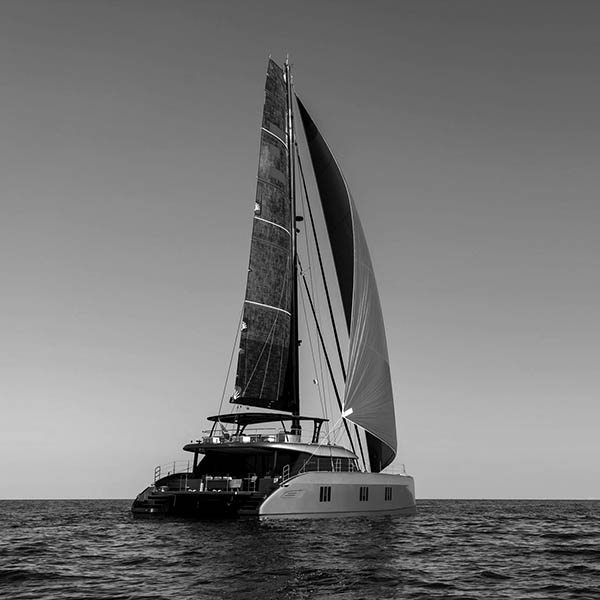
VIRTUAL TOUR
The 'e' team, josh bradley.
Languages: English, Irish
Growing up in the southern coast of Ireland, Josh's love for the outdoors came naturally. He first started sailing at the age of seven on a family vacation and hasn't looked back since. At eighteen, Josh moved to Mallorca to pursue a career onboard a sailing vessel. Since then, he has worked on a vast array of yachts that's taken him all around the globe - climbing the ranks, updating his skill set and qualifications to become a captain. His lust for new experiences and adventures will be sure to make your time onboard E an unforgettable experience. When he's not sailing, you'll find Josh under water scuba diving or climbing the highest peaks.
Kevin Lomba
Languages: French, English, Italian and Spanish
Kevin was born in Toulon, south of France, and grew up on the Provencal Mediterranean coastline. At the age of 18, he left the nest, and travelled to different countries, working mostly in the hospitality industry for 10 years. While in Auckland, New Zealand, he discovered yachting, and worked on deck for the following decade, sailing worldwide. He has been cooking and playing with food since the age of 13. His experience in hospitality and yachting has connected him to many chefs, who have served as endless sources of inspiration for him. Now based on the island of Mallorca, Spain, he runs a small permaculture project, where he grows organic vegetables throughout the winter, and teaches sustainability to the public. During the summers, Kevin reunites with the sea, and brings out his knives. A joyful person, he enjoys a warm atmosphere, with big laughs and full bellies. He hopes to facilitate an unforgettable experience onboard 'E' for you with his French, Mediterranean and creative cuisine.
Nicole Billitz
Languages: English, German
Nicole grew up in Miami, Florida and has known the water since birth. After finishing up two undergrad degrees, she took herself to Europe to do her Master’s, and discovered the mountains. A curious spirit, Nicole spent the last decade traveling the globe. Her independent adventures have led her around the world, across six continents, in a wide variety of service-oriented jobs. She is confident that her exposure to multiple cultures, etiquettes and cocktails has equipped her with the skills required to help facilitate the warmest hospitality experience possible. In her off time, Nicole travels from the water to the mountains and everywhere in between, worshipping the outdoors in some capacity. Most importantly, she undertakes every water sports opportunity possible, and is a bit of a showman for how spectacular she manages to fall off a board.
JOIN US ON BOARD
Charter 'e', from july 2024 in the mediterranean, from december 2024 in the caribbean.
Sint Marteen, Antigua, British Virgin Islands
We are keen on considering other destinations and bespoke itineraries upon request.
TASTE THE SEA MENU
TASTE THE SEA DRINKS MENU
Press review
'e' in the media.
Sunreef 60 E: Elu meilleur voilier électrique de 2021… more
Gustave Trouvé Electric Boat Awards Winners 2021… more
SuperyachtNews
Catamaran hints at path to full-electric… more
Catamaran Channel
Due to the smart technology this catamaran is using, this boat can cruise forever… more
Asia-Pacific Boating
Unveiled during this year’s Cannes Yachting Festival, the Sunreef 60 E belongs to Sunreef Yachts’ Eco-Electric line of custom catamarans. With electric propulsion and smart energy... more
Yacht Turkiye
Unveiled during this year’s Cannes Yachting Festival, the Sunreef 60 E belongs E is featured on the cover of the Yacht magazine and on the list of most environmentally friendly boats… more
Robb Report
If you’d like to finish off the year with a clear conscience, we’ve found the ideal eco-friendly charter yacht for your upcoming holiday voyage... more
Wiley Sharp
This was one of my favorite boats from the 2019 Cannes Yachting Festival. There were so many cool and unique features on the boat... more
Yachting World
Can luxury and sustainability co-exist? Toby Hodges walks you through Sunreef's latest supercat... more
Globetrender
Luxury charter yachting is to become kinder to the environment with the arrival of ‘E’, a new 60ft zero-carbon eco-catamaran that is powered by the sun, sea and wind... more
Designed to let its passengers enjoy the water in silence, E is a 60-foot sailing catamaran with electric propulsion… more
The Good Life
L’électrique a le vent en poupe, et pas seulement sur le marché de l’auto… more
Yachting Pleasure
The greener side of luxury on board… more
Skipper on Deck
With electric propulsion and smart energy management systems, Eco-Electric yachts offer a silent, vibration-free cruising experience… more
The Howorths
E marks a new chapter in the shipyard’s quest for a more sustainable cruising experience… more
The 7 Exclusive Journal
Les fondateurs de E sont partis avec l’idée de changer le visage de la plaisance afin de protéger les océans… more
Named ‚E’, the yacht is a state-of-the art luxury catamaran… more
Moncada Hispania
E is a luxury eco-catamaran powered by solar, sea and wind… more
The Wonder of Sound
We proudly donate a week's charter to the Wonder of Sound gala auction
Designed, hand-picked and crafted to perfection
Sailing In Style
Search this blog, the pioneers of eco-friendly catamarans.
As the world continues to struggle with climate change, the demand for sustainable solutions continues to grow across industries. Within the maritime world, eco-friendly yachts are at the top of the list. Catamarans combine luxury and sustainability in a unique way. Electric and hybrid engines power eco-friendly boats that not only reduce GHG emissions but also offer a quieter and more comfortable sailing experience. As we recently visited Monaco’s yacht show, we also decided to re-evaluate our plans and start looking for eco-friendliness in our blue water cruising.
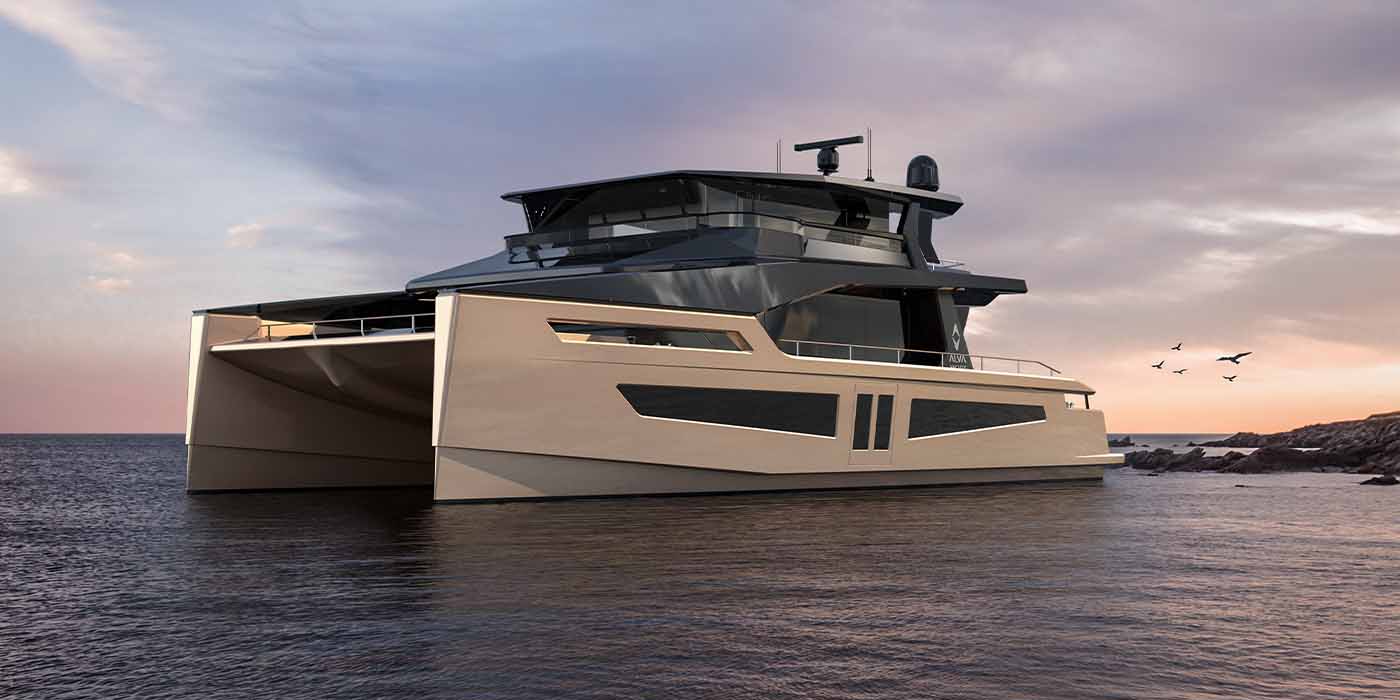
When it comes to size, eco-friendly boats don’t come at a huge price tag (about 800k approx), but they come with fewer maintenance costs, lower fuel consumption and greater independence. Let’s explore some of the manufacturers that are leading the way with eco-friendly yacht design. We took a more in-depth look at the existing models and requested the shipyards to provide their technical specs, price and any additional information they could provide.
Silent Yachts
Technical specifications.
- Length Overall (LOA): 54'10"
- Beam: 27'8"
- Draft: 3'11"
- Displacement: 38,000 lbs or 34,400 lbs
- Electric Motors: 2x 250-kW Dana TM4 E-motors
- Solar Generator: 1x 10,000 kWp
- Generator: 1x 100-kW Volvo Penta
- Fuel Capacity: 132 gal or 422 gal
- Water Capacity: 160 gal or 264 gal
Design and Usability
Environmental impact.
Shipyard : Italy Vessel Highlights : Silent 55 , Silent 60 , Silent 80 Overview : Silent 55 Solar-Electric Power Catamaran ( Power and Motoryacht ) Performance Reports : Reviewed for self-sufficiency in solar power utilization ( Silent 55 ), Review by Robb Report , Honest Review ( YouTube ) Starting Price : $1.55 million
Alva Yachts
- Length Overall (LOA): 18.40 m (60 ft)
- Length of Waterline: 17.80 m
- Beam: 10.20 m
- Draft: 1.2 m
- Displacement: 35,000 kg (35t)
- Propulsion:
- Electric Engines, 2 x 100 KW up to 2x350 KW
- Generator: 25 KVA up to 100 KVA - frequency driven DC
- Battery Capacity: 150 - 280 kWh
- Solar Power: 20 KW Peak
- Fuel: 500 - 1000 L
- Fresh Water: 500 - 1000 L
- Hot Water: 200 L
- Greywater Tank: 400 L
- Blackwater Tank: 400 L
Shipyard : Germany Vessel Highlights : Ocean Eco 60 , Ocean Eco 90 Overview: All available models via itboot.com Performance Reports : Reviewed for the blend of luxury and sustainability ( boats.com ), Next level electric in the Alva Eco 60 ( Sails Magazine) , ALVA ECO 60 Solar Powered Yacht ( YouTube ) Starting Price : €3.9 million
Nova Luxe Yachts
- Length Overall (LOA): 44'
- Beam: 21.5'
- Maximum Draft: 3'5"
- Bridge Clearance: 18'
- Dry Weight: 22,000 lbs
- Serial Hybrid:
- Standard Motor: Torqeedo Deep Blue 55kW, 80hp
- Upgraded Motor: Torqeedo Deep Blue 100kW, 160hp
- Parallel Hybrid:
- Engine 1: Yanmar 4LV150, Diesel, 150hp + Electric Motor, 20kW
- Engine 2: Yanmar 4LV150, Diesel, 150hp + Electric Motor, 20kW
- Maximum Speed: 16+ knots (Serial Hybrid), 18+ knots (Parallel Hybrid)
- Cruising Speed: Operate all day as electric at 6+ knots for 4+ hours
- Solar Array: 7 kW
- Battery Power: 92/172 kWh of Marinized LFP batteries
- Genset: 20kW Fischer Panda
- Electric System: Efficient 24v System with 110v/220v Appliances
Shipyard : USA (NYC) Vessel Highlight : ELight 40 - Elight 70 Overview : ELight 44 ( Multihulls World ) Performance Reports : Demonstrated accurate performance projections during sea trials ( Great Lakes ) Starting Price : $1.2 million
Principal Dimensions:
- Length Overall (LOA): 15.70 meters (51.5 feet)
- Beam: 8.40 meters (27 feet 7 inches)
- Draft: 1.30 meters (4 feet 4 inches)
- Displacement: 16,000 kg (35,280 lb)
- Solar Power : 17,000 W of peak solar power with a remarkable ratio of over 1 kW per displaced tonne of water, which is far beyond any other blue water CE Cat A yacht in this size range.
- Wingsail : The Zen 50 can be equipped with a fully automated wingsail developed by Ayro, which acts as a range and speed extender.
- Electric Propulsion : Powered by a high-capacity battery bank, allowing the Zen 50 to achieve speeds of up to 14 knots and maintain high continuous speeds indefinitely.
- Battery and Energy System :
- Battery Bank: 160 kWh capacity designed to function for days in complete safety with minimal solar energy harvest and no wind
- Maximum Speed: 14 knots
- Continuous Cruising Speed: Varying between 6 and 10 knots.
Additional Features
Shipyard : Malta Vessel Highlight : ZEN50 solar electric catamaran Performance Reports : Meet the Zen Yachts ZEN50 ( Inside EVs ) Starting Price : €2.4 million
Herley Boats
- Length Overall (LOA): 10.2 m
- Beam: 4.7 m
- Draft (including propeller): 0.77 m
- Engines: 2 x 100 kW peak electric motors, 60 kW continuous output, brushless, permanent magnet
- Diesel Generator: 120 kW
- Fuel Capacity: 640 L
- Water Capacity: 400 L
- Maximum Speed: 21 knots
- Cruise Speed: 14 knots
- Battery Only Max Speed: 12 knots
- Cruise Range (Hybrid): 1300 NM at 6 knots and 700 NM at 8 knots
- Battery Only Range: 34 NM at 6 knots and 18.5 NM at 8 knots (Solar input not included in these calculations)
- Battery Bank: 60 kWh Lithium-ion
- On-board Charging: 120 kW Diesel permanent magnet generator
- Material: 5083 Marine Grade Aluminium
- Fendering: Full length Aluminium Sheer Bump rail Aft Quarter Rail
Soel Yachts
- Length Overall (LOA): 11.80 m (39 ft)
- Beam: 5.80 m (19 ft)
- Draught: 0.70 m (2.3 ft)
- Displacement: 6 ton (13,200 lb)
- Solar Power: 8.6 kWp
- Battery Capacity: 2x 60 kWh
- Electric Motor: 2x 30 kW
- Maximum Speed (V_max): 13 knots
- Service Speed (V_service): 8 knots
- Break Even Speed (V_break even): 6 knots
Environmental Impact and Additional Features
Hh catamarans.
- Length Overall (LOA): 14.23m / 46ft 8in
- Length of Waterline (LWL): 13.28m / 43ft 7in
- Beam: 7.15m / 23ft 6in
- Draft (fixed keels): 1.52m / 5ft 0in
- Displacement (OC model): 8,750kg / 19,290lb
- Standard Propulsion:
- Electric Propulsion with Diesel Hybrid backup.
- Solar Capacity: 3,190 watts
- Hydro Power Generation: Shaft-drive folding propellers
- EcoDrive System:
- Silent fume-free motoring at 7.5 knots, instant torque for maneuvering, hydro-regeneration while sailing with diesel engines as a backup
- Construction Material: Carbon and Epoxy
- Features: Pre-preg carbon fiber C-shaped daggerboards
Post a Comment
- NEW : Our Second-Hand catamarans
- New Windelo 50 Adventure
- New Windelo 50 Yachting
- New Windelo 50 Sport
- New Windelo 54 Adventure
- New Windelo 54 Yachting
- New Windelo 54 Sport
- Our Second-Hand catamarans
- The Windelo Innovations : performant, comfortable and eco-friendly catamarans
- Ocean Future : our ecological approach
- The Windelo Services
- Charter a Windelo catamaran
- The Windelo Shipyard
- Windelo Team
- Recruitment : Join the Windelo team

NEW WINDELO 50 ADVENTURE
Features of windelo 50.
The Windelo 50 sets the standard for environmentally friendly fast cruising catamarans. This yacht is equipped to take you to Patagonia via the Pacific Islands, leaving zero carbon footprint, except if you sail under power for a long time. The Windelo 50 delivers outstanding performance and high levels of comfort combined with a sturdiness that inspires trust. This is a yacht that is just begging you to dare to dream. Step aboard and start your own adventure. The Windelo 50 is tailored for sailors with vast horizons. One look at the slightly fuller lines at the entrance than some other catamarans, confirms the architect duo Christophe Barreau and Frederic Neuman have designed a boat that performs well even when it is fully loaded for a blue water adventure. Combine this with a powerful rig, modest displacement, and daggerboards to ensure that you can cover broad stretches of the ocean at speed without having to cut back on vital equipment needed to travel in comfort.
The nacelle: a user-friendly and modular space
The key to the layout was to create a friendly space that worked for everyone and involved everyone. The first essential step was to ensure that the helm station was an integral part of the layout. You can create a spacious unified area where the skipper steps out of isolation and integrates fully into the onboard social life by opening the sliding door between the forward cockpit and the galley. With the help of autopilot, you could easily cook and steer simultaneously! It also means that crew who are relaxing in the saloon are readily available to lend a hand at a moment's notice. There are other thoughtful practical benefits, such as the highly comfortable 115 x 200 cm pilot berth, situated in the main saloon within easy reach of the helm.
There is a chart table at the foot of the forward cockpit in the saloon layout, which makes circulation on board easier. To give you an idea of the space available: the saloon dining table expands to accommodate 6 to 12 people. You can also use an additional outside table for 6 to 12 people at anchor.
Depending on the power output of your solar panels, the nacelle roof can be fitted with sun pads for sunbathing at anchor.
Features of Adventure version
For you, does sailing rhyme with adventure, crossing the oceans, and beautiful discoveries? Wind &, turquoise water, endless horizons, and magical sunsets on a remote island? Do you search for freedom and to reconnect with yourself and the nature around you? You love your planet, and you wish to sail by respecting this beautiful world around you?
Then the Windelo Adventure is just the boat for you! So follow your dreams, and let's get away from it all! Let's feel the breeze and savor life. Your next adventure will start here!
The Adventure version is the most accessible boat. Designed for exploration and adventure, her hull protections have been upgraded. The materials used are robust and easy to maintain, allowing alterations onboard in keeping with requirements. This version comes with lifting centerboards or high-performance fixed fin keels. Her characteristics make her particularly open to charter. Her equipment focuses on managing resources and waste.

Guided Tour of Windelo 50 Adventure

360° virtual visit All areas of our Windelo 50 Adventure
Videos at sea.

Floor plans

Technical details

Windelo range brochure
To download our Windelo range brochure, add your email address and click on the download button!
SALES MANAGER
Windelo is a new conception brand of innovative catamarans. Ecology is at the heart of the company with the ambition to significantly reduce the environmental impact of our boats. A range of 44 to 60 foot catamarans offering sailors the opportunity to sail with pleasure and safety on eco-friendly boats.
In full development, we are hiring a sales manager:
JOB AND MISSIONS: Managed by the director of the company, and in connection with our various services and partners, you are a key player in the launch of this new brand.
Real project manager: 1. You co-build the Windelo sales and services office, 2. You recruit, train, and drive progressively a team of passionate experts, 3. You develop and innovate in the strategy of selling Windelo boats in Europe, 4. You recruit and lead a global network of sales partners, 5. You co-build and animate the company’s service strategy: port mapping places; insurance and financing; training; owner’s manual etc.
YOUR PROFIL 1. Passionate about sailing, you practice regularly, 2. Your sense of service and customer leads you to satisfy your customers every day, 3. You are enthusiastic and motivated to work in a start-up, 4. You have 2 to 5 years’ experience in the sale of boats, 5. Bilingual French – English, you also speak a third language: German, Italian, or Spanish.
EVOLUTIVE JOB Director of sales
AVAILABILITY / PLACE OF WORK 1st Quarter 2019 / Occitanie Region, Canet en Roussillon FRANCE
TYPE OF CONTRACT AND REMUNERATION Permanent contract / fixed to be defined according to experience + variable.
If you are a passionate of sailing and this challenge to participate in the development of a company in full creation arouses your enthusiasm, welcome to send your application by e-mail to: contact@windelo-catamaran.com
RESPONSABLE DES VENTES
Windelo consiste en la création d’une nouvelle marque de catamarans innovants. L’écologie est au coeur de l’entreprise avec pour ambition de réduire fortement l’impact environnemental de nos bateaux. Une gamme de catamarans de 44 à 60 pieds offrant aux marins la possibilité de naviguer avec plaisir et sécurité sur des bateaux éco responsables.
En plein développement, nous recrutons un(e) responsable des ventes
POSTE ET MISSIONS
Managé(e) par le directeur de l’entreprise, et en lien avec nos différents services et partenaires, vous êtes un acteur clefs du lancement de cette nouvelle marque. Véritable chef de projet :
1. Vous co-construisez le bureau des ventes et des services de Windelo, 2. Vous recrutez, formez, et animez progressivement une équipe d’experts passionnés, 3. Vous développez et innovez dans la stratégie de vente des bateaux Windelo en Europe, 4. Vous recrutez et animez un réseau mondial de partenaires de vente, 5. Vous co-construisez et animez la stratégie de service de l’entreprise : mapping des places de port ; assurance et financement ; formation ; entretien ; manuel du propriétaire etc.
VOTRE PROFIL 1. Passionné(e) de nautisme, vous naviguez régulièrement, 2. Votre sens du service et du client vous anime pour satisfaire vos clients au quotidien, 3. Vous êtes enthousiaste et motivé(e) à l’idée de travailler en équipe dans une « start-up », 4. Vous disposez de 2 à 5 ans d’expérience dans la vente de bateaux de plaisance, 5. Bilingue français – anglais, vous maitrisez également une troisième langue : allemand, italien, ou espagnol.
POSTE EVOLUTIF Directeur des ventes
DISPONIBILITÉ / LIEU DE TRAVAIL 1ier Trimestre 2019 / Région Occitanie, Canet en Roussillon FRANCE
TYPE DE CONTRAT ET REMUNERATION CDI Cadre / Fixe à définir selon expérience + variable.
Si vous êtes un(e) passionné(e) de l’univers du nautisme et que ce challenge de participer au développement d’une entreprise en pleine création suscite votre enthousiasme, merci d’adresser votre candidature par e-mail à : contact@windelo-catamaran.com
As part of the creation of new types of catamaran made in Occitanie, an audacious choice of ecological innovation has been selected in partnership with the Materials Center of « Mines d’Alès » (C2MA – IMT MINES ALES) (Gard, France). It’s a question of combining ecological performance in terms of minimizing the environmental footprint and structural resistance, and this, in a global approach of circular economy on all parts of the boat. To do this, and in connection with the IMT MINES ALES, Windelo has relied on the use of secondary raw materials, competitive virgin petroleum-based materials, that fully comply with the specifications in terms of mechanical performance. This is a real first step to the development of a 2.0 fleet ships fully integrated into the challenges and ecological challenges of the 21st century.
Associated with an ecological approach of circular economy integrating a not insignificant part of competitive secondary raw materials from virgin materials, the architectural design and the resistance of materials on the new Windelo catamarans are mechanically tested in the Materials Center of « Mines d’Alès » (C2MA – IMT MINES ALES) (Gard, France) in connection with the architects and designers of the project. The design of the ship, and in particular the hulls and bows, go through a search for efficient structuring and arranging of materials composing it, combined with a mechanically optimized geometrical assembly. To this end, specific test developments, such as the study of distortion of the structure and of the panels constituating the hull of the ship, are studied by digital image correlation techniques coupled with standardized strength tests.
Founder of Catana
“The cruising program for this new boat raises the question of the antagonism between the search for performance under sail and the pleasure of navigation, and the development of pleasant living spaces. The originality of the answer is provided here in the arrangement of the cockpit bringing together the helm and maneuvers to the center of the boat and in the arrangement of living space that occupies the rear of the nacelle.
Just behind the mast the outer cockpit offers two helm stations protected from the wind and spray, a beautiful view of the sails and bows, and allows to have all the maneuvers on hand while limiting the needs to circulate on the bridge. Out of navigation, the cockpit can be more widely protected from the outside and open to the rear space.
Fully opened behind this cockpit, we have not developed two living spaces duplicating one inside the other but a single large space which is ajustable. We have focused our efforts on the geometry of the material and visual limits of this space and on the opening kinematics of the bays. Once opened, they “disappear” to transform the interior into an exterior. The generosity of these openings also allows to modulate the ventilation of this space by playing on a wide range of opening on its four sides
This work on the modularity and the disappearance of limits is found at the extreme rear of the nacelle, with an articulated platform to the davits transforming it into a floor when anchored, and in the rear cabins, whose wide turning porthole eliminates the angle between side plating and back side. The cabin space is therefore generous despite the relative narrowness of the hulls.
All these choices allow us to combine a contained hold of the nacelle, pledge control of the weight estimate, to a generous living space, with a central part given to navigation and maneuvering. The slenderness of the forward spikes, the significant free height under the platform, and the attention paid to the centering of the masses, complete the marine qualities expected for an offshore navigation program.
The other originality of the project brought by this new construction site is in the approach of “eco-design” on materials and construction. Strongly limiting the use of molds, the latter brings a greater margin of freedom in the variations and evolutions of the boats thus conceived. ”
Christophe Barreau et Frédéric Neuman
Architects and Naval Engineers
Who could know if it is the father or the son who is the most passionate? It doesn’t matter. The important thing is to write an innovative project within a family culture, for today and for generations to come. Hand over the guiding light, this is Olivier Kauffmann’s will. “At first I wanted to make my own boat, for me and my family; go on trip around the world living on a efficient and pleasant catamaran. I dreamed of a new quality of space. Today, the dream has matured, and I want to share it with the great family of sailors. »
Windelo is the desire to expose us to something new, innovative, powerful, bigger than oneself. To seek innovations on materials, techniques of industrialization and uses to impulse a new economic reality. “We want to be part of this transformation related to the respect of our environment, it is for us, essential to work in this respect of men and nature. Men are at the heart of the project with the desire to recruit and form a passionate team, surrounded by experts recognized as the best in their field.
And the innovation doesn’t stop here, because the constructive process makes it possible to envisage fast evolutions from one boat to another while remaining well priced. An ambitious and respectful project ; Welcome to the Windelo adventure.
Dans le cadre de la confection de nouveaux types de catamaran made in Occitanie, un choix audacieux d’innovation écologique a été retenu en partenariat avec le Centre des Matériaux des Mines d’Alès (C2MA – IMT MINES ALES) (Gard). Il s’agit à la fois d’allier performance écologique en termes de minimisation de l’empreinte environnementale et résistance des structures, et ce, dans une démarche globale d’économie circulaire sur l’ensemble des parties du bateau. Pour ce faire, et en lien avec l’IMT MINES ALES, Windelo a misé sur l’utilisation de matières premières secondaires, compétitives des matériaux pétrosourcés vierges, et parfaitement conformes au cahier des charges sur le plan des performances mécaniques. C’est un réel premier pas vers l’élaboration d’une flotte de navires 2.0 s’intégrant complètement dans les enjeux et défis écologiques du XXIème siècle.
Associées à une démarche écologique d’économie circulaire intégrant une part non négligeable de matières premières secondaires concurrentielles des matières vierges, l’architecture de conception et la résistance des matériaux des nouveaux catamarans de Windelo sont éprouvées par des tests mécaniques réalisés au Centre des Matériaux des Mines d’Alès (C2MA – IMT MINES ALES) (Gard) en lien avec les architectes et designers du projet. La conception du navire, et en particulier les bordées et étraves, passe par une recherche de structuration performante de l’agencement des matériaux le composant, combinée à une géométrie d’assemblage optimisée sur le plan mécanique. Pour ce faire, des développements d’essais spécifiques, comme l’étude de la déformation de la structure des panneaux constituant la coque du navire, sont étudiés par des techniques de corrélation d’image numériques couplés à des essais de résistance mécanique normalisés.
La rencontre avec Olivier et Gautier a été une agréable surprise pour moi, dès l’exposé de leur projet, j’ai vu réunis tous les ingrédients d’une réussite, l’expérience de gestion d’entreprises mais avec une modestie rassurante, le souci de former une équipe des meilleurs experts (sourire) et une réelle écoute de leurs avis. Au fil des rencontres, les discussions ont ravivé mes souvenirs de la création puis du développement de Catana. Les mêmes motivations, la même recherche de perfection, la même audace teintée de modestie que nous avions au départ du projet. Windelo est centrée sur le produit ; une ligne de catamarans performants construits avec les techniques les plus modernes. Je n’en avais pas conscience à l’époque mais je crois que le succès d’un bon bateau vient de cette passion pour la mer avec la volonté de marier confort sécurité et performance. Je retrouve ici cette passion, et aujourd’hui ce qui a fini de me conquérir c’est le souci de préservation de la nature, tant dans les matériaux choisis que dans les méthodes de production.
Le programme de grande croisière auquel se destine ce nouveau bateau pose la question de l’antagonisme entre d’une part la recherche de performances sous voiles et du plaisir de navigation, et d’autre part l’aménagement d’espaces de vie agréables et généreux. L’originalité de la réponse apportée ici réside dans la disposition du cockpit rassemblant poste de barre et manœuvres au centre du bateau et dans le traitement de l’espace de vie qui occupe l’arrière de la nacelle. Juste en arrière du mât le cockpit extérieur offre deux postes de barre protégés du vent et des embruns, une belle vue sur les voiles et sur les étraves, et permet d’avoir l’ensemble des manœuvres à portée de main tout en limitant les besoins de circuler sur le pont. Hors navigation, le cockpit peut être plus largement protégé de l’extérieur et s’ouvrir sur l’espace arrière. De plein pied en arrière de ce cockpit, nous n’avons pas aménagé deux espaces de vie dupliqués l’un à l’intérieur et l’autre à l’extérieur mais un seul grand espace dont le degré d’ouverture est très largement modulable. Nous avons porté notre effort sur la géométrie des limites matérielles et visuelles de cet espace et sur les cinématiques d’ouverture des baies. Une fois ouvertes elles « disparaissent » pour transformer l’intérieur en extérieur. La générosité des ouvrants permet également de moduler la ventilation de cet espace en jouant sur une large gamme d’ouverture sur ses quatre côtés Ce travail sur la modularité et sur la disparition des limites se retrouve à l’extrême arrière de la nacelle, avec une plateforme articulée aux bossoirs se transformant en plancher au mouillage, et dans les cabines arrières dont le large hublot tournant fait « sauter » l’angle entre bordé latéral et face arrière. L’espace de cabine est donc généreux malgré la relative étroitesse des coques. L’ensemble de ces choix nous permet de conjuguer une emprise contenue de la nacelle, gage de maîtrise du devis de poids, à un espace à vivre généreux, avec une place centrale accordée à la navigation et aux manœuvres. L’élancement des pointes avant, l’importante hauteur libre sous nacelle, et l’attention portée au centrage des masses, complètent les qualités marines attendues pour un programme de navigation hauturière. L’autre originalité du projet apportée par ce nouveau chantier se trouve dans l’approche d’« éco-conception » portant sur les matériaux et le mode constructif. Limitant fortement le recours aux moules ce dernier apporte une plus grande marge de liberté dans les déclinaisons et évolutions des bateaux ainsi conçus.
Qui sait lequel du père ou du fils est le plus passionné ? Peu importe. L’important ici est d’écrire un projet innovant au sein d’une culture familiale, pour aujourd’hui et les générations à venir. Passer le flambeau, le relais ; c’est la volonté d’Olivier Kauffmann. « Au début je voulais me faire mon propre bateau, pour ma famille et moi ; partir faire un tour du monde sur un catamaran performant et plaisant à vivre. Je rêvais à une qualité d’espace inédite. Aujourd’hui, l’envie a mûrit, et je tiens à le partager avec la grande famille des marins ».
Windelo c’est l’envie de s’exposer à quelque chose de nouveau, d’innovant, de performant, de plus grand que soi. Aller chercher des innovations sur des matériaux, des techniques d’industrialisation, des usages et impulser une nouvelle réalité économique. « Nous voulons faire partie de cette transformation liée au respect de notre environnement, c’est pour nous indispensable d’œuvrer dans ce respect des hommes et de la nature. Les hommes sont au cœur du projet avec la volonté de recruter et former une équipe de passionnés, entourés d’experts reconnus comme les meilleurs dans leur domaine ».
Et l’innovation ne s’arrête pas là, car le process constructif permet d’envisager des évolutions rapides d’un bateau à un autre tout en restant bien placé en prix. Projet ambitieux et respectueux, bienvenu(e) dans l’aventure Windelo.
- You are on Realigro website
- Russian Federation
- Sverdlovsk Oblast
- EKATERINBURG
- List your properties
- Estate agents
- Private seller
- Property portals
Preferences
- Publish your free listing
- Rent-holidays
For sale 1 Bedroom, EKATERINBURG, Sverdlovsk Oblast, Russian Federation, Sherbaova 77
- Send to a friend
- Add to favourites
- Email alert
- Report an error

For sale - Cod. 29133
- Tipology: 1 Bedroom
- Area: 43 m²
- Rooms No.: 1
- Publication date announcement: 26/08/2016
Hello, we are the owners, Irina and Oleg. We sell a bright, comfortable and very beautiful flat, designed in a Scandinavian style. The flat created "for himself", but forced to sell due to moving to Moscow. ( We bought and renovated this flat for us but we have time sell it due to ...) The flat is located in a picturesque location near the Uktus mountains. The residential complex Stony Brook. In the flat: - All necessary equipment. (Dishwasher, washing machine, oven, refrigerator, range hood, stove, TV, microwave, coffee machine) - 2 wardrobes - Ennobled balcony where you can enjoy beautiful views of the forest and mountains, and dream about the most valuable. - Cable TV, wireless internet. - Increased size of window openings make the flat extremely bright. - All items and accessories are in the flat. In building: - High-speed elevator otis, which descends directly into the underground parking. - Concierge. - Courtyard complex located on the podium, which is located at 3 floors. House territory developed according to modern requirements - as a sport, and a playground with a safe finish. - On the first floor there is a trading gallery with a large grocery store, pharmacy, children's and sports goods, cafés and restaurants. The complex has a fitness club. Area: - In walking distance from the complex there is a shopping center "Globus" Waterpark "Limpopo", sports complex, "Planet IGRIK" (children's entertainment center), ICE (fitness center), the ski slopes and ski resorts, subway Botanica. - 8 km to the center. - 100 m bus stop
Page views divided according to country of origin
Change date interval 1 month 2 months 6 months

Price trend (USD/m²)
Inquiry for more info, highlight listings.
For a better use of Realigro website, set your preferences for language, currency, square meters or sq ft.
- Places - European, Western and Northern Russia
YEKATERINBURG: FACTORIES, URAL SIGHTS, YELTSIN AND THE WHERE NICHOLAS II WAS KILLED
Sverdlovsk oblast.
Sverdlovsk Oblast is the largest region in the Urals; it lies in the foothills of mountains and contains a monument indicating the border between Europe and Asia. The region covers 194,800 square kilometers (75,200 square miles), is home to about 4.3 million people and has a population density of 22 people per square kilometer. About 83 percent of the population live in urban areas. Yekaterinburg is the capital and largest city, with 1.5 million people. For Russians, the Ural Mountains are closely associated with Pavel Bazhov's tales and known for folk crafts such as Kasli iron sculpture, Tagil painting, and copper embossing. Yekaterinburg is the birthplace of Russia’s iron and steel industry, taking advantage of the large iron deposits in the Ural mountains. The popular Silver Ring of the Urals tourist route starts here.
In the summer you can follow in the tracks of Yermak, climb relatively low Ural mountain peaks and look for boulders seemingly with human faces on them. You can head to the Gemstone Belt of the Ural mountains, which used to house emerald, amethyst and topaz mines. In the winter you can go ice fishing, ski and cross-country ski.
Sverdlovsk Oblast and Yekaterinburg are located near the center of Russia, at the crossroads between Europe and Asia and also the southern and northern parts of Russia. Winters are longer and colder than in western section of European Russia. Snowfalls can be heavy. Winter temperatures occasionally drop as low as - 40 degrees C (-40 degrees F) and the first snow usually falls in October. A heavy winter coat, long underwear and good boots are essential. Snow and ice make the sidewalks very slippery, so footwear with a good grip is important. Since the climate is very dry during the winter months, skin moisturizer plus lip balm are recommended. Be alert for mud on street surfaces when snow cover is melting (April-May). Patches of mud create slippery road conditions.
Yekaterinburg
Yekaterinburg (kilometer 1818 on the Trans-Siberian Railway) is the fourth largest city in Russia, with of 1.5 million and growth rate of about 12 percent, high for Russia. Located in the southern Ural mountains, it was founded by Peter the Great and named after his wife Catherine, it was used by the tsars as a summer retreat and is where tsar Nicholas II and his family were executed and President Boris Yeltsin lived most of his life and began his political career. The city is near the border between Europe and Asia.
Yekaterinburg (also spelled Ekaterinburg) is located on the eastern slope of the Ural Mountains in the headwaters of the Iset and Pyshma Rivers. The Iset runs through the city center. Three ponds — Verkh-Isetsky, Gorodskoy and Nizhne-Isetsky — were created on it. Yekaterinburg has traditionally been a city of mining and was once the center of the mining industry of the Urals and Siberia. Yekaterinburg remains a major center of the Russian armaments industry and is sometimes called the "Pittsburgh of Russia.". A few ornate, pastel mansions and wide boulevards are reminders of the tsarist era. The city is large enough that it has its own Metro system but is characterized mostly by blocky Soviet-era apartment buildings. The city has advanced under President Vladimir Putin and is now one of the fastest growing places in Russia, a country otherwise characterized by population declines
Yekaterinburg is technically an Asian city as it lies 32 kilometers east of the continental divide between Europe and Asia. The unofficial capital of the Urals, a key region in the Russian heartland, it is second only to Moscow in terms of industrial production and capital of Sverdlovsk oblast. Among the important industries are ferrous and non-ferrous metallurgy, machine building and metalworking, chemical and petrochemicals, construction materials and medical, light and food industries. On top of being home of numerous heavy industries and mining concerns, Yekaterinburg is also a major center for industrial research and development and power engineering as well as home to numerous institutes of higher education, technical training, and scientific research. In addition, Yekaterinburg is the largest railway junction in Russia: the Trans-Siberian Railway passes through it, the southern, northern, western and eastern routes merge in the city.
Accommodation: There are two good and affordable hotels — the 3-star Emerald and Parus hotels — located close to the city's most popular landmarks and main transport interchanges in the center of Yekaterinburg. Room prices start at RUB 1,800 per night.
History of Yekaterinburg
Yekaterinburg was founded in 1723 by Peter the Great and named after his wife Catherine I. It was used by the tsars as a summer retreat but was mainly developed as metalworking and manufacturing center to take advantage of the large deposits of iron and other minerals in the Ural mountains. It is best known to Americans as the place where the last Tsar and his family were murdered by the Bolsheviks in 1918 and near where American U-2 spy plane, piloted by Gary Powers, was shot down in 1960.
Peter the Great recognized the importance of the iron and copper-rich Urals region for Imperial Russia's industrial and military development. In November 1723, he ordered the construction of a fortress factory and an ironworks in the Iset River Valley, which required a dam for its operation. In its early years Yekaterinburg grew rich from gold and other minerals and later coal. The Yekaterinburg gold rush of 1745 created such a huge amount of wealth that one rich baron of that time hosted a wedding party that lasted a year. By the mid-18th century, metallurgical plants had sprung up across the Urals to cast cannons, swords, guns and other weapons to arm Russia’s expansionist ambitions. The Yekaterinburg mint produced most of Russia's coins. Explorations of the Trans-Baikal and Altai regions began here in the 18th century.
Iron, cast iron and copper were the main products. Even though Iron from the region went into the Eiffel Tower, the main plant in Yekaterinburg itself was shut down in 1808. The city still kept going through a mountain factory control system of the Urals. The first railway in the Urals was built here: in 1878, the Yekaterinburg-Perm railway branch connected the province's capital with the factories of the Middle Urals.
In the Soviet era the city was called Sverdlovsk (named after Yakov Sverdlov, the man who organized Nicholas II's execution). During the first five-year plans the city became industrial — old plants were reconstructed, new ones were built. The center of Yekaterinburg was formed to conform to the historical general plan of 1829 but was the layout was adjusted around plants and factories. In the Stalin era the city was a major gulag transhipment center. In World War II, many defense-related industries were moved here. It and the surrounding area were a center of the Soviet Union's military industrial complex. Soviet tanks, missiles and aircraft engines were made in the Urals. During the Cold War era, Yekaterinburg was a center of weapons-grade uranium enrichment and processing, warhead assembly and dismantlement. In 1979, 64 people died when anthrax leaked from a biological weapons facility. Yekaterinburg was a “Closed City” for 40 years during the Cold Soviet era and was not open to foreigners until 1991
In the early post-Soviet era, much like Pittsburgh in the 1970s, Yekaterinburg had a hard struggle d to cope with dramatic economic changes that have made its heavy industries uncompetitive on the world market. Huge defense plants struggled to survive and the city was notorious as an organized crime center in the 1990s, when its hometown boy Boris Yeltsin was President of Russia. By the 2000s, Yekaterinburg’s retail and service was taking off, the defense industry was reviving and it was attracting tech industries and investments related to the Urals’ natural resources. By the 2010s it was vying to host a world exhibition in 2020 (it lost, Dubai won) and it had McDonald’s, Subway, sushi restaurants, and Gucci, Chanel and Armani. There were Bentley and Ferrari dealerships but they closed down
Transportation in Yekaterinburg
Getting There: By Plane: Yekaterinburg is a three-hour flight from Moscow with prices starting at RUB 8,000, or a 3-hour flight from Saint Petersburg starting from RUB 9,422 (direct round-trip flight tickets for one adult passenger). There are also flights from Frankfurt, Istanbul, China and major cities in the former Soviet Union.
By Train: Yekaterinburg is a major stop on the Trans-Siberian Railway. Daily train service is available to Moscow and many other Russian cities.Yekaterinburg is a 32-hour train ride from Moscow (tickets RUB 8,380 and above) or a 36-hour train ride from Saint Petersburg (RUB 10,300 and above). The ticket prices are round trip for a berth in a sleeper compartment for one adult passenger). By Car: a car trip from Moscow to Yekateringburg is 1,787 kilometers long and takes about 18 hours. The road from Saint Petersburg is 2,294 kilometers and takes about 28 hours.
Regional Transport: The region's public transport includes buses and suburban electric trains. Regional trains provide transport to larger cities in the Ural region. Buses depart from Yekaterinburg’s two bus stations: the Southern Bus Station and the Northern Bus Station.
Regional Transport: According the to Association for Safe International Road Travel (ASIRT): “Public transportation is well developed. Overcrowding is common. Fares are low. Service is efficient. Buses are the main form of public transport. Tram network is extensive. Fares are reasonable; service is regular. Trams are heavily used by residents, overcrowding is common. Purchase ticket after boarding. Metro runs from city center to Uralmash, an industrial area south of the city. Metro ends near the main railway station. Fares are inexpensive.
“Traffic is congested in city center. Getting around by car can be difficult. Route taxis (minivans) provide the fastest transport. They generally run on specific routes, but do not have specific stops. Drivers stop where passengers request. Route taxis can be hailed. Travel by bus or trolleybuses may be slow in rush hour. Trams are less affected by traffic jams. Trolley buses (electric buses) cannot run when temperatures drop below freezing.”
Entertainment, Sports and Recreation in Yekaterinburg
The performing arts in Yekaterinburg are first rate. The city has an excellent symphony orchestra, opera and ballet theater, and many other performing arts venues. Tickets are inexpensive. The Yekaterinburg Opera and Ballet Theater is lavishly designed and richly decorated building in the city center of Yekaterinburg. The theater was established in 1912 and building was designed by architect Vladimir Semyonov and inspired by the Vienna Opera House and the Theater of Opera and Ballet in Odessa.
Vaynera Street is a pedestrian only shopping street in city center with restaurants, cafes and some bars. But otherwise Yekaterinburg's nightlife options are limited. There are a handful of expensive Western-style restaurants and bars, none of them that great. Nightclubs serve the city's nouveau riche clientele. Its casinos have closed down. Some of them had links with organized crime. New dance clubs have sprung up that are popular with Yekaterinburg's more affluent youth.
Yekaterinburg's most popular spectator sports are hockey, basketball, and soccer. There are stadiums and arenas that host all three that have fairly cheap tickets. There is an indoor water park and lots of parks and green spaces. The Urals have many lakes, forests and mountains are great for hiking, boating, berry and mushroom hunting, swimming and fishing. Winter sports include cross-country skiing and ice skating. Winter lasts about six months and there’s usually plenty of snow. The nearby Ural Mountains however are not very high and the downhill skiing opportunities are limited..
Sights in Yekaterinburg
Sights in Yekaterinburg include the Museum of City Architecture and Ural Industry, with an old water tower and mineral collection with emeralds. malachite, tourmaline, jasper and other precious stone; Geological Alley, a small park with labeled samples of minerals found in the Urals region; the Ural Geology Museum, which houses an extensive collection of stones, gold and gems from the Urals; a monument marking the border between Europe and Asia; a memorial for gulag victims; and a graveyard with outlandish memorials for slain mafia members.
The Military History Museum houses the remains of the U-2 spy plane shot down in 1960 and locally made tanks and rocket launchers. The fine arts museum contains paintings by some of Russia's 19th-century masters. Also worth a look are the History an Local Studies Museum; the Political History and Youth Museum; and the University and Arboretum. Old wooden houses can be seen around Zatoutstovsya ulitsa and ulitsa Belinskogo. Around the city are wooded parks, lakes and quarries used to harvest a variety of minerals. Weiner Street is the main street of Yekaterinburg. Along it are lovely sculptures and 19th century architecture. Take a walk around the unique Literary Quarter
Plotinka is a local meeting spot, where you will often find street musicians performing. Plotinka can be described as the center of the city's center. This is where Yekaterinburg holds its biggest events: festivals, seasonal fairs, regional holiday celebrations, carnivals and musical fountain shows. There are many museums and open-air exhibitions on Plotinka. Plotinka is named after an actual dam of the city pond located nearby (“plotinka” means “a small dam” in Russian).In November 1723, Peter the Great ordered the construction of an ironworks in the Iset River Valley, which required a dam for its operation. “Iset” can be translated from Finnish as “abundant with fish”. This name was given to the river by the Mansi — the Finno-Ugric people dwelling on the eastern slope of the Northern Urals.
Vysotsky and Iset are skyscrapers that are 188.3 meters and 209 meters high, respectively. Fifty-story-high Iset has been described by locals as the world’s northernmost skyscraper. Before the construction of Iset, Vysotsky was the tallest building of Yekaterinburg and Russia (excluding Moscow). A popular vote has decided to name the skyscraper after the famous Soviet songwriter, singer and actor Vladimir Vysotsky. and the building was opened on November 25, 2011. There is a lookout at the top of the building, and the Vysotsky museum on its second floor. The annual “Vysotsky climb” (1137 steps) is held there, with a prize of RUB 100,000. While Vysotsky serves as an office building, Iset, owned by the Ural Mining and Metallurgical Company, houses 225 premium residential apartments ranging from 80 to 490 square meters in size.
Boris Yeltsin Presidential Center
The Boris Yeltsin Presidential Center (in the city center: ul. Yeltsina, 3) is a non-governmental organization named after the first president of the Russian Federation. The Museum of the First President of Russia as well as his archives are located in the Center. There is also a library, educational and children's centers, and exposition halls. Yeltsin lived most of his life and began his political career in Yekaterinburg. He was born in Butka about 200 kilometers east of Yekaterinburg.
The core of the Center is the Museum. Modern multimedia technologies help animate the documents, photos from the archives, and artifacts. The Yeltsin Museum holds collections of: propaganda posters, leaflets, and photos of the first years of the Soviet regime; portraits and portrait sculptures of members of Politburo of the Central Committee of the Communist Party of various years; U.S.S.R. government bonds and other items of the Soviet era; a copy of “One Day in the Life of Ivan Denisovich” by Alexander Solzhenitsyn, published in the “Novy Mir” magazine (#11, 1962); perestroika-era editions of books by Alexander Solzhenitsyn, Vasily Grossman, and other authors; theater, concert, and cinema posters, programs, and tickets — in short, all of the artifacts of the perestroika era.
The Yeltsin Center opened in 2012. Inside you will also find an art gallery, a bookstore, a gift shop, a food court, concert stages and a theater. There are regular screenings of unique films that you will not find anywhere else. Also operating inside the center, is a scientific exploritorium for children. The center was designed by Boris Bernaskoni. Almost from the its very opening, the Yeltsin Center has been accused by members of different political entities of various ideological crimes. The museum is open Tuesday to Sunday, from 10:00am to 9:00pm.
Where Nicholas II was Executed
On July, 17, 1918, during this reign of terror of the Russian Civil War, former-tsar Nicholas II, his wife, five children (the 13-year-old Alexis, 22-year-old Olga, 19-year-old Maria and 17-year-old Anastasia)the family physician, the cook, maid, and valet were shot to death by a Red Army firing squad in the cellar of the house they were staying at in Yekaterinburg.
Ipatiev House (near Church on the Blood, Ulitsa Libknekhta) was a merchant's house where Nicholas II and his family were executed. The house was demolished in 1977, on the orders of an up and coming communist politician named Boris Yeltsin. Yeltsin later said that the destruction of the house was an "act of barbarism" and he had no choice because he had been ordered to do it by the Politburo,
The site is marked with s cross with the photos of the family members and cross bearing their names. A small wooden church was built at the site. It contains paintings of the family. For a while there were seven traditional wooden churches. Mass is given ay noon everyday in an open-air museum. The Church on the Blood — constructed to honor Nicholas II and his family — was built on the part of the site in 1991 and is now a major place of pilgrimage.
Nicholas and his family where killed during the Russian civil war. It is thought the Bolsheviks figured that Nicholas and his family gave the Whites figureheads to rally around and they were better of dead. Even though the death orders were signed Yakov Sverdlov, the assassination was personally ordered by Lenin, who wanted to get them out of sight and out of mind. Trotsky suggested a trial. Lenin nixed the idea, deciding something had to be done about the Romanovs before White troops approached Yekaterinburg. Trotsky later wrote: "The decision was not only expedient but necessary. The severity of he punishment showed everyone that we would continue to fight on mercilessly, stopping at nothing."
Ian Frazier wrote in The New Yorker: “Having read a lot about the end of Tsar Nicholas II and his family and servants, I wanted to see the place in Yekaterinburg where that event occurred. The gloomy quality of this quest depressed Sergei’s spirits, but he drove all over Yekaterinburg searching for the site nonetheless. Whenever he stopped and asked a pedestrian how to get to the house where Nicholas II was murdered, the reaction was a wince. Several people simply walked away. But eventually, after a lot of asking, Sergei found the location. It was on a low ridge near the edge of town, above railroad tracks and the Iset River. The house, known as the Ipatiev House, was no longer standing, and the basement where the actual killings happened had been filled in. I found the blankness of the place sinister and dizzying. It reminded me of an erasure done so determinedly that it had worn a hole through the page. [Source: Ian Frazier, The New Yorker, August 3, 2009, Frazier is author of “Travels in Siberia” (2010)]
“The street next to the site is called Karl Liebknecht Street. A building near where the house used to be had a large green advertisement that said, in English, “LG—Digitally Yours.” On an adjoining lot, a small chapel kept the memory of the Tsar and his family; beneath a pedestal holding an Orthodox cross, peonies and pansies grew. The inscription on the pedestal read, “We go down on our knees, Russia, at the foot of the tsarist cross.”
Books: The Romanovs: The Final Chapter by Robert K. Massie (Random House, 1995); The Fall of the Romanovs by Mark D. Steinberg and Vladimir Khrustalëv (Yale, 1995);
See Separate Article END OF NICHOLAS II factsanddetails.com
Execution of Nicholas II
According to Robert Massie K. Massie, author of Nicholas and Alexandra, Nicholas II and his family were awakened from their bedrooms around midnight and taken to the basement. They were told they were to going to take some photographs of them and were told to stand behind a row of chairs.
Suddenly, a group of 11 Russians and Latvians, each with a revolver, burst into the room with orders to kill a specific person. Yakob Yurovsky, a member of the Soviet executive committee, reportedly shouted "your relatives are continuing to attack the Soviet Union.” After firing, bullets bouncing off gemstones hidden in the corsets of Alexandra and her daughters ricocheted around the room like "a shower of hail," the soldiers said. Those that were still breathing were killed with point black shots to the head.
The three sisters and the maid survived the first round thanks to their gems. They were pressed up against a wall and killed with a second round of bullets. The maid was the only one that survived. She was pursued by the executioners who stabbed her more than 30 times with their bayonets. The still writhing body of Alexis was made still by a kick to the head and two bullets in the ear delivered by Yurovsky himself.
Yurovsky wrote: "When the party entered I told the Romanovs that in view of the fact their relatives continued their offensive against Soviet Russia, the Executive Committee of the Urals Soviet had decided to shoot them. Nicholas turned his back to the detachment and faced his family. Then, as if collecting himself, he turned around, asking, 'What? What?'"
"[I] ordered the detachment to prepare. Its members had been previously instructed whom to shoot and to am directly at the heart to avoid much blood and to end more quickly. Nicholas said no more. he turned again to his family. The others shouted some incoherent exclamations. All this lasted a few seconds. Then commenced the shooting, which went on for two or three minutes. [I] killed Nicholas on the spot."
Nicholas II’s Initial Burial Site in Yekaterinburg
Ganina Yama Monastery (near the village of Koptyaki, 15 kilometers northwest of Yekaterinburg) stands near the three-meter-deep pit where some the remains of Nicholas II and his family were initially buried. The second burial site — where most of the remains were — is in a field known as Porosyonkov (56.9113628°N 60.4954326°E), seven kilometers from Ganina Yama.
On visiting Ganina Yama Monastery, one person posted in Trip Advisor: “We visited this set of churches in a pretty park with Konstantin from Ekaterinburg Guide Centre. He really brought it to life with his extensive knowledge of the history of the events surrounding their terrible end. The story is so moving so unless you speak Russian, it is best to come here with a guide or else you will have no idea of what is what.”
In 1991, the acid-burned remains of Nicholas II and his family were exhumed from a shallow roadside mass grave in a swampy area 12 miles northwest of Yekaterinburg. The remains had been found in 1979 by geologist and amateur archeologist Alexander Avdonin, who kept the location secret out of fear that they would be destroyed by Soviet authorities. The location was disclosed to a magazine by one his fellow discovers.
The original plan was to throw the Romanovs down a mine shaft and disposes of their remains with acid. They were thrown in a mine with some grenades but the mine didn't collapse. They were then carried by horse cart. The vats of acid fell off and broke. When the carriage carrying the bodies broke down it was decided the bury the bodies then and there. The remaining acid was poured on the bones, but most of it was soaked up the ground and the bones largely survived.
After this their pulses were then checked, their faces were crushed to make them unrecognizable and the bodies were wrapped in bed sheets loaded onto a truck. The "whole procedure," Yurovsky said took 20 minutes. One soldiers later bragged than he could "die in peace because he had squeezed the Empress's -------."
The bodies were taken to a forest and stripped, burned with acid and gasoline, and thrown into abandoned mine shafts and buried under railroad ties near a country road near the village of Koptyaki. "The bodies were put in the hole," Yurovsky wrote, "and the faces and all the bodies, generally doused with sulfuric acid, both so they couldn't be recognized and prevent a stink from them rotting...We scattered it with branches and lime, put boards on top and drove over it several times—no traces of the hole remained.
Shortly afterwards, the government in Moscow announced that Nicholas II had been shot because of "a counterrevolutionary conspiracy." There was no immediate word on the other members of the family which gave rise to rumors that other members of the family had escaped. Yekaterinburg was renamed Sverdlov in honor of the man who signed the death orders.
For seven years the remains of Nicholas II, Alexandra, three of their daughters and four servants were stored in polyethylene bags on shelves in the old criminal morgue in Yekaterunburg. On July 17, 1998, Nicholas II and his family and servants who were murdered with him were buried Peter and Paul Fortress in St. Petersburg along with the other Romanov tsars, who have been buried there starting with Peter the Great. Nicholas II had a side chapel built for himself at the fortress in 1913 but was buried in a new crypt.
Near Yekaterinburg
Factory-Museum of Iron and Steel Metallurgy (in Niznhy Tagil 80 kilometers north of Yekaterinburg) a museum with old mining equipment made at the site of huge abandoned iron and steel factory. Officially known as the Factory-Museum of the History of the Development of Iron and Steel Metallurgy, it covers an area of 30 hectares and contains a factory founded by the Demidov family in 1725 that specialized mainly in the production of high-quality cast iron and steel. Later, the foundry was renamed after Valerian Kuybyshev, a prominent figure of the Communist Party.
The first Russian factory museum, the unusual museum demonstrates all stages of metallurgy and metal working. There is even a blast furnace and an open-hearth furnace. The display of factory equipment includes bridge crane from 1892) and rolling stock equipment from the 19th-20th centuries. In Niznhy Tagil contains some huge blocks of malachite and
Nizhnyaya Sinyachikha (180 kilometers east-northeast of Yekaterinburg) has an open air architecture museum with log buildings, a stone church and other pre-revolutionary architecture. The village is the creation of Ivan Samoilov, a local activist who loved his village so much he dedicated 40 years of his life to recreating it as the open-air museum of wooden architecture.
The stone Savior Church, a good example of Siberian baroque architecture. The interior and exterior of the church are exhibition spaces of design. The houses are very colorful. In tsarist times, rich villagers hired serfs to paint the walls of their wooden izbas (houses) bright colors. Old neglected buildings from the 17th to 19th centuries have been brought to Nizhnyaya Sinyachikha from all over the Urals. You will see the interior design of the houses and hear stories about traditions and customs of the Ural farmers.
Verkhoturye (330 kilometers road from Yekaterinburg) is the home a 400-year-old monastery that served as 16th century capital of the Urals. Verkhoturye is a small town on the Tura River knows as the Jerusalem of the Urals for its many holy places, churches and monasteries. The town's main landmark is its Kremlin — the smallest in Russia. Pilgrims visit the St. Nicholas Monastery to see the remains of St. Simeon of Verkhoturye, the patron saint of fishermen.
Ural Mountains
Ural Mountains are the traditional dividing line between Europe and Asia and have been a crossroads of Russian history. Stretching from Kazakhstan to the fringes of the Arctic Kara Sea, the Urals lie almost exactly along the 60 degree meridian of longitude and extend for about 2,000 kilometers (1,300 miles) from north to south and varies in width from about 50 kilometers (30 miles) in the north and 160 kilometers (100 miles) the south. At kilometers 1777 on the Trans-Siberian Railway there is white obelisk with "Europe" carved in Russian on one side and "Asia" carved on the other.
The eastern side of the Urals contains a lot of granite and igneous rock. The western side is primarily sandstone and limestones. A number of precious stones can be found in the southern part of the Urals, including emeralds. malachite, tourmaline, jasper and aquamarines. The highest peaks are in the north. Mount Narodnaya is the highest of all but is only 1884 meters (6,184 feet) high. The northern Urals are covered in thick forests and home to relatively few people.
Like the Appalachian Mountains in the eastern United States, the Urals are very old mountains — with rocks and sediments that are hundreds of millions years old — that were one much taller than they are now and have been steadily eroded down over millions of years by weather and other natural processes to their current size. According to Encyclopedia Britannica: “The rock composition helps shape the topography: the high ranges and low, broad-topped ridges consist of quartzites, schists, and gabbro, all weather-resistant. Buttes are frequent, and there are north–south troughs of limestone, nearly all containing river valleys. Karst topography is highly developed on the western slopes of the Urals, with many caves, basins, and underground streams. The eastern slopes, on the other hand, have fewer karst formations; instead, rocky outliers rise above the flattened surfaces. Broad foothills, reduced to peneplain, adjoin the Central and Southern Urals on the east.
“The Urals date from the structural upheavals of the Hercynian orogeny (about 250 million years ago). About 280 million years ago there arose a high mountainous region, which was eroded to a peneplain. Alpine folding resulted in new mountains, the most marked upheaval being that of the Nether-Polar Urals...The western slope of the Urals is composed of middle Paleozoic sedimentary rocks (sandstones and limestones) that are about 350 million years old. In many places it descends in terraces to the Cis-Ural depression (west of the Urals), to which much of the eroded matter was carried during the late Paleozoic (about 300 million years ago). Found there are widespread karst (a starkly eroded limestone region) and gypsum, with large caverns and subterranean streams. On the eastern slope, volcanic layers alternate with sedimentary strata, all dating from middle Paleozoic times.”
Southern Urals
The southern Urals are characterized by grassy slopes and fertile valleys. The middle Urals are a rolling platform that barely rises above 300 meters (1,000 feet). This region is rich in minerals and has been heavily industrialized. This is where you can find Yekaterinburg (formally Sverdlovsk), the largest city in the Urals.
Most of the Southern Urals are is covered with forests, with 50 percent of that pine-woods, 44 percent birch woods, and the rest are deciduous aspen and alder forests. In the north, typical taiga forests are the norm. There are patches of herbal-poaceous steppes, northem sphagnous marshes and bushy steppes, light birch forests and shady riparian forests, tall-grass mountainous meadows, lowland ling marshes and stony placers with lichen stains. In some places there are no large areas of homogeneous forests, rather they are forests with numerous glades and meadows of different size.
In the Ilmensky Mountains Reserve in the Southern Urals, scientists counted 927 vascular plants (50 relicts, 23 endemic species), about 140 moss species, 483 algae species and 566 mushroom species. Among the species included into the Red Book of Russia are feather grass, downy-leaved feather grass, Zalessky feather grass, moccasin flower, ladies'-slipper, neottianthe cucullata, Baltic orchis, fen orchis, helmeted orchis, dark-winged orchis, Gelma sandwart, Krasheninnikov sandwart, Clare astragalus.
The fauna of the vertebrate animals in the Reserve includes 19 fish, 5 amphibian and 5 reptile. Among the 48 mammal species are elks, roe deer, boars, foxes, wolves, lynxes, badgers, common weasels, least weasels, forest ferrets, Siberian striped weasel, common marten, American mink. Squirrels, beavers, muskrats, hares, dibblers, moles, hedgehogs, voles are quite common, as well as chiropterans: pond bat, water bat, Brandt's bat, whiskered bat, northern bat, long-eared bat, parti-coloured bat, Nathusius' pipistrelle. The 174 bird bird species include white-tailed eagles, honey hawks, boreal owls, gnome owls, hawk owls, tawny owls, common scoters, cuckoos, wookcocks, common grouses, wood grouses, hazel grouses, common partridges, shrikes, goldenmountain thrushes, black- throated loons and others.
Activities and Places in the Ural Mountains
The Urals possess beautiful natural scenery that can be accessed from Yekaterinburg with a rent-a-car, hired taxi and tour. Travel agencies arrange rafting, kayaking and hiking trips. Hikes are available in the taiga forest and the Urals. Trips often include walks through the taiga to small lakes and hikes into the mountains and excursions to collect mushrooms and berries and climb in underground caves. Mellow rafting is offered in a relatively calm six kilometer section of the River Serga. In the winter visitor can enjoy cross-mountains skiing, downhill skiing, ice fishing, dog sledding, snow-shoeing and winter hiking through the forest to a cave covered with ice crystals.
Lake Shartash (10 kilometers from Yekaterinburg) is where the first Ural gold was found, setting in motion the Yekaterinburg gold rush of 1745, which created so much wealth one rich baron of that time hosted a wedding party that lasted a year. The area around Shartash Lake is a favorite picnic and barbecue spot of the locals. Getting There: by bus route No. 50, 054 or 54, with a transfer to suburban commuter bus route No. 112, 120 or 121 (the whole trip takes about an hour), or by car (10 kilometers drive from the city center, 40 minutes).
Revun Rapids (90 kilometers road from Yekaterinburg near Beklenishcheva village) is a popular white water rafting places On the nearby cliffs you can see the remains of a mysterious petroglyph from the Paleolithic period. Along the steep banks, you may notice the dark entrance of Smolinskaya Cave. There are legends of a sorceress who lived in there. The rocks at the riverside are suited for competitive rock climbers and beginners. Climbing hooks and rings are hammered into rocks. The most fun rafting is generally in May and June.
Olenii Ruchii National Park (100 kilometers west of Yekaterinburg) is the most popular nature park in Sverdlovsk Oblast and popular weekend getaway for Yekaterinburg residents. Visitors are attracted by the beautiful forests, the crystal clear Serga River and picturesque rocks caves. There are some easy hiking routes: the six-kilometer Lesser Ring and the 15-kilometer Greater Ring. Another route extends for 18 km and passes by the Mitkinsky Mine, which operated in the 18th-19th centuries. It's a kind of an open-air museum — you can still view mining an enrichment equipment here. There is also a genuine beaver dam nearby.
Among the other attractions at Olenii Ruchii are Druzhba (Friendship) Cave, with passages that extend for about 500 meters; Dyrovaty Kamen (Holed Stone), created over time by water of Serga River eroding rock; and Utoplennik (Drowned Man), where you can see “The Angel of Sole Hope”., created by the Swedish artist Lehna Edwall, who has placed seven angels figures in different parts of the world to “embrace the planet, protecting it from fear, despair, and disasters.”
Image Sources: Wikimedia Commons
Text Sources: Federal Agency for Tourism of the Russian Federation (official Russia tourism website russiatourism.ru ), Russian government websites, UNESCO, Wikipedia, Lonely Planet guides, New York Times, Washington Post, Los Angeles Times, National Geographic, The New Yorker, Bloomberg, Reuters, Associated Press, AFP, Yomiuri Shimbun and various books and other publications.
Updated in September 2020
- Google+
Page Top
This site contains copyrighted material the use of which has not always been authorized by the copyright owner. Such material is made available in an effort to advance understanding of country or topic discussed in the article. This constitutes 'fair use' of any such copyrighted material as provided for in section 107 of the US Copyright Law. In accordance with Title 17 U.S.C. Section 107, the material on this site is distributed without profit. If you wish to use copyrighted material from this site for purposes of your own that go beyond 'fair use', you must obtain permission from the copyright owner. If you are the copyright owner and would like this content removed from factsanddetails.com, please contact me.

IMAGES
VIDEO
COMMENTS
The ECO 55 power catamaran is an affordable DIY power catamaran. As the owner proved the boat is a capable coastal cruiser. The inside layout is the same as for the ECO55 sail version but the underwater shape is changed. The cockpit is wider and has a size of 1,45m x 2 m.
ECO 5.5 in New Zealand. A fantastic sail. Best speed 16 knotFor more information and plans go to https://ikarus342000.com/ECOpage.htmlor Duckworks magazine
Just when we thought we'd seen about everything in the way of a boat, the Eco 55 Power Cat JUST ENUF slides into view: practical, home-buildable, beachable, economical, and with an aesthetic all her own. ... I own a catamaran motor boat of 16 ft, and a sailing tri of 24 ft, so this is exactly the kind of stuff I like to see, not to say I don ...
And so it was, and we decided upon the Eco 5 Power Cat by Bernd Kohler in France. Its narrow hulls, wave-piercing bows, space-age profile, and three-tone color scheme really made it a looker. At 5.5 meters, it was about the same size and accommodation as our 6-meter sailing cat, and still trailerable behind our compact SUV.
The ECO 520 is the next catamaran from my jigsaw series. The first was the DUO 480 C. For study plans, click HERE The clue is, that the hulls can be build laying flat on a table. ... Decrease Quantity of New ECO 55 Sail Plans Increase Quantity of New ECO 55 Sail Plans. Price: $160.00. Subtotal: Add to Cart. Add to Cart. DUO 800 S Plans $310.00 ...
Tweet. #1. eco 55 sail / power. 04-16-2018, 02:30 PM. hey, i'm looking at a plan called the eco 55 its a sailing cat and also available in a power setup. i like the idea of the stability of it, (there's a youtube video of it under sail flying along with almost no noticeable heel) and it has a nice sized bunk setup for overnights.
The sail area is 200 square foot. The Eco 6 is a bridge deck cat 19.7 x 9.3 foot weighing 800 lbs and displaces 1700 lbs. ... Eco 55 sail.jpg File size: 106.5 KB Views: 1,044. Eco 55 trailer.jpg File size: 9.5 KB ... The winds were light averaging under 10 knots but the two masted catamaran proved her potential regularly sailing up to 3 times ...
Windelo is a company that designs and builds blue water cruisers with recycled and bio-sourced materials, electric motors, and renewable energy sources. They offer different sizes and versions of their multihull range, and received a special mention for sustainability from the European Yacht Of The Year 2022.
Save some budget for the carbon options, solar, traveller line driver and your sail locker. The 55 gets sailing from 3 knots of apparent wind and up. That's eco sailing. 38 degrees AWA is the sweet spot for VMG going upwind. The flexible dual helm setup works well in all conditions. Cat Greatcircle plans on 230 nm days.
Sunreef Catamarans offers a range of sailing yachts with electric motors, reducing fossil fuel dependency and carbon emissions. Explore the models of Sunreef 50, 60, 70, 80, and 100 Eco, as well as the Sunreef Zero Cat and Solar Sail.
Sunreef Yachts Eco offers a range of eco catamarans and solar yachts that combine green propulsion, renewable energy, energy efficiency and sustainable finishing materials. Learn how they pioneer innovative and eco-responsible cruising with their 360° approach and proprietary technologies.
Sunreef 50 is a compact sailing catamaran with a modern style and a classic edge, available in classic, solar and electric versions. It offers comfort, space, and sustainability for up to 10 guests on board, with a spacious saloon, a flybridge, and a hydraulic aft platform.
We came across designs for a couple of power catamarans that caught our interest. Richard Wood's 24" Skoota and Bernd Kohler's Eco 75. We really like the Eco design and have study plans in hand. With a 10.5' beam, it should be good and stable and looks to be economical to build and operate. Woods design is beamier, breaks down for transport ...
ECO 55 Sail Plans. The first ECOnomy cruiser was designed 2003. The first multi hull with a negative bow by the way. The model is basically the same but the experience from owners/builders around the world is flowing in in this updated model. The ECO is a perfect trailer/sailor. With its empty weight of only 290 kg the boat can be even ...
Sail Catamaran. Length. 55.61ft. Year. 2024. Model. 55. Capacity-CAP MED Boat & Yacht Consulting. 132 Avenue Maurice Chevalier, Cannes, 06150, France. View phone number. Name. ... SWISS CAT 55' CAP MED BOAT & YACHT CONSULTING à le plaisir de vous presenter à la vente le catamaran Swiss 55, un nouveau modèle semi-personnalisé conçu par l ...
Embark on your first voyage where you can truly enjoy and immerse yourself in your natural surroundings. 'E' offers an exclusive luxury sailing experience that runs entirely on an eco-electric propulsion system. Responsible boating, abundant in comfort, elegance and dependable performance. The reality pristine waters. Lungfuls of fresh air.
The Ocean Eco 60 stands as an emblem of the latest technological strides in the domain of self-sufficient yachts, setting a high bar in the competition. Technical Specifications. Principal Dimensions: Length Overall (LOA): 18.40 m (60 ft) Length of Waterline: 17.80 m. Beam: 10.20 m.
Sail: Class: Catamaran: Length: 56 ft: Fuel Type: Diesel: Hull Material: Other: Location: Le lavandou, Var, France: Tax Status: Tax Not Paid: Measurements LOA: 55 ft 7 in: Beam: 27 ft 4 in: Max Draft: ... SWISS CAT 55' CAP MED BOAT & YACHT CONSULTING à le plaisir de vous presenter à la vente le catamaran Swiss 55, un nouveau modèle semi ...
Holiday Hostel, Yekaterinburg, Russia - Sverdlovsk Oblast: See traveler reviews, candid photos, and great deals for Holiday Hostel, ranked #126 of 173 specialty lodging in Yekaterinburg, Russia - Sverdlovsk Oblast and rated 4 of 5 at Tripadvisor.
Discover the best attractions and activities in Yekaterinburg, the fourth largest city in Russia. Explore the Church on Blood, the Keyboard Monument, the Museum of Fine Arts, and more.
Windelo 50 Adventure is a fast cruising catamaran designed for blue water sailing with zero carbon footprint. It has a user-friendly and modular nacelle, a powerful rig, daggerboards, and various options for customization and performance.
For sale - Cod. 29133. Tipology: 1 Bedroom Area: 43 m² Rooms No.: 1 Floor: 13 Publication date announcement: 26/08/2016 Hello, we are the owners, Irina and Oleg. We sell a bright, comfortable and very beautiful flat, designed in a Scandinavian style.
SVERDLOVSK OBLAST. Sverdlovsk Oblast is the largest region in the Urals; it lies in the foothills of mountains and contains a monument indicating the border between Europe and Asia.